-
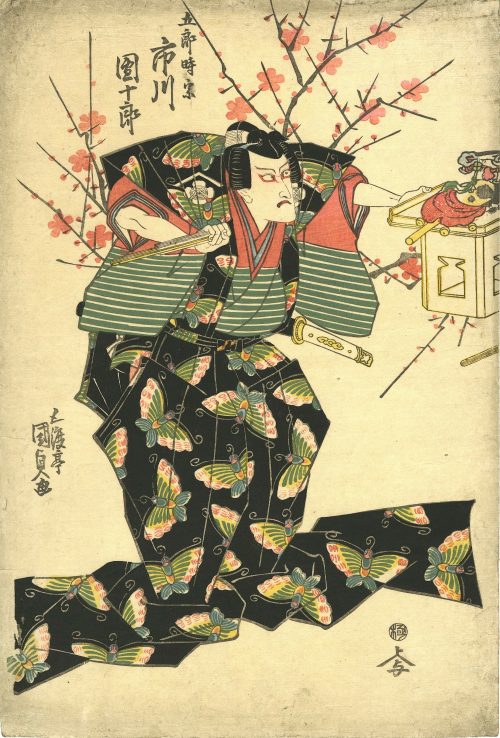 Actor Ichikawa Danjuro VII as Soga Goro Tokimune (one of the Soga brothers). Ichikawa Ebizô V held the name of Ichikawa Danjûrô VII from the 11th lunar month of 1800 to the 2nd lunar month of 1832. Artist: Utagawa Kunisada (Toyokuni III) [歌川 国貞] (Japanese, 1786 – 1865) Publisher: Uemura Yohei (Japanese, 1750 – 1832). Date: 1830 Size: Vertical ōban Signatures/Marks: Gototei Kunisada ga. Publisher's seal: Uemura Yohei. Censor's seal: Kiwame
Actor Ichikawa Danjuro VII as Soga Goro Tokimune (one of the Soga brothers). Ichikawa Ebizô V held the name of Ichikawa Danjûrô VII from the 11th lunar month of 1800 to the 2nd lunar month of 1832. Artist: Utagawa Kunisada (Toyokuni III) [歌川 国貞] (Japanese, 1786 – 1865) Publisher: Uemura Yohei (Japanese, 1750 – 1832). Date: 1830 Size: Vertical ōban Signatures/Marks: Gototei Kunisada ga. Publisher's seal: Uemura Yohei. Censor's seal: Kiwame -
 Uncut fan print (uchiwa-e) with the design of kabuki actor Nakamura Utaemon IV who held the name of Nakamura Shikan II from the 11th lunar month of 1825 to the 12th lunar month of 1835, dressed in a checkered kimono, holding a pipe and surrounded by flying fireflies. Character: Nakamura Utaemon IV [中村歌右衛門] (Japanese, 1796 – 1852); other names: Nakamura Shikan II, Nakamura Tsurusuke I, Nakamura Tōtarō. Series title: Catching fireflies in the floating world [浮世蛍狩] (Ukiyo hotarugari). Artist: Utagawa Kunisada [歌川 国貞], a.k.a. Toyokuni III (Japanese, 1786 – 1865). Signed: Kōchōrō Kunisada ga [香蝶楼国貞画] in a red cartouche. Publisher: Ibaya Kyubei [伊場屋 久兵衛] (Japanese, fl. 1804 – 1851); seal: modified Marks 19-009 | 126d. Censor's seal: Kiwame Date seal: Tenpō 2 (1831). Ref: Kunisada.de, N58. A look-alike yearlier Kunisada's design can be found at kunisada.de, ref. # N120-Z0172-410:
Uncut fan print (uchiwa-e) with the design of kabuki actor Nakamura Utaemon IV who held the name of Nakamura Shikan II from the 11th lunar month of 1825 to the 12th lunar month of 1835, dressed in a checkered kimono, holding a pipe and surrounded by flying fireflies. Character: Nakamura Utaemon IV [中村歌右衛門] (Japanese, 1796 – 1852); other names: Nakamura Shikan II, Nakamura Tsurusuke I, Nakamura Tōtarō. Series title: Catching fireflies in the floating world [浮世蛍狩] (Ukiyo hotarugari). Artist: Utagawa Kunisada [歌川 国貞], a.k.a. Toyokuni III (Japanese, 1786 – 1865). Signed: Kōchōrō Kunisada ga [香蝶楼国貞画] in a red cartouche. Publisher: Ibaya Kyubei [伊場屋 久兵衛] (Japanese, fl. 1804 – 1851); seal: modified Marks 19-009 | 126d. Censor's seal: Kiwame Date seal: Tenpō 2 (1831). Ref: Kunisada.de, N58. A look-alike yearlier Kunisada's design can be found at kunisada.de, ref. # N120-Z0172-410:
Actor Onoe Baikō, artist Kunisada, publisher Ibaya Kyūbei, c. 1820.
-
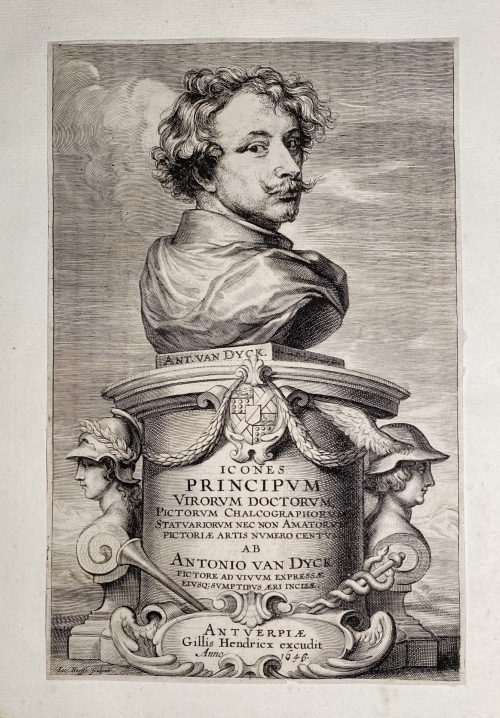 A book of sixty-eight copperplate engravings (burin and etching) by various artists after Anthony van Dyck, and one engraving by Lucas Vorsterman I, printed in black on laid paper, bound in full calf with a blind-stamped double-fillet ruling to the boards, spine with raised bands, gilt floral lozenges in compartments, gilt lettering "RECUE DE FIGUR", all margins sprinkled red, marbled end-papers. Engravers: Adriaen Lommelin (French engraver, 1637 – c. 1673) : 12 plates: №№ 3, 17, 18, 20, 21, 24, 25, 26, 28, 30, 35, and 48. Anthony van Dyck (Flemish, 1599 – 1641) : partially engraved himself 1 plate: № 53. Antoine Couchet (Flemish, 1630 – 1678) : 1 plate № 30. Conrad Waumans [Woumans] (Flemish engraver, 1619 – after 1675) : 6 plates: №№ 5, 32, 36, 57, 64, and 66. Cornelis Galle the Younger (Flemish engraver, 1615 – 1678) : 5 plates: №№ 2, 7, 10, 29, and 33. Hendrick Snyers (Flemish engraver, 1611 – 1644) : 1 plate: № 9. Jacob Neefs, or Neeffs (Flemish engraver, 1610 – after 1660): 4 plates: №№ 1, 16, 45, and 67. Johannes [Jan] Meyssens (Flemish engraver and publisher, 1612 – 1670) : engraved 6 plates: №№ 4, 22, 31, 51, 61, and 62. Lucas Vorsterman the Elder (Flemish engraver, 1595 – 1675) : engraved 7 plates: №№ 11, 15, 55, 58, 59, 65, and 69. Michael Natalis, or Noël (Flemish engraver, 1610 – 1668) : 1 plate: № 34 Paulus Pontius (Flemish engraver, 1603 – 1658) : 2 plates: №№ 37 and 52. Peeter Clouwet (Flemish engraver, 1629 – 1670) : 3 plates: №№ 13, 27, and 49. Peeter van Lisebetten (Flemish engraver, 1630 – 1678) : 1 plate: № 56. Pieter de Bailliu (Flemish engraver, 1613 – after 1660) : 4 plates: №№ 8, 14, 44, and 54. Pieter de Jode II (Flemish, 1606 – 1670/74) : 7 plates: №№ 12, 19, 23, 46, 47, 50, and 60. Richard Gaywood (British, fl. 1644 – 1668) : 1 plate: № 63. Robert van Voerst (Dutch, 1597 – 1636) : 1 plate: № 6. Schelte Adamsz. Bolswert (Flemish, c. 1586 – 1659) : 2 plates: №№ 18 and 68. Wenceslaus Hollar (Bohemian, 1607 – 1677) : 6 plates: №№ 38, 39, 40, 41, 42, and 43. Publishers: 36 prints were printed/published by Johannes [Jan] Meyssens (Flemish, 1612 – 1670) : (2), (4), (5), (7), (8), (9), (10), (12), (14), (22), (29), (31), (32), (33), (34), (36), (37), (39), (40), (41), (42), (43), (44), (45), (46), (51), (53), (54), (56), (57), (60), (61), (62), (64), (66), (67). Gillis Hendricx (fl. 1640 – 1677) published 11 prints, including the title page: (1), (13), (18), (26), (30), (47), (48), (50), (59), (65), (68). N. Burgund. Cons. Brab : (20); John Overton (British, 1639/40 – 1713) : (63); Hendrik van der Borcht II (Dutch, 1614 – c. 1690) : (38); Peter Stent (British, fl. c. 1637 – 1665) : (63). Description of plates:
A book of sixty-eight copperplate engravings (burin and etching) by various artists after Anthony van Dyck, and one engraving by Lucas Vorsterman I, printed in black on laid paper, bound in full calf with a blind-stamped double-fillet ruling to the boards, spine with raised bands, gilt floral lozenges in compartments, gilt lettering "RECUE DE FIGUR", all margins sprinkled red, marbled end-papers. Engravers: Adriaen Lommelin (French engraver, 1637 – c. 1673) : 12 plates: №№ 3, 17, 18, 20, 21, 24, 25, 26, 28, 30, 35, and 48. Anthony van Dyck (Flemish, 1599 – 1641) : partially engraved himself 1 plate: № 53. Antoine Couchet (Flemish, 1630 – 1678) : 1 plate № 30. Conrad Waumans [Woumans] (Flemish engraver, 1619 – after 1675) : 6 plates: №№ 5, 32, 36, 57, 64, and 66. Cornelis Galle the Younger (Flemish engraver, 1615 – 1678) : 5 plates: №№ 2, 7, 10, 29, and 33. Hendrick Snyers (Flemish engraver, 1611 – 1644) : 1 plate: № 9. Jacob Neefs, or Neeffs (Flemish engraver, 1610 – after 1660): 4 plates: №№ 1, 16, 45, and 67. Johannes [Jan] Meyssens (Flemish engraver and publisher, 1612 – 1670) : engraved 6 plates: №№ 4, 22, 31, 51, 61, and 62. Lucas Vorsterman the Elder (Flemish engraver, 1595 – 1675) : engraved 7 plates: №№ 11, 15, 55, 58, 59, 65, and 69. Michael Natalis, or Noël (Flemish engraver, 1610 – 1668) : 1 plate: № 34 Paulus Pontius (Flemish engraver, 1603 – 1658) : 2 plates: №№ 37 and 52. Peeter Clouwet (Flemish engraver, 1629 – 1670) : 3 plates: №№ 13, 27, and 49. Peeter van Lisebetten (Flemish engraver, 1630 – 1678) : 1 plate: № 56. Pieter de Bailliu (Flemish engraver, 1613 – after 1660) : 4 plates: №№ 8, 14, 44, and 54. Pieter de Jode II (Flemish, 1606 – 1670/74) : 7 plates: №№ 12, 19, 23, 46, 47, 50, and 60. Richard Gaywood (British, fl. 1644 – 1668) : 1 plate: № 63. Robert van Voerst (Dutch, 1597 – 1636) : 1 plate: № 6. Schelte Adamsz. Bolswert (Flemish, c. 1586 – 1659) : 2 plates: №№ 18 and 68. Wenceslaus Hollar (Bohemian, 1607 – 1677) : 6 plates: №№ 38, 39, 40, 41, 42, and 43. Publishers: 36 prints were printed/published by Johannes [Jan] Meyssens (Flemish, 1612 – 1670) : (2), (4), (5), (7), (8), (9), (10), (12), (14), (22), (29), (31), (32), (33), (34), (36), (37), (39), (40), (41), (42), (43), (44), (45), (46), (51), (53), (54), (56), (57), (60), (61), (62), (64), (66), (67). Gillis Hendricx (fl. 1640 – 1677) published 11 prints, including the title page: (1), (13), (18), (26), (30), (47), (48), (50), (59), (65), (68). N. Burgund. Cons. Brab : (20); John Overton (British, 1639/40 – 1713) : (63); Hendrik van der Borcht II (Dutch, 1614 – c. 1690) : (38); Peter Stent (British, fl. c. 1637 – 1665) : (63). Description of plates: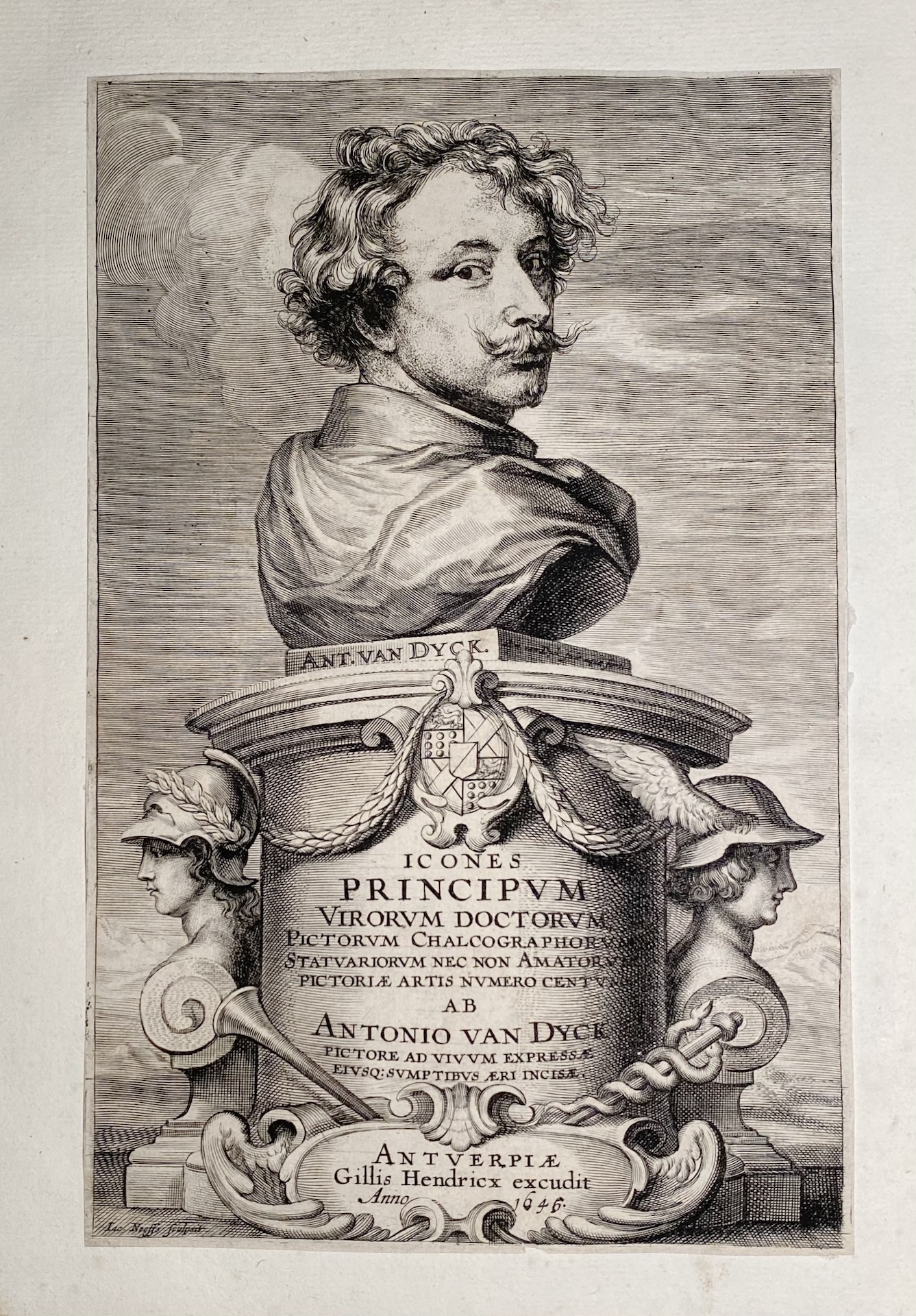
1. Engraved title page by Jacob Neeffs in 1646. On the slab supporting the bust, left: “ANT. VAN DYCK”, right: “Ant. van Dyck fecit aqua forti”. On the face of pedestal: “PRINCIPVM | VIRORVM DOCTORVM, | PICTORVM CHALCOGRAPHORVM, | STATVARIORVM NEC NON AMATORVM | PICTORIÆ ARTIS NVMERO CENTVM | AB | ANTONIO VAN DYCK, | PICTORE AD VIVVM EXPRESSÆ | EIVSQ: SVMPTIBVS ÆRI INCISÆ.” In cartouche: “ANTVERPIÆ | Gillis Hendricx excudit | Anno 1645” (corrected by hand “1646”). At lower left margin: “Iac. Neeffs Sculpsit.” The print with cut off margins pasted to the bound-in leaf. Size of the print: 24.3 x 15.8 cm. 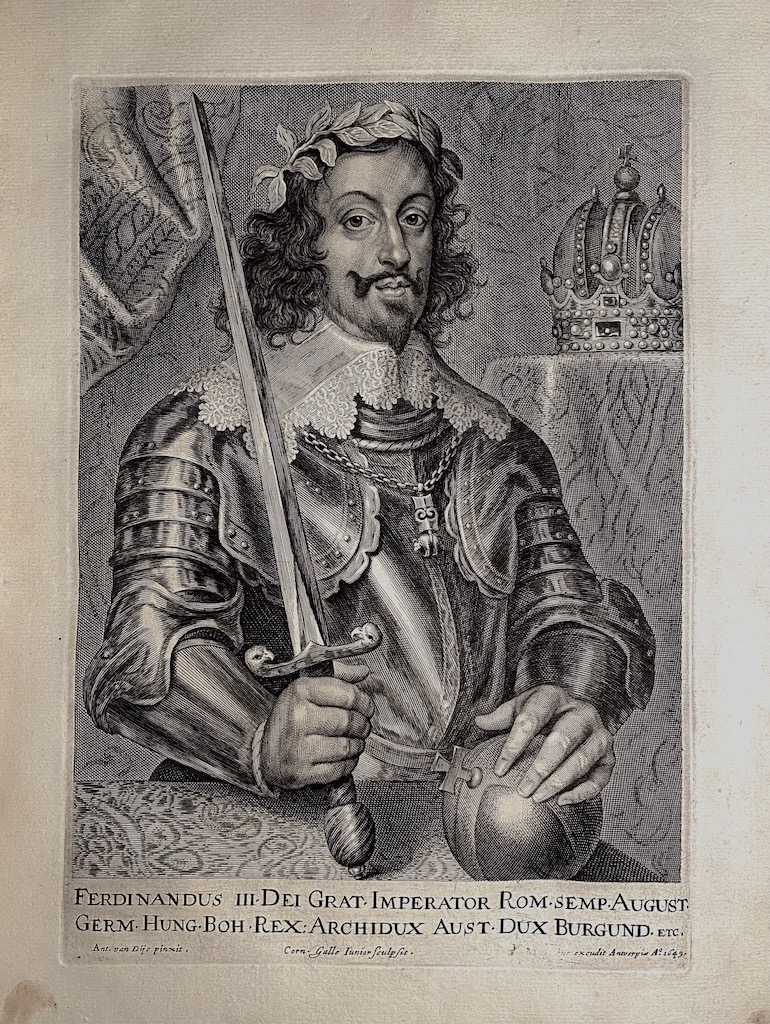
2. Ferdinand III, Holy Roman Emperor and King of Hungary and Bohemia (1608 – 1657); engraved by Cornelis Galle the Younger (Flemish, 1615–1678) in 1649. Inscription: “FERDINANDUS III. DEI GRAT. IMPERATOR ROM.SEMP.AUGUST. | GERM. HUNG. BOH. REX: ARCHIDICUX AU ST. DUX BURGUND. ETC.”. Below: “Ant. van Dÿc pinxit” <–> “Corn. Galle Iunior sculp∫it.”<–> “…excudit Antuerpiæ A.o 1649”. Second state with Meyssens’ name burnished. 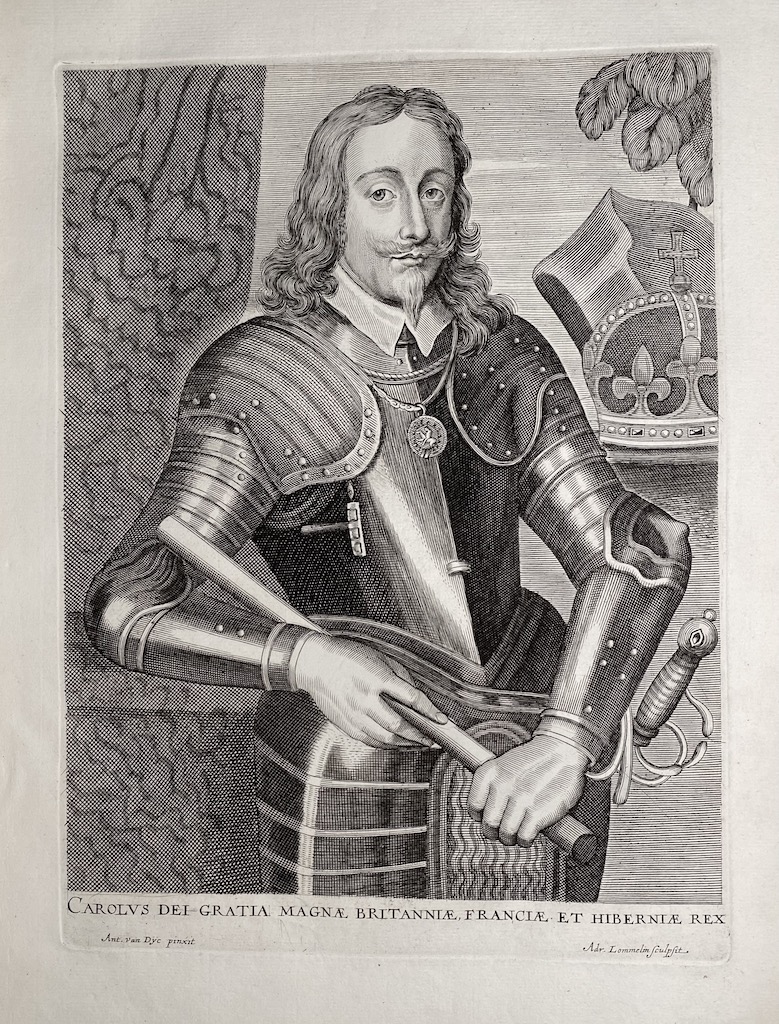
3. Charles I, King of England, Scotland, and Ireland (British, 1600 – 1649); engraved by Adriaen Lommelin (French, 1637 – c. 1673). Inscription: “CAROLVS DEI GRATIA MAGNÆ BRITANNIÆ, FRANCIÆ ET HIBERNIÆ REX”. Below: “Ant. van Dÿc pinxit” <–> “Adr. Lommelin sculpsit”. 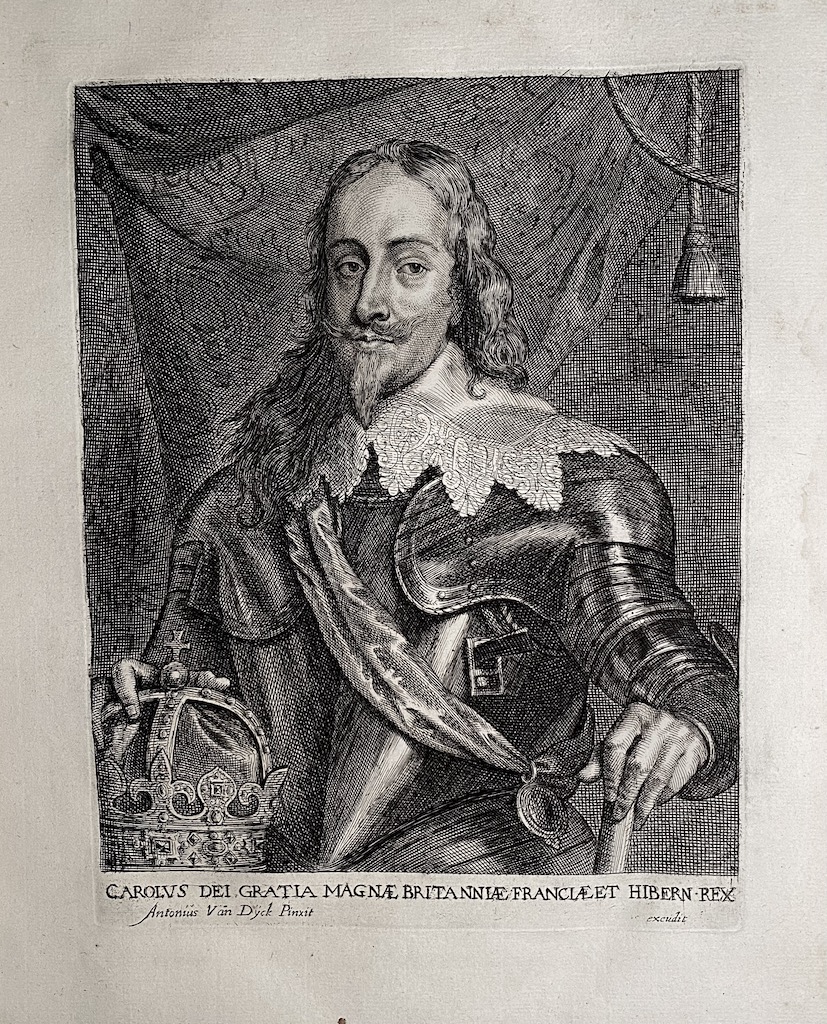
4. Charles I, King of England, Scotland, and Ireland (British, 1600 – 1649); engraved by Johannes [Jan] Meyssens (Flemish, 1612 – 1670). Inscription: “CAROLVS DEI GRATIA MAGNÆ BRITANNIÆ, FRANCIÆ ET HIBERNIÆ REX”. Below: Antonius Van Dÿck eques pinxit” <–> “...excudit”. Meyssens’ name burnished. [See similar print №61 with Ioannes Meysens name present]. 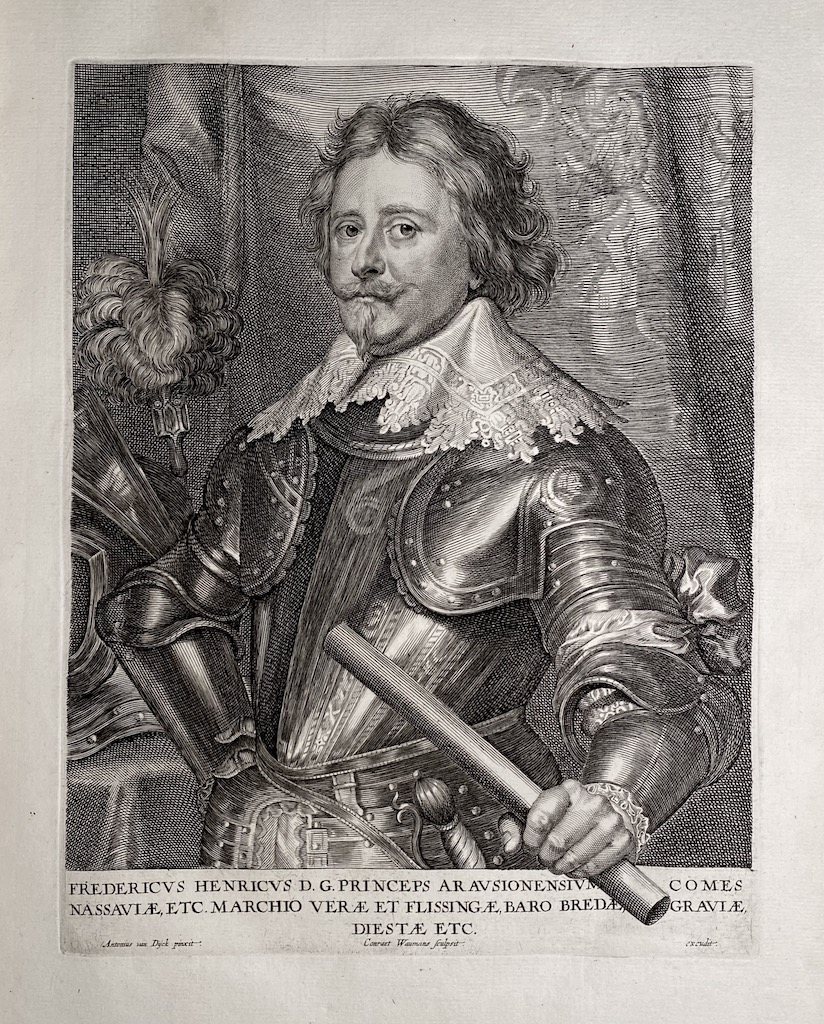
5. Frederick Henry, Prince of Orange, Count of Nassau (Dutch, 1584 – 1647); engraved by Conrad Waumans [Woumans] (Flemish, 1619 – after 1675). Inscription: “FREDERICVS HENRICVS, D.G. PRINCEPS ARAVSIONENSIVM, COMES | NASSAVIÆ, ETC. | MARCHIO VERÆ ET FLISSINGÆ, BARO BREDÆ GRAVÆ, | DIESTÆ ETC.” Below: “Antonius van Dÿck pinxit” <–> “Conraet Waumans sculpsit” <–> “…excudit”. Meyssens’ name burnished. [Similar to №57, but with Ioannes Meyssens name in place]. 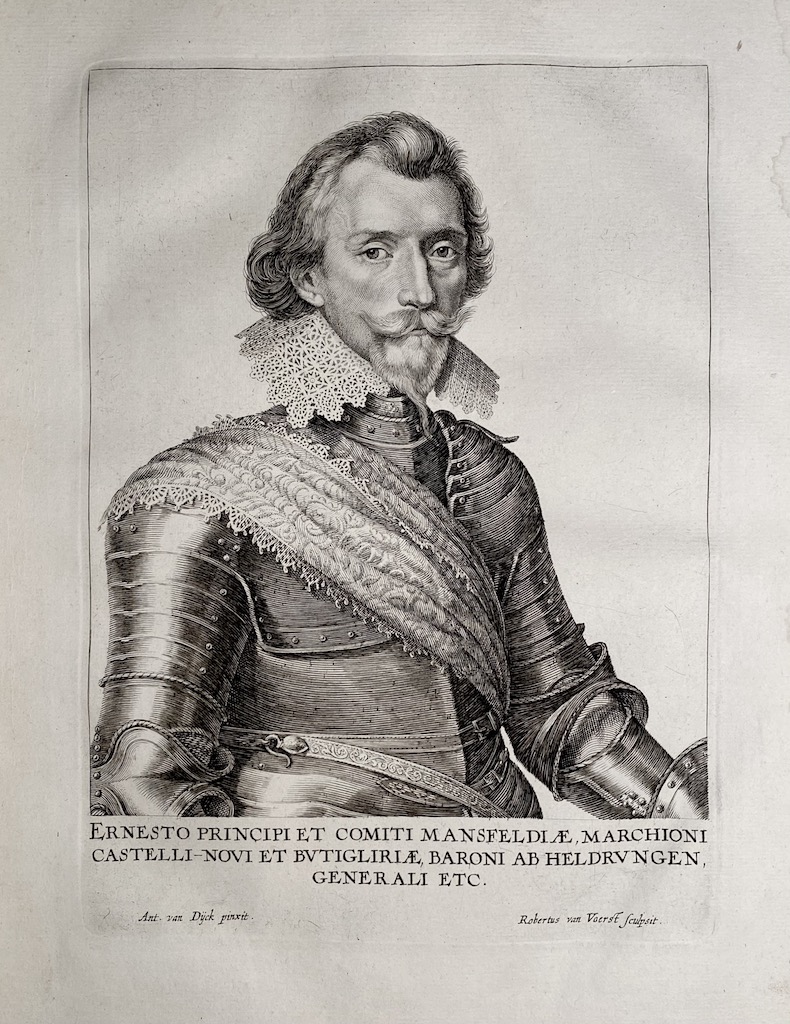
6. Count Ernst von Mansfield (German, 1580 – 1626); engraved by Robert van Voerst (Dutch, 1597 – 1636). Inscription: “ERNESTO PRINCIPI ET COMITI MANSFELDIÆ, MARCHIONI | CASTELLI-NOVI ET BUTIGLIRIÆ, BARONI AB HELDRUNGEN, GENERALI ETC.” Below “Ant. Van Dÿck pinxit” <–> “Robertus van Voerst Sculpsit”. 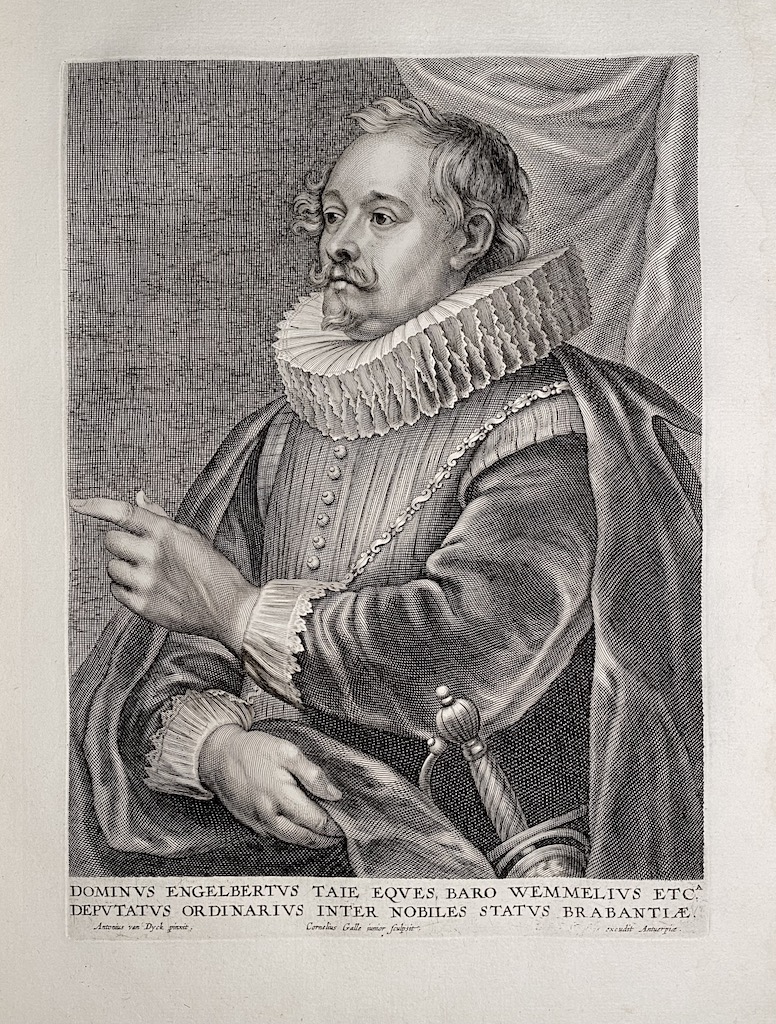
7. Engelbert Taye, Baron of Wemmel (Flemish, ? – 1638); engraved by Cornelis Galle the Younger. “DOMINVS ENGELBERTVS TAIE EQVES, BARO WEMMELIVS ETC.A | DEPVTATVS ORDINARIVS INTER NOBILES STATVS BRABANTIÆ.”. Below: “Antonius van Dyck pinxit”, “Cornelius Galle iunior ∫culpsit” <–> “…excudit Antuerpiæ.”. Second state, with “Ioannes Meyssens” erased. 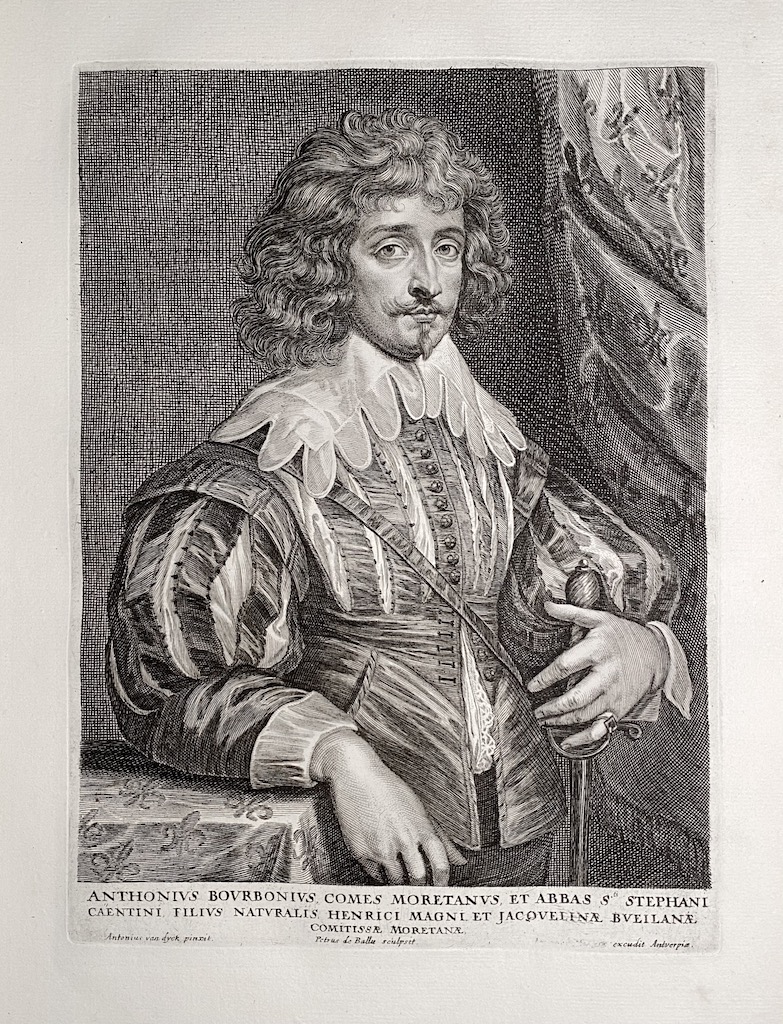
8. Antoine de Bourbon, comte de Moret (French, 1607 – 1632); engraved by Pieter de Bailliu (Flemish, 1613 – after 1660). Inscription: “ATHONIVS BOVRBONIVS, COMES MORETANVS, ET ABBAS S.TI STEPHANI | CAENTINI, FILIVS NATVRALIS, HENRICI MAGNI ET JACQVELINÆ BVEILANÆ | COMITISSÆ MORETANÆ,”. Below: “Antonius van dyck pinxit.” <–> “Petrus de Ballu sculpsit.” <–>“… excudit Antverpiæ.”. Second state with “Ioannes Meyssens” erased. Antoine de Bourbon was the illegitimate son of Henri IV, Roi de France and Jacqueline de Bueil, Comtesse de Moret. 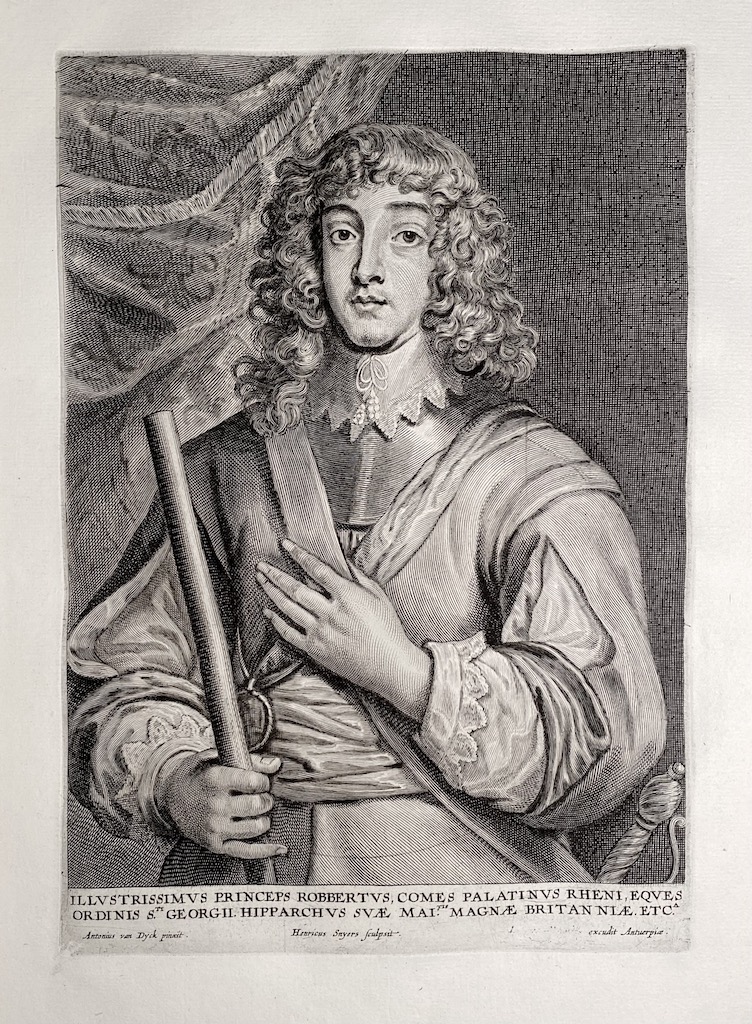
9. Prince Rupert of the Rhine (German, Bohemian, 1619 –1682); engraved by Hendrick Snyers (Flemish, 1611 – 1644). Inscription: “ILLVSTRISSIMVS PRINCEPS ROBBERTVS, COMES PALATINVS RHENI, EQVES | ORDINIS S.TI GEORGII. HIPPARCHVS SVÆ MAI.TIS MAGNÆ BRITANNIÆ. ETC.A”. Below: “Antonius van Dyck pinxit” <–> “Henricus Snyers sculpsit” <–> “...excudit Antuerpiæ.”. Second state with “Ioannes Meyssens” erased. 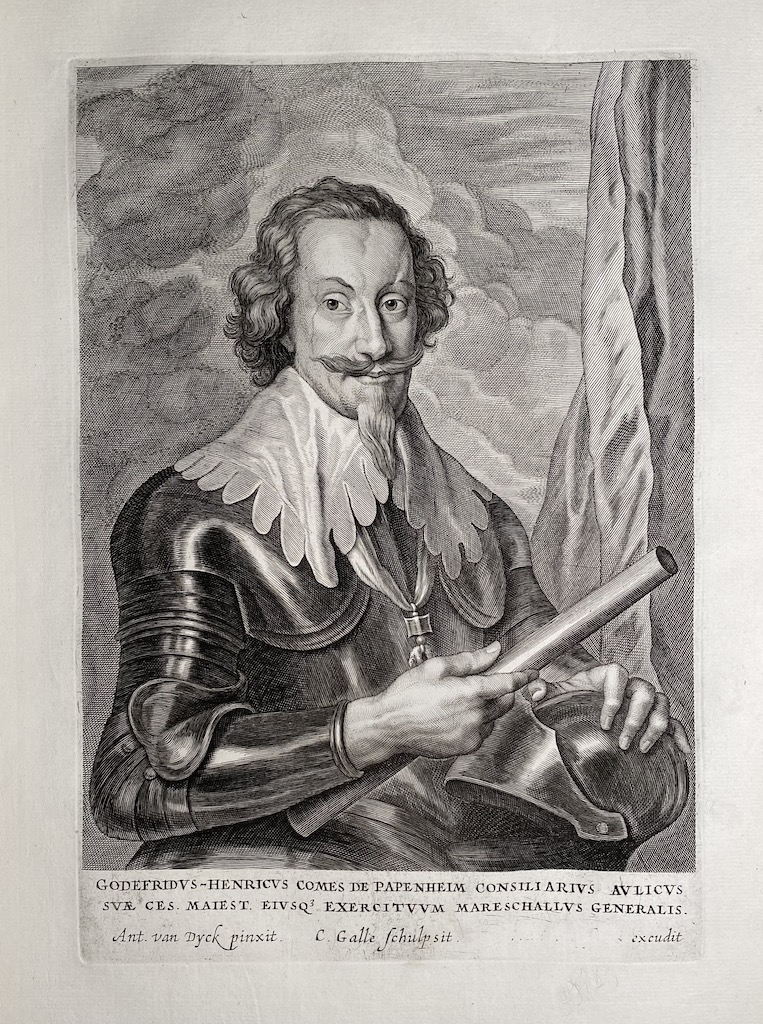
10. Gottfried-Heinrich, Count of Pappenheim; engraved by Cornelis Galle the Younger. Inscription: “GODEFRIDVS-HENRICVS COMES DE PAPENHEIM CONSILIARIVS AVLICVS | SVÆ CES. MAIES. EIVSQ³ EXERCITVVM MARESCHALLVS GENERALIS.” Lettered with production details below: “Ant. van Dyck pinxit” <–> “C. Galle ∫chulpsit.” <–> “…excudit”. Second state with “Ioan. Meyßens” erased. 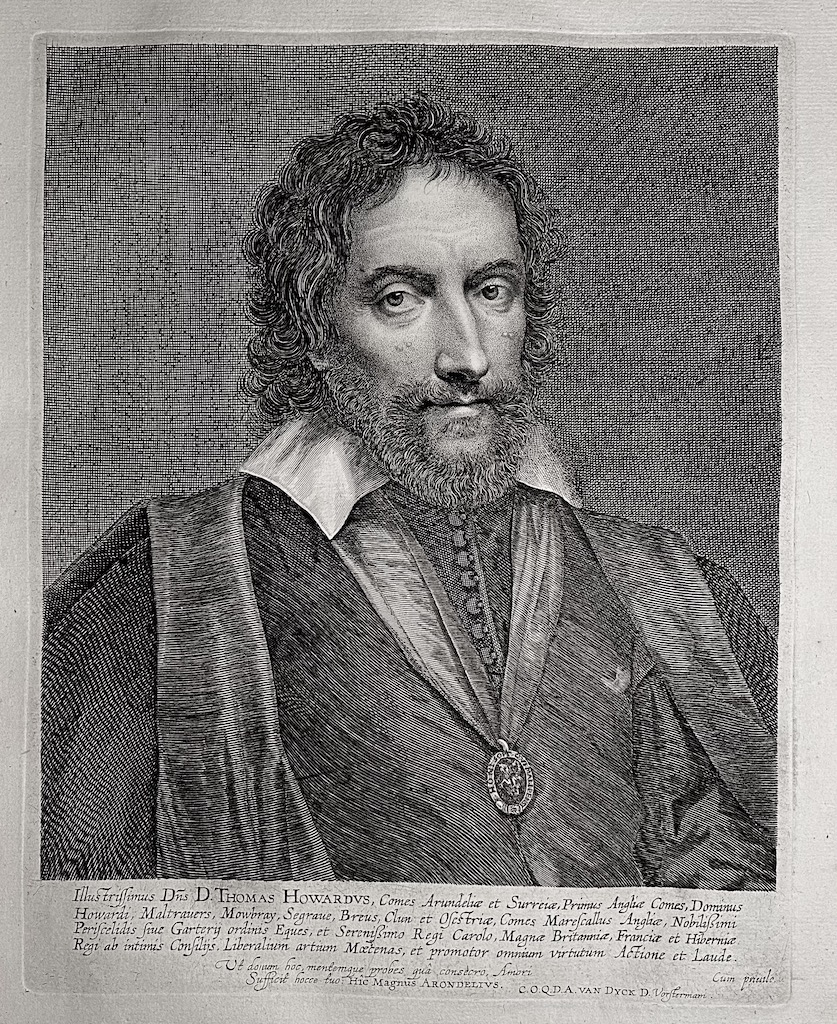
11. Thomas Howard, 14th Earl of Arundel (British, 1585 – 1646); engraved by Lucas Vorsterman the Elder (1595–1675). Inscription: “Illustri∫∫imus Dñs. D.Thomas Howardvs, Comes Arundeliæ et Surreiæ, Primus Angliæ Comes, Dominus | Howardi, Maltrauers, Mowbray, Segraue, Breus, Clun et O∫estriæ, Comes Mare∫callus Angliæ, Nobilißimi | Pericelidis ∫iue Garterij ordinis Eques, et Serenißimo Regi Carolo, Magnæ Britaniæ, Franciæ et Hiberniæ | Regi ab intimis Consilijs, Liberalium artium Mæcenas, et promotor omnion virtutum Actione et Laude.”. Below: “Ut donum hoc, mantenque probes qua consecro, Amori | Sufficit hocci tuo: Hic Magnvs ARONDELIVS”, “C.O.Q.D.A. VAN DYCK D. Vor∫termani.”, “Cum priuile.”. Third state with ‘Opera Vorstermanni’ burnished and two lines of Latin added below the four lines of the title. 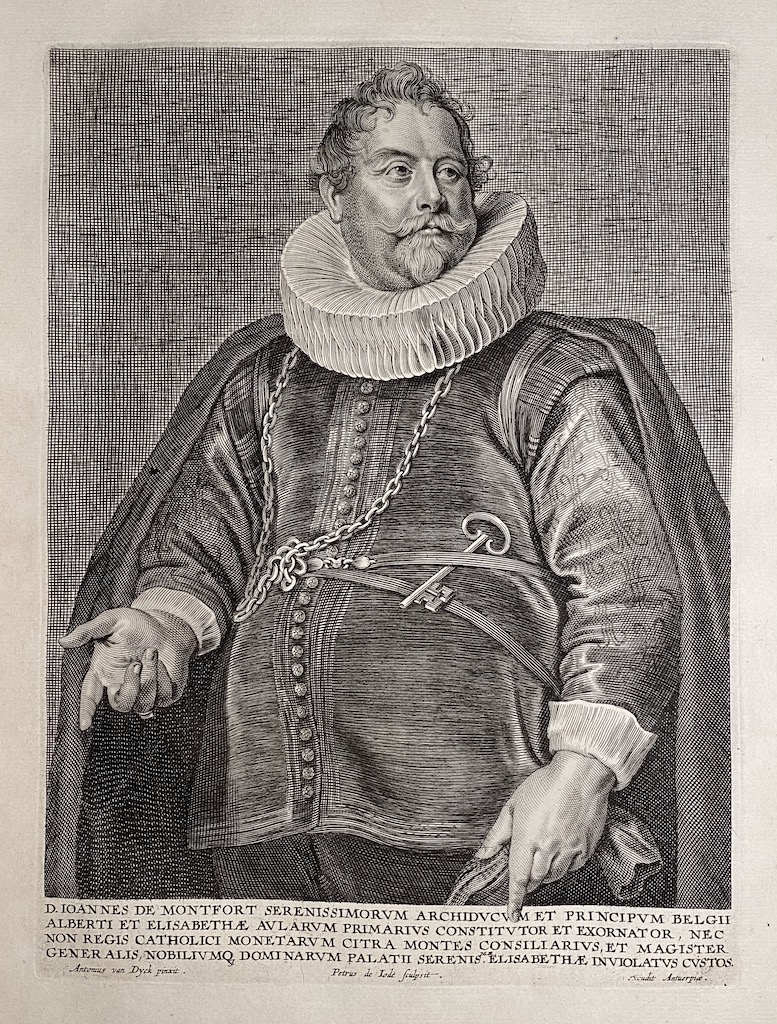
12. Jan van Montfort [Jean de Montfort] (Flemish, 1567 – 1648); engraved by Pieter de Jode II (Flemish, 1606 – 1670/74). Inscription: “D. IOANNES DE MONTFORT SERENISSIMORVM ARCHIDVCVM ET PRINCIPVM BELGII | ALBERTI ET ELISABETHÆ AVLARVM PRIMARIVS CONSTITVTOR ET EXORNATOR, NEC | NON REGIS CATHOLICI MONETARVM CITRA MONTES CONSILIARIVS, ET MAGISTER. | GENERALIS, NOBILIVMQ3 DOMINARVM PALATII SERENIS.MÆ ELISABETHÆ INVIOLATVS CVSTOS.” Below: “Antonius van Dyck pinxit.” <–> “Petrus de Iode sculpsit.” <–> “…excudit Antuerpiæ”. Second state with “Ioannes Meyssens” erased. 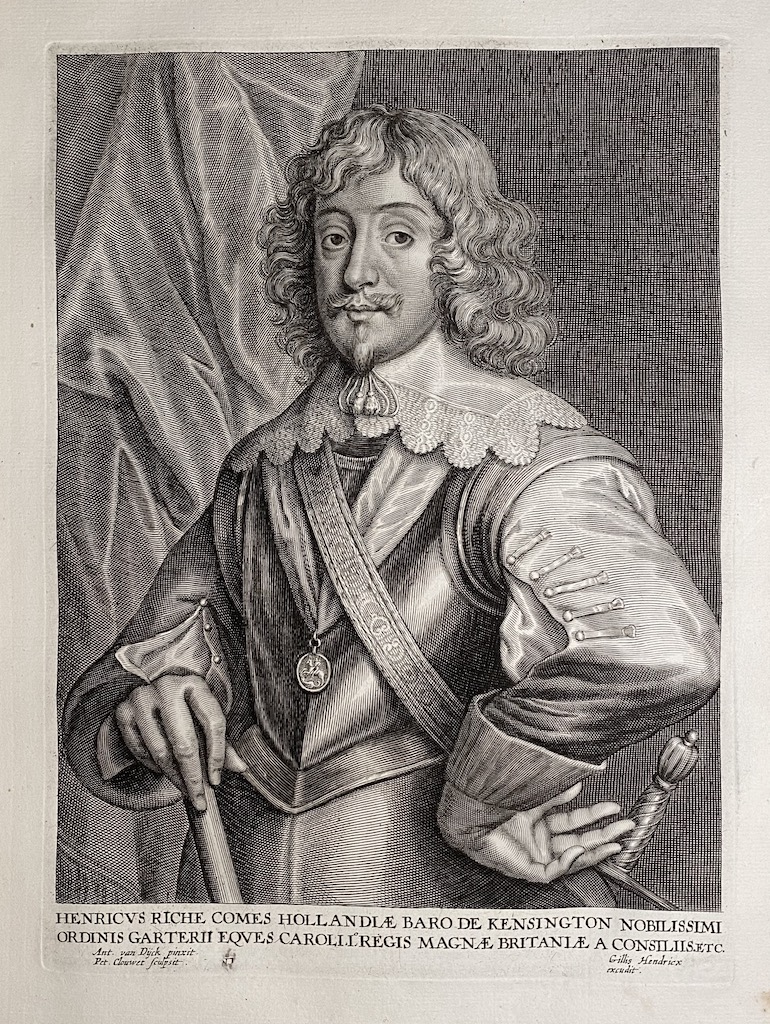
13. Henry Rich, 1st Earl of Holland (British, 1590 – 1649), engraved by Pieter Clouwet (Flemish, 1629 – 1670). Inscription: “HENRICVS RICHE COMES HOLLANDIÆ BARO DE KENSINGTON NOBILISSIMI | ORDINIS GARTERII EQVES CAROLI. LOREGIS MAGNÆ BRITANIÆ A CONSILIIS. ETC.”. Below: “Ant. van Dÿck pinxit.” | “Pet. Clouwet sculpsit” <–> “Gillis Hendricx | excudit”. Third state with the title added and production details re-engraved. 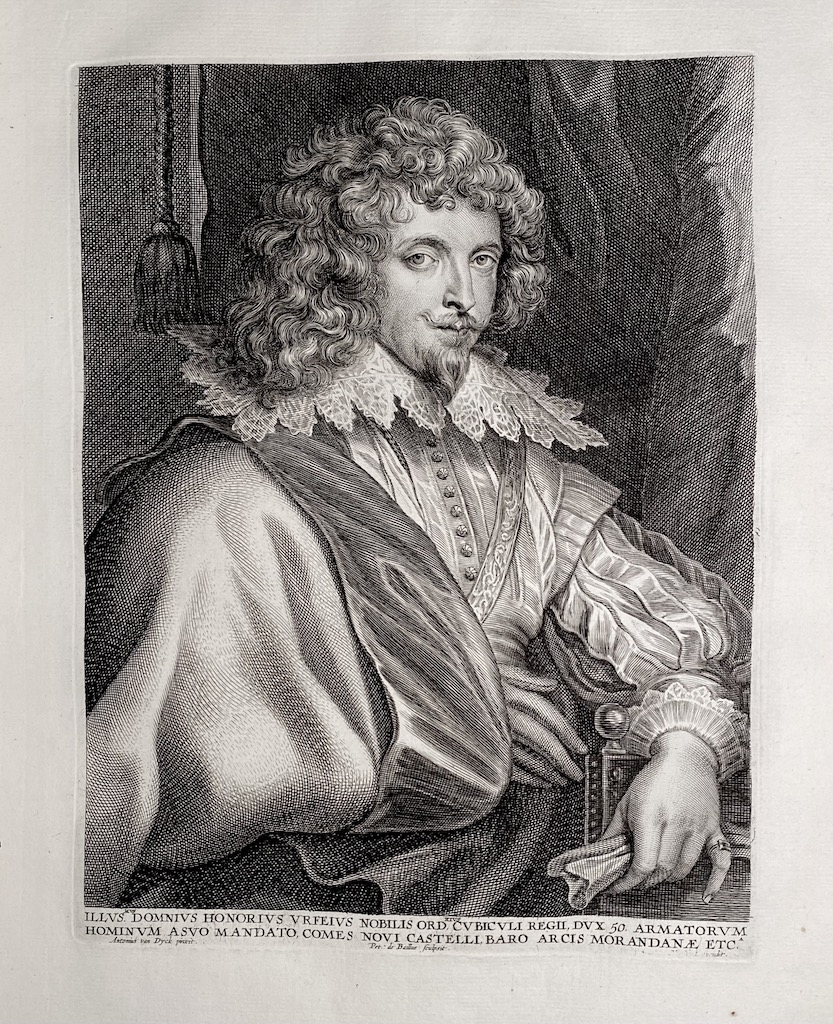
14. Honoré d’Urfé, marquis de Valromey, comte de Châteauneuf (French, 1568 – 1625); engraved by Pieter de Bailliu (Flemish, 1613 – 1660). Inscription: “ILLVS.MVS DOMNIVS HONORIVS VRFEIVS NOBILIS ORD.RIVS CVBICVLI REGII, DVX 50. ARMATORVM | HOMINVM A SVO MANDATO, COMES NOVI CASTELLI, BARO ARCIS MORANDANÆ ETC.A”. Below: “Antonius van Dyck pinxit” <–> “Pet. de Bailliue sculpsit.” <–> “… excudit”. Second lettered state with title and production details, with “Ioannes Meyssens” erased. [There is another copy in this binding, №54, where Ioannes Meysens' name is in place]. 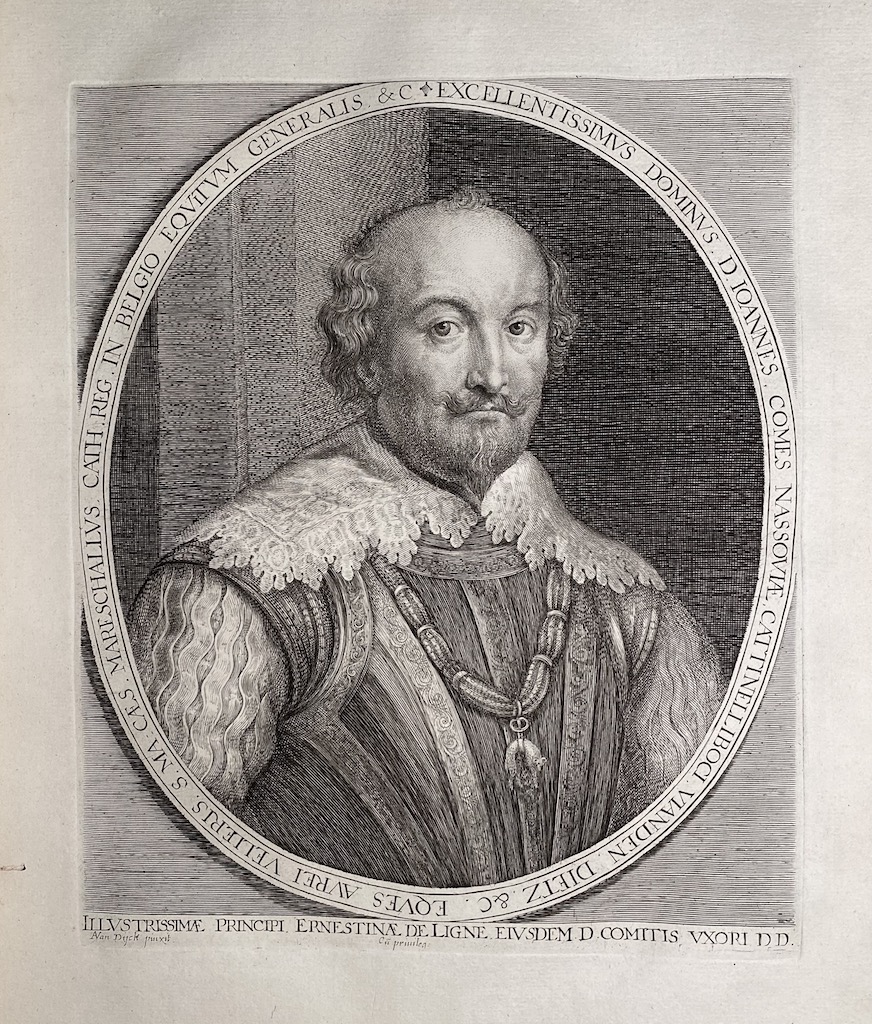
15. Johannes [John VIII], Count of Nassau-Siegen (German, 1583 – 1638); engraved by Lucas Vorsterman I (Flemish, 1595 – 1675). Inscription: in the oval around the portrait “EXCELLENTISSIMVS DOMINVS: D. IOANNES, COMES NASSAOVIÆ, CATTNELLIBOCI: VIANDEN, DIETZ, &C. EQVES AVREI VELLERIS. S. MA: CÆS, MARESCHALIVS, CATH. REG. IN BELGIO. EQVITVM GENERALIS. &C”, in lower margin: “ILLVSTRISSIMÆ PRINCIPI ERNESTINÆ DE LIGNE EIVSDEM D. COMITIS VXORI DD.”, and “AVan Dÿck pinxit.” <–> “Cu Priuleg”. Fourth state with Vorsterman’s address burnished. [For the third state with “Lucas Vorsterman exc” present see № 55]. 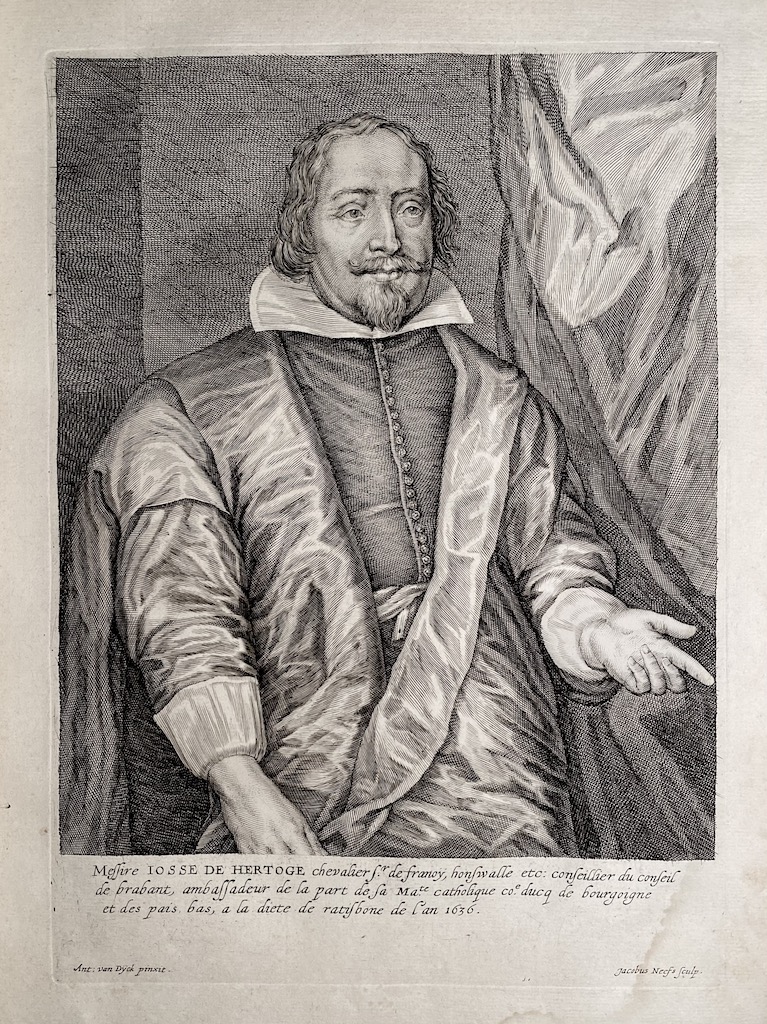
16. Joost de Hertoghe (Flemish, ? –1638); engraved by Jacobus Neefs. Inscription: "Me∫∫ire IOSSE DE HERTOGE chevalier ∫.r de franoÿ, hon∫walle etc: con∫eillier du conseil | de brabant, amba∫∫adeur de la part de ∫a Ma.te catholique co.e ducq de bourgoigne | et des pais bas, a la diete de rati∫bone de l'an 1636." In Lower margine: "Ant: van Dÿck pinxit.", <–>"Jacobus Neefs ∫culp.". Second, lettered state with the title and production details added. 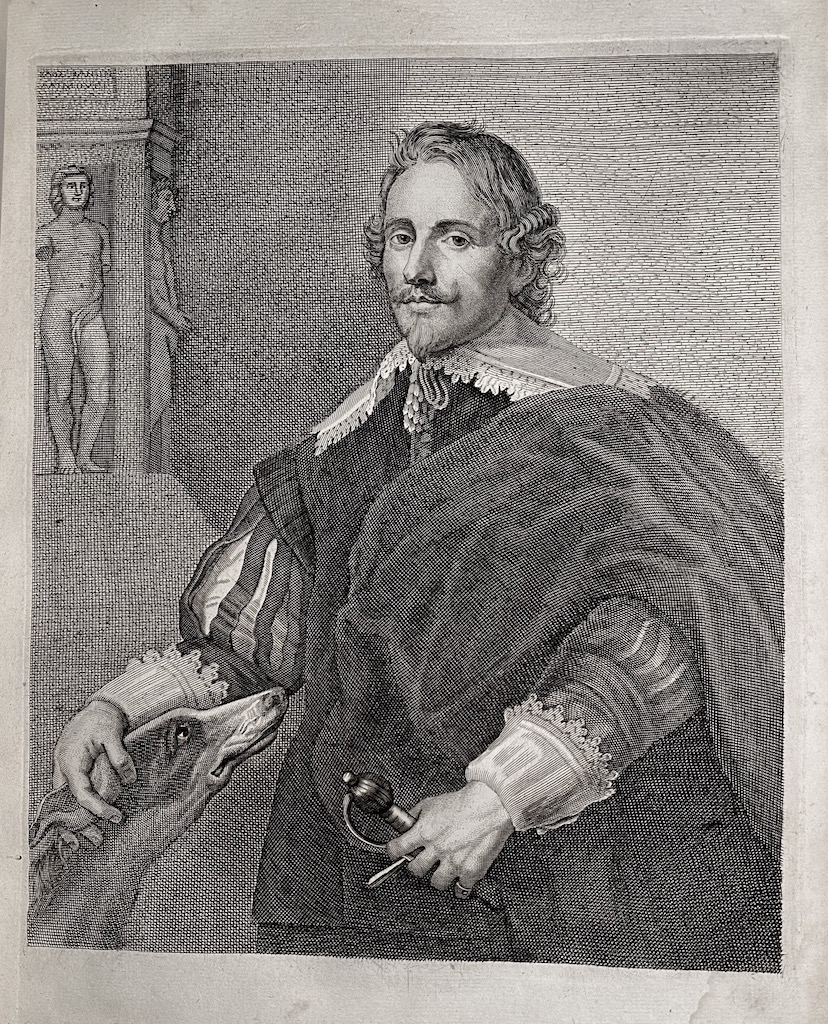
17. Philippe Le Roy (Flemish, 1596 – 1679). No inscription. The printmaker is unidentified but is possibly Adriaen Lommelin. The print is a copy of the print by Vorsterman and Pontius. 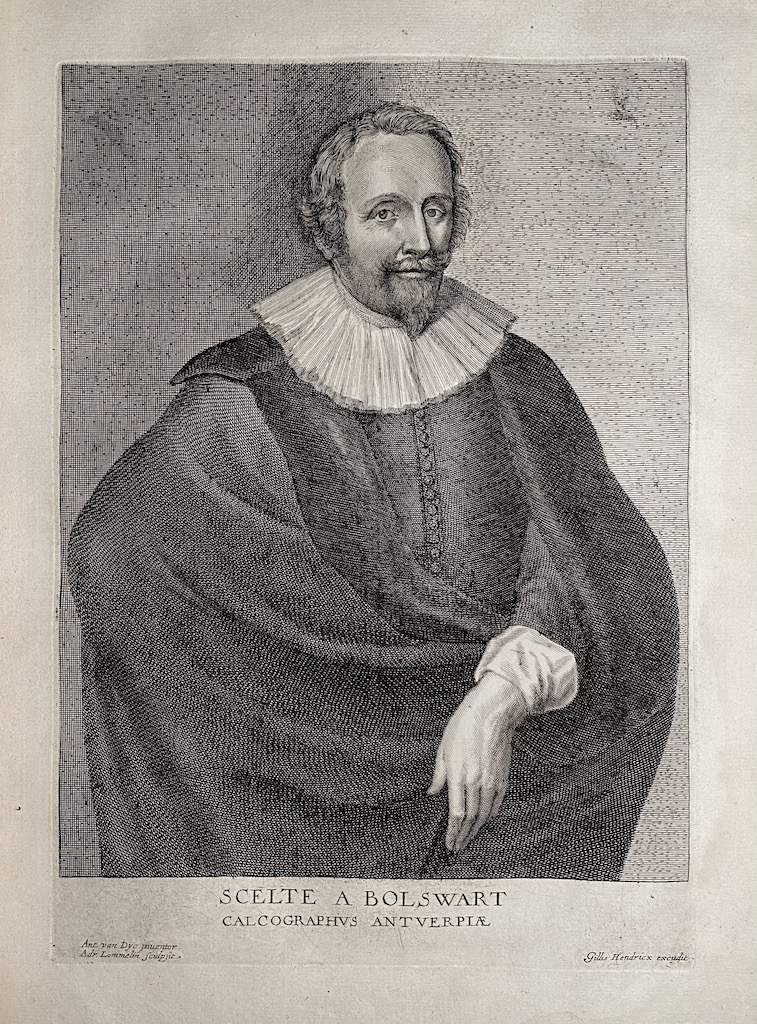
18. Schelte Adamsz. Bolswert (Flemish, c. 1586 – 1659); engraved by Adriaen Lommelin, published by Gillis Hendricx. Inscription: “SCELTE A BOLSWART | CALCOGRAPHVS ANTVERPIÆ”. In lower margin: “Ant. van Dÿc inuentor | Adr. Lommelin sculpsit” <–> “Gillis Hendricx excudit”. Third state with an entirely different head, title and production details added. 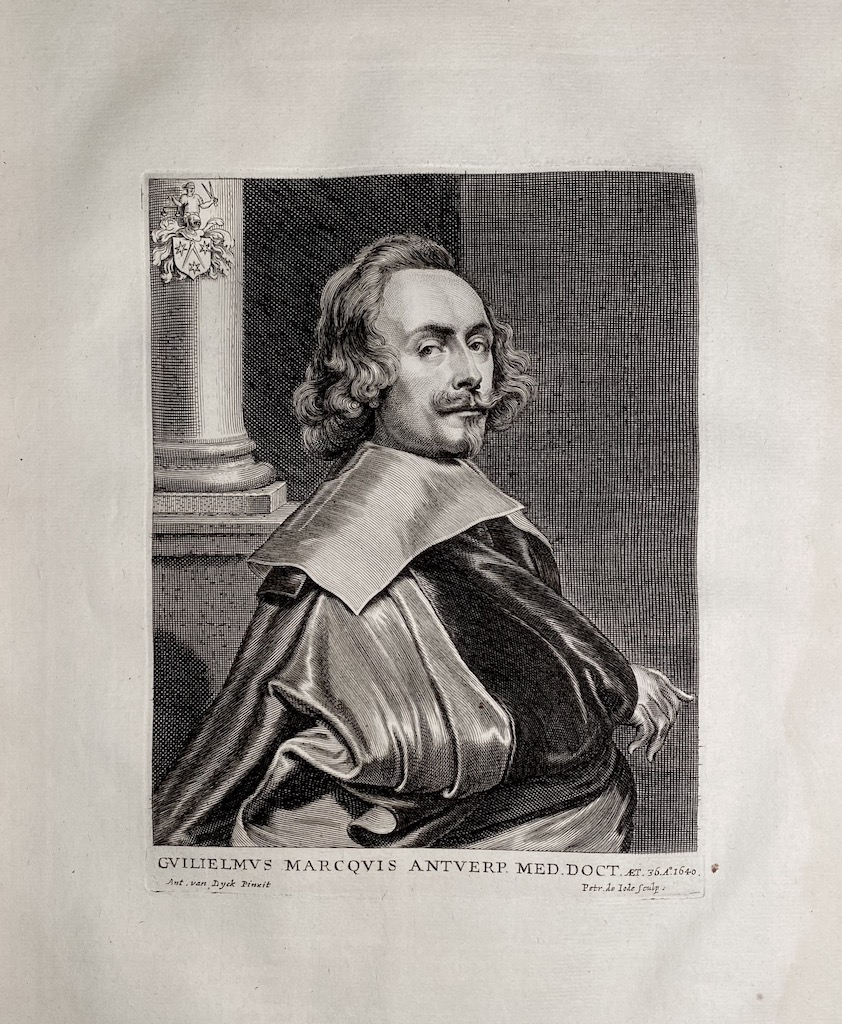
19. Willem Marquis (Flemish, 1604 – 1640); engraved by Pieter de Jode II. Inscription: “GVILIELMVS MARCQUIS ANTVERP. MED. DOCT. ÆT. 36.A.O 1640.” In lower margin: “Ant. van Dyck Pinxit” <–> “Petr. de Iode sculp.”. Second, lettered state with Borreken’s name burnished and replaced by Van Dyck’s. 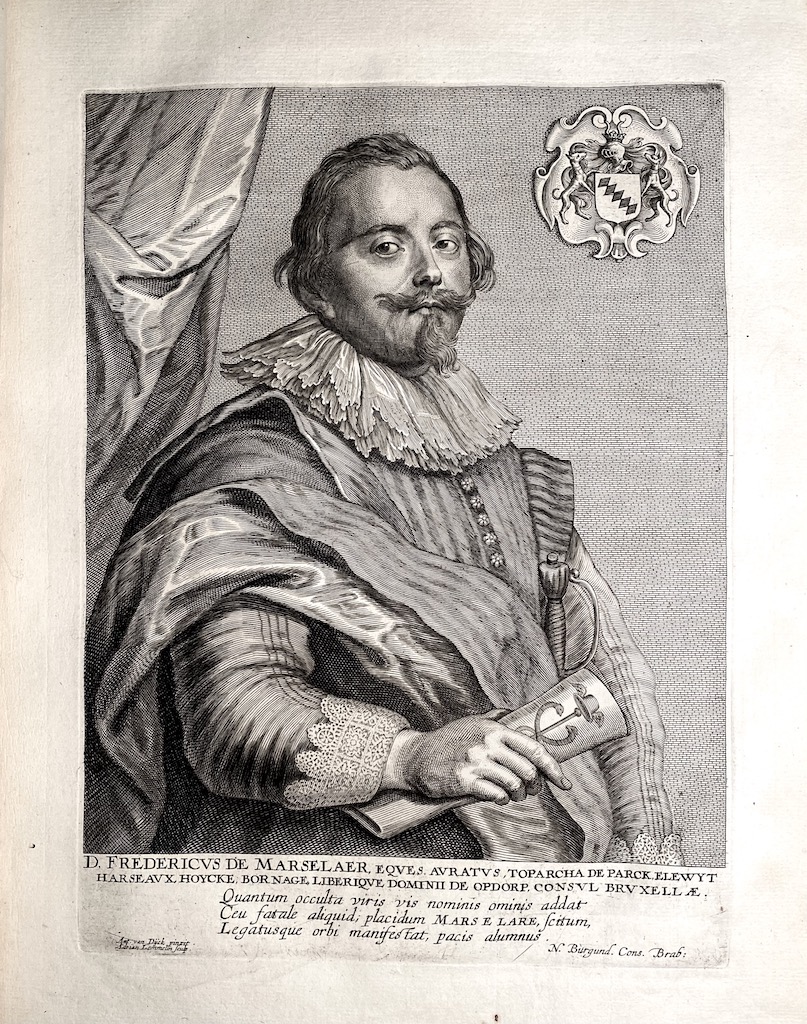
20. Frederik de Marselaer (Flemish, 1584 – 1670); engraved by Adriaen Lommelin. Inscription: “D. FREDERICVS DE MARSELAER, EQVES AVRATVS, TOPARCHA DE PARCK, ELEWYT | HARSEAVX, HOYCKE, BORNAGE, LIBERIQUE DOMINII DE OPDORP, CONSVL BRVXELLÆ.” Three lines of verse below: “Quantum occulta viris vis nominis ominis addat | Ceu fatale aliuid; placidum Mars E Lare, scitum, | Legatusue orbi manifestat, pacis alumnus.”. In lower margin: “Ant. van Dÿck pinxit | Adrian Lommelin sculpsit” <–> “N. Burgund. Cons. Brab:”. Third state with the roll of paper rounded. 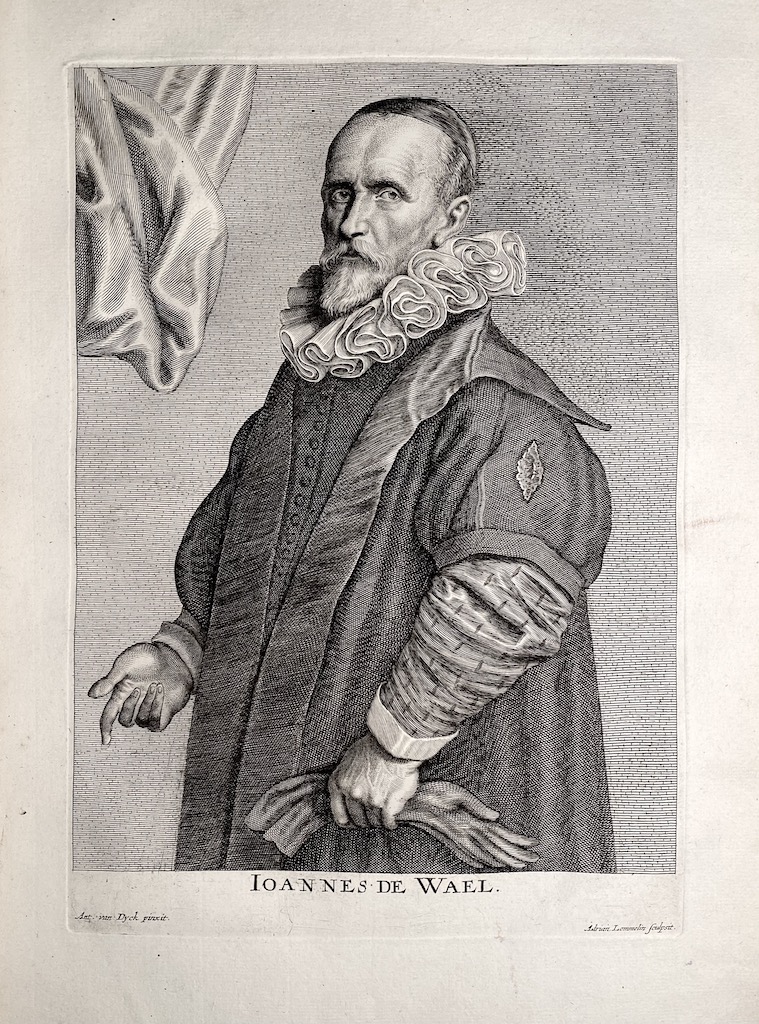
21. Jan Baptist de Wael I (Flemish, 1558 – 1633); engraved by Adriaen Lommelin. Inscription: “IOANNES DE WAEL.”. In lower margin: “Ant. van Dyck pinxit.”<–> and “Adrian Lommelin sculpsit.”. Second, lettered state with the title and production details. British Museum № 1872,1012.4168. 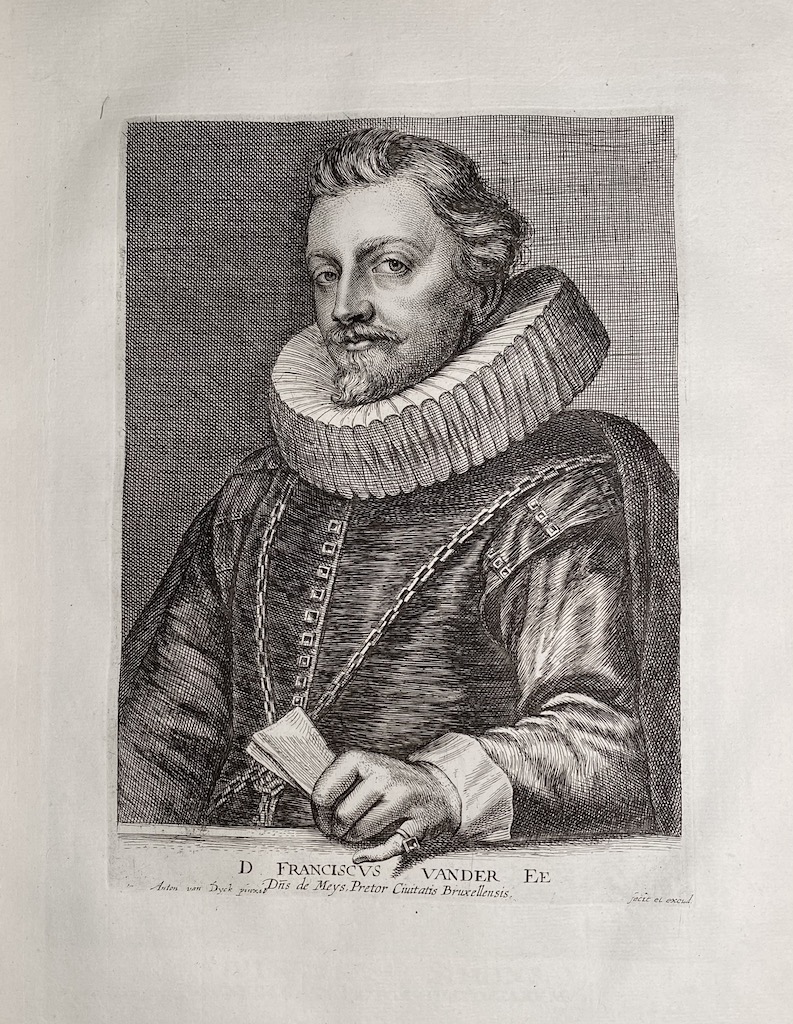
22. François van der Ee (Flemish, ? – 1645); engraved and published by Johannes Meyssens. Inscription: “D . FRANCISCVS VANDER EE | Dñs de Meys, Pretor Ciuitatis Bruxellensis”. In lower margin: “Anton van Dyck pinxit”, and “fecit et excud.”. Fourth, lettered state, finished with the burin, with second line added to the title, with address “Ioannes Meyssens” almost completely burnished. 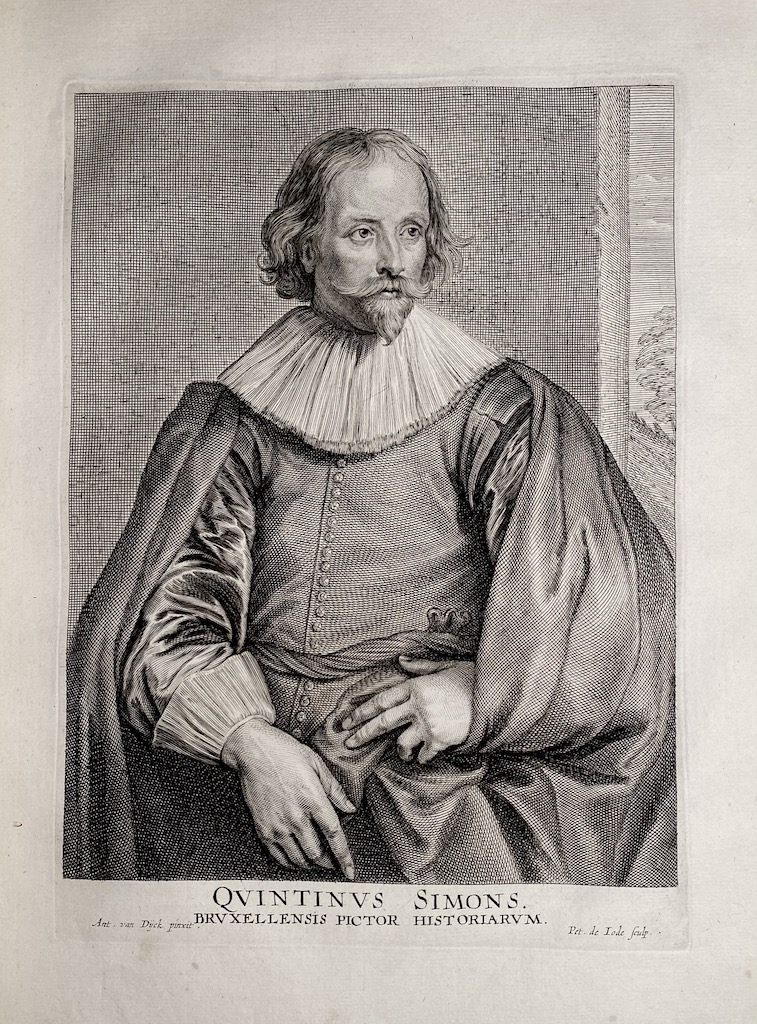
23. Quintijn Simons (Flemish, 1592 – after 1634); engraved by Pieter de Jode II. Inscription: “QVINTINVS SIMONIS. | BRVXELLENSIS PICTOR HISTORIARVM.”. In lower margin: “Ant. van Dijck pinxit.” <–> “Pet. de Iode sculp.”. Third state with second line of title added. 
24. Adriaan Stevens (Flemish, 1561 – 1640); engraved by Adriaen Lommelin. Inscription: "INTEGERRIMVS VIR ADRIANVS STEVENS / S.P.Q. ANTVERP. AB ELEMOSYNIS.". In lower margin:"Ant van Dÿc pinxit." <–> "A. Lommelin sculp.". British Museum # R,1b.20. 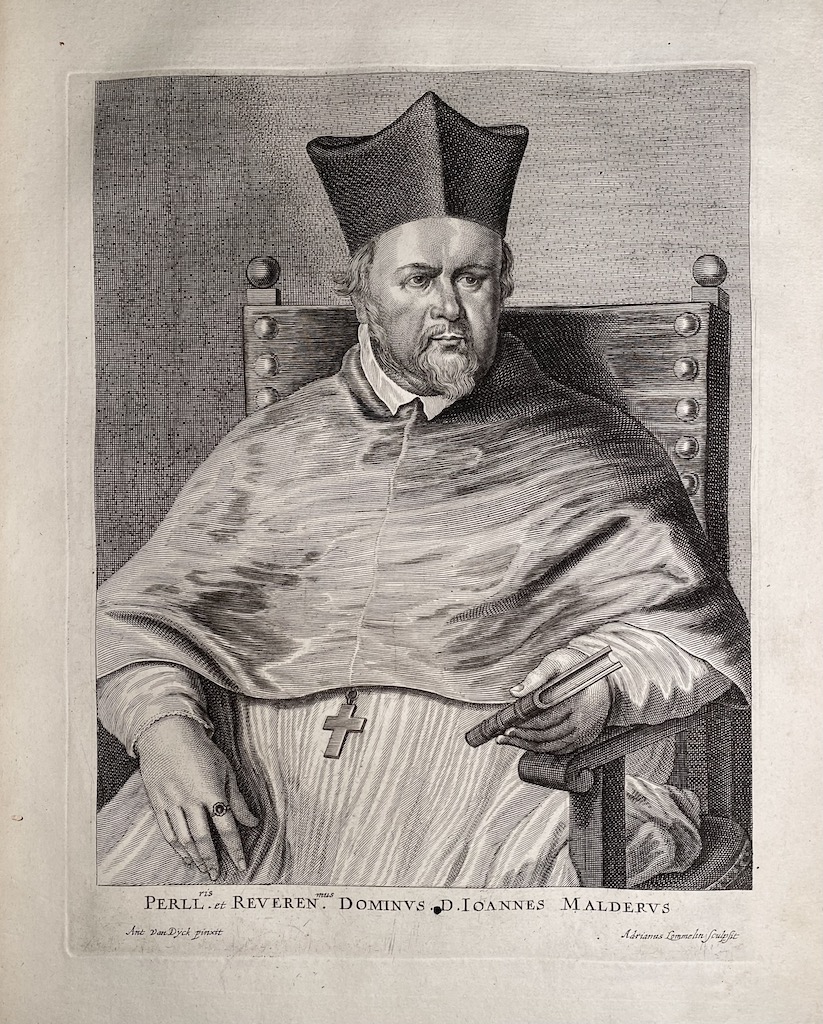
25. Jan van Malderus (Flemish, 1563 – 1633); engraved by Adriaen Lommelin. Inscription: “PERLL.ris et REVEREN.mus DOMINVS. D. IOANNES MALDERVS”. In lower margin: “Ant Van Dÿck pinxit” <–> “Adrianus Lommelin sculpsit”. 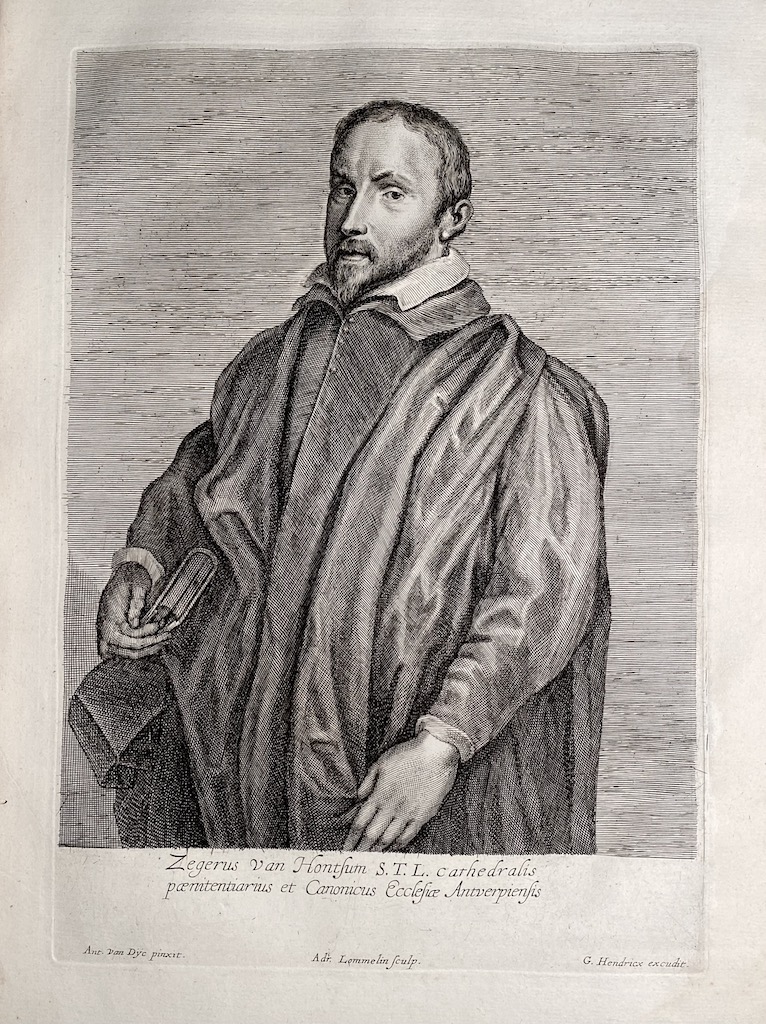
26. Zeger van Hontsum (Flemish, ? – -1643). Engraved by Adriaen Lommelin, published by Gillis Hendricx. Inscription: “Zegerus van Hontsum S.T.L. cathedralis | pænitentiarius et Canonicus Ecclesiæ Antuerpiensis”. In lower margin: “Ant. van Dÿc pinxit” <–> “Adr. Lommelin sculp.” <–> “G. Hendricx excudit”. 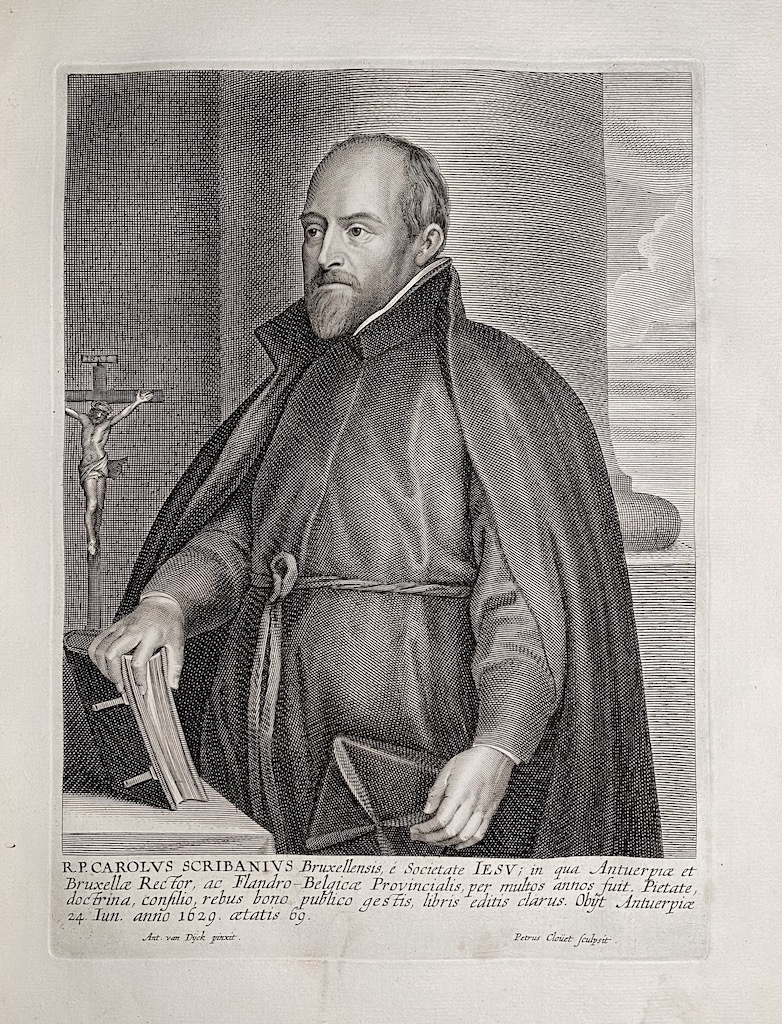
27. Carolus Scribani (Flemish, 1561 – 1629); engraved by Pieter Clouwet. Inscription: “R. P. CAROLVS SCRIBANIVS Bruxellensis, é Societate IESV; in qua Antuerpiæ et I Bruxellæ Rector, ac Flandro-Belgicæ Provincialis, per multos annos fuit. Pietate, | doctrina, consilio, rebus bono publico gestis, libris editis clarus. Obijt Antverpiæ | 24. Iun. anno 1629. ætatis 69.”. In lower margin: “Antonius van Dÿck pinxit.” <–> “Petrus Cloüet Sculpsit.”. Second, lettered state with the title and production details. 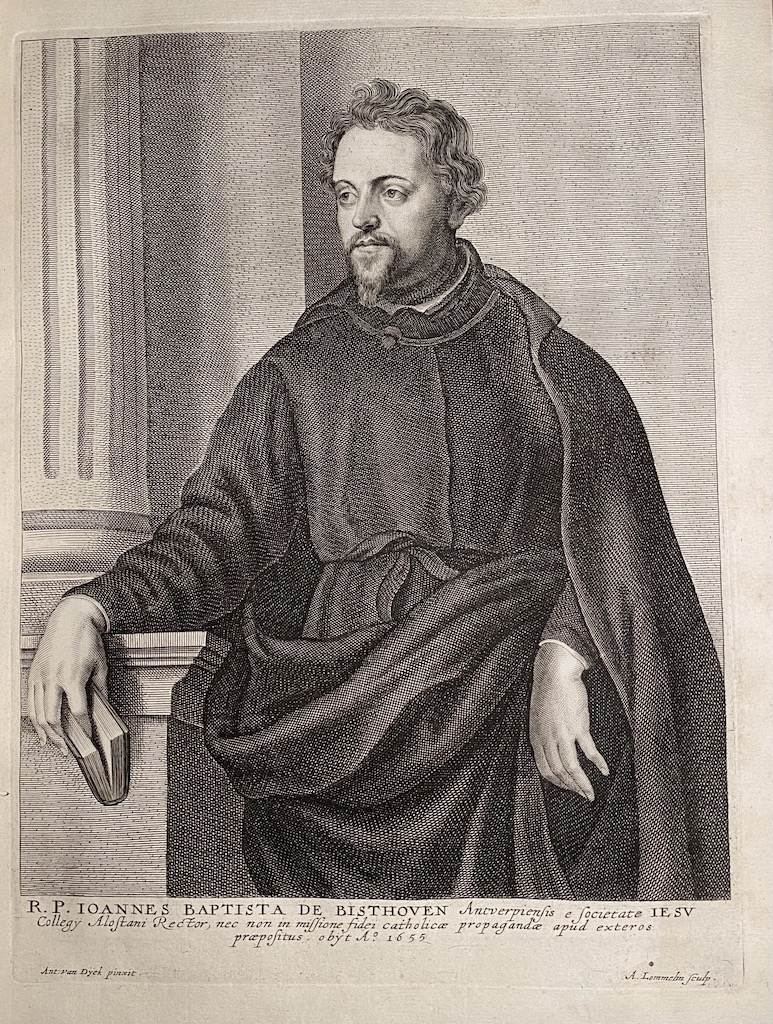
28. Jan Baptist van Bisthoven (Flemish, 1602 – 1655); engraved by Adriaen Lommelin. Inscription: “R.P. IOANNES BAPTISTA DE BISTHOVEN Antverpiensis e societate IESV | Collegÿ Alostani Rector, nec non in missione fidei catholicæ propagandæ apud exteros | præpositus obÿt A.o 1655”. In lower margin: “Ant:van Dÿck pinxit”, and “A. Lommelin sculp”. Second, lettered state with the title and production details. 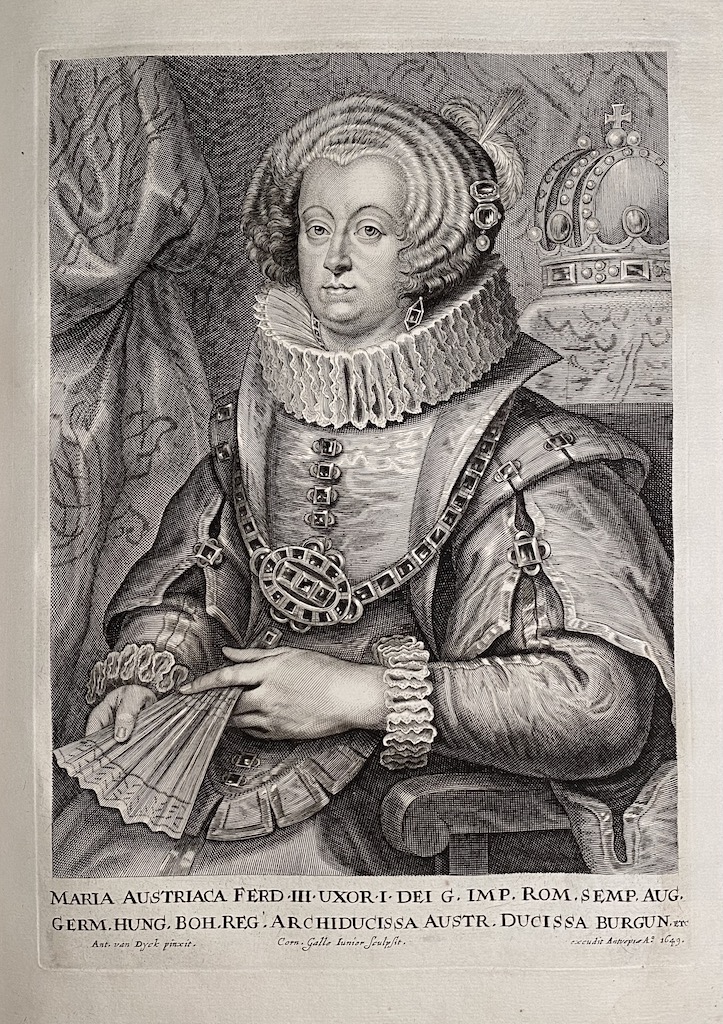
29. Maria of Austria (Spanish, 1606 – 1646); engraved by Cornelis Galle the Younger, published by Johannes Meyssens. Inscription: “MARIA AUSTRIACA FERD. III. UXOR. I. DEI G. IMP. ROM. SEMP. AUG. | GERM. HUNG. BOH. REG. ARCHIDUCISSA AUTR. DUCISSA BURGUN. ETC”. In lower margin: “Ant. van Dyck pinxit.” <–> “Corn. Galle Iunior sculpsit.” <–> “...excudit Antuerpiæ A.o 1649”. Third, lettered state with Meyssens’ name burnished badly. 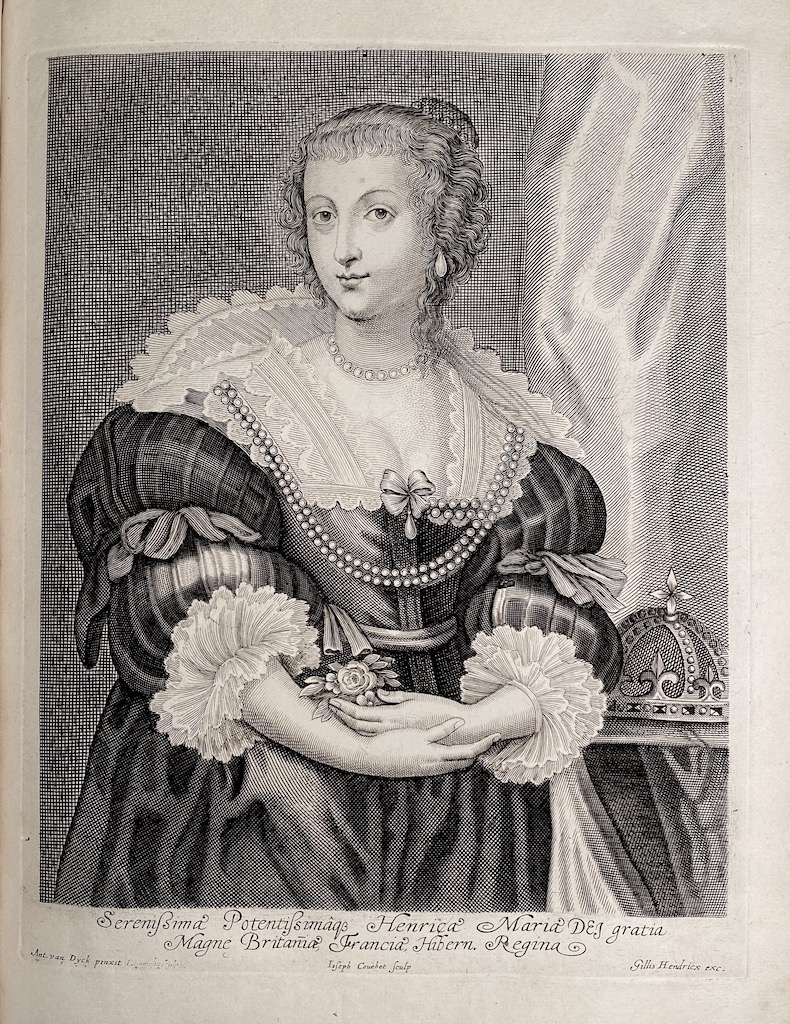
30. Henriette Marie de Bourbon, Queen of Charles I (French, 1609 – 1669); engraved by Antoine Couchet and Adriaen Lommelin, published by Gillis Hendricx. Inscription: “Serenißima Potenti∫simâq Henrica Maria Dei gratia | Magne Britaniæ, Franciæ, Hibern. Regina”. In lower margin: “Ant. van Dyck pinxit” <–> “Ioseph Couchet sculp” <–> “Gillis Hendricx exc.”. State with “Lommelin sculp.” right after “Ant. van Dyck pinxit” burnished, but still legible. 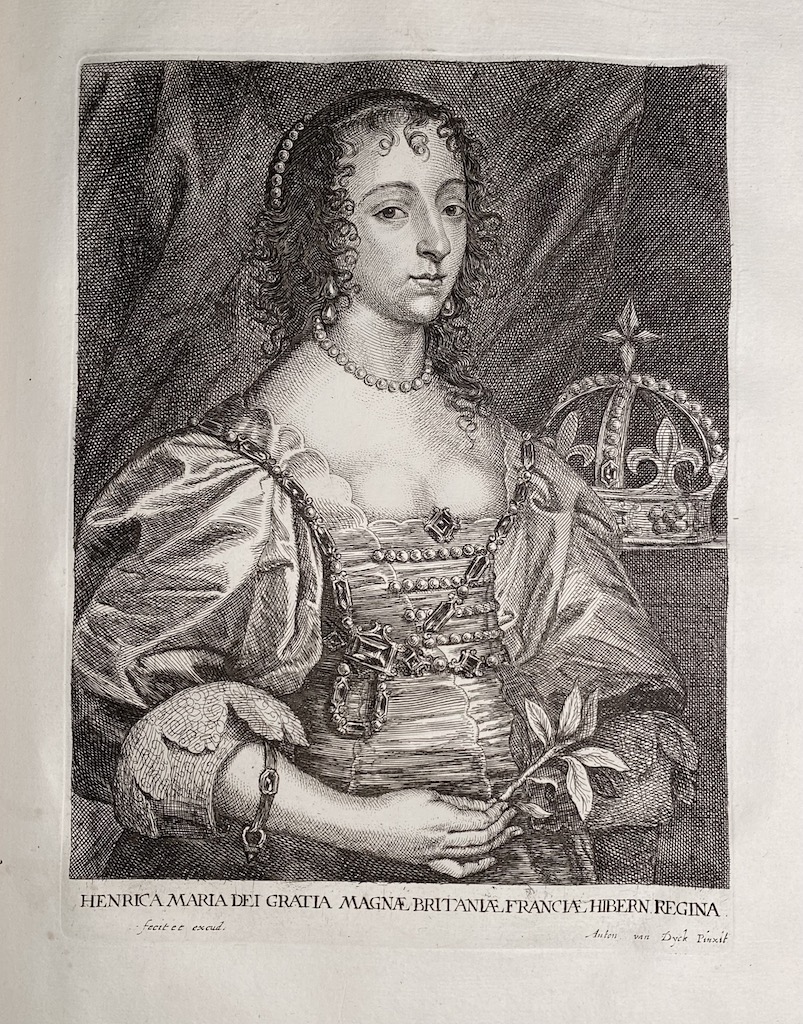
31. Henriette Marie de Bourbon, engraved and published by Ioannes Meyssens. Inscription: “HENRICA MARIA DEI GRATIA MAGNÆ BRITANIÆ FRANCIAÆ HIBERN. REGINA.”. In lower margin: “fecit et excud.” <–> “Anton van Dyck Pinxit”. Third state, finished with a burin; with Meyssens’ name burnished. [Similar to print №62 which has "Ioan. Mey∫ens" signature present]. 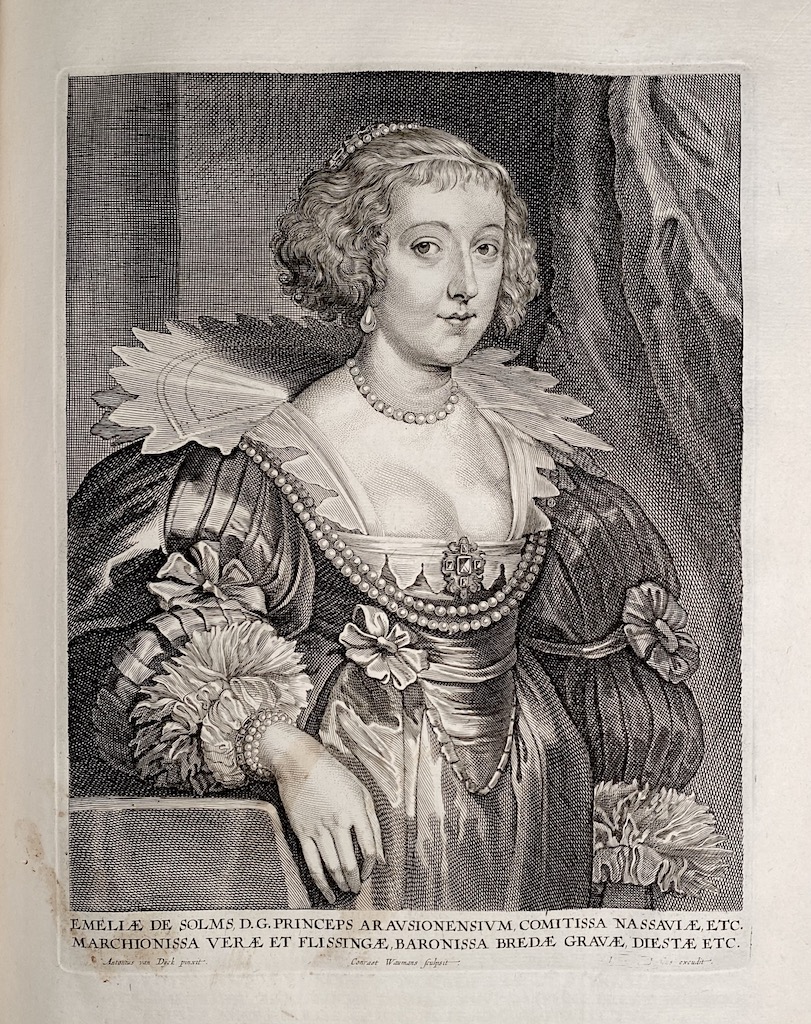
32. Amalia van Solms, Princess of Orange (German, 1602 – 1675), engraved by Conraad Waumans and published by Johannes Meyssens. Inscription: “EMELIÆ DE SOLMS, D. G. PRINCPES ARAVSIONENSIVM, COMITISSA NASSAUVIÆ, ETC. | MARCHIONISSA VERÆ ET FLISSINGÆ, BARONISSA BREDÆ, GRAVÆ, DIESTÆ ETC.”. In lower margin: “Antonius van Dijck pinxit.” <–> “Conraet Waumans sculpsit.” <–> “… excudit”. First, lettered state with the title and production details, with Meyssens’ name burnished. [Similar to №66, which has Ioannes Meysens name present]. 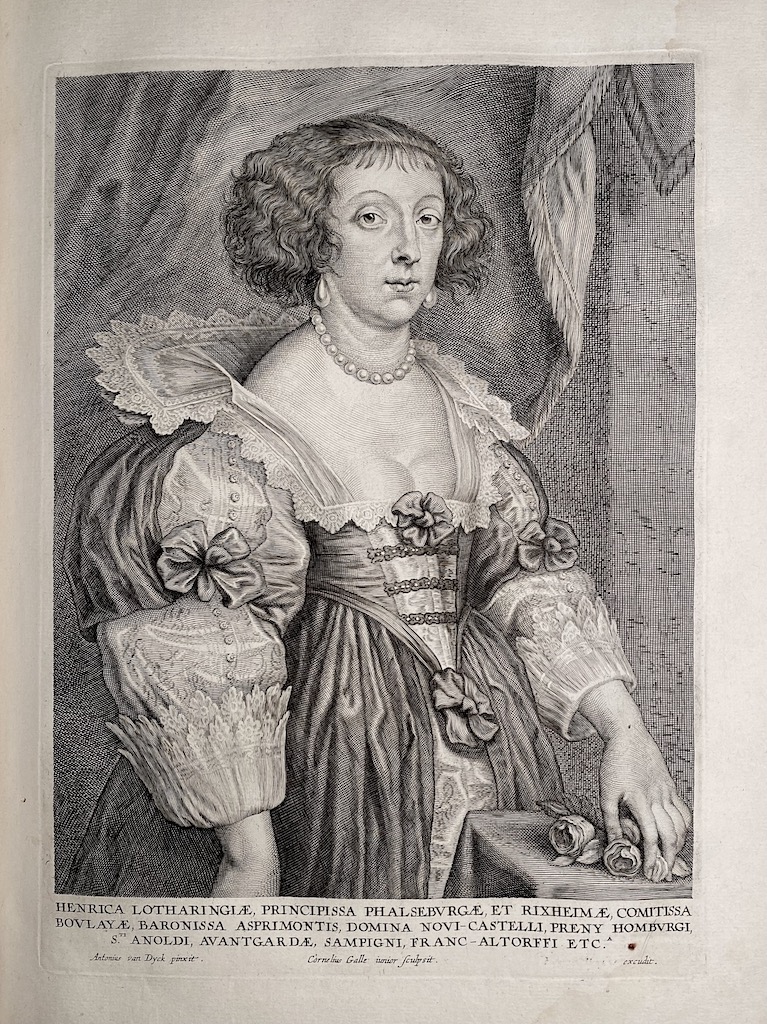
33. Henriette de Lorraine, Princess of Phalsbourg (or Pfalzburg) (French, 1605 – 1660); engraved by Cornelis Galle the Younger, published by Ioannes Meyssens. Inscription: “HENRICA LOTHARINGIÆ, PRINCIPISSA PHALSEBVRGÆ, ET RIXHEIMÆ, COMITISSA | BOVLAYÆ, BARONISSA ASPIRIMONTIS, DOMINA NOVI-CASTELLI, PRENY | HOMBVRGI, S.TI ANOLDI, AVANTGARDÆ, SAMPIGNI, FRANC-ALTORFFI ETC.A”. In lower margin: “Antonius van Dyck pinxit.” <–> “Cornelius Galle iunior sculpsit.” <–> “… excudit.”. First state with the title and production details, with Ioannes Meyssens’ name burnished. British Museum # R,1a.248. 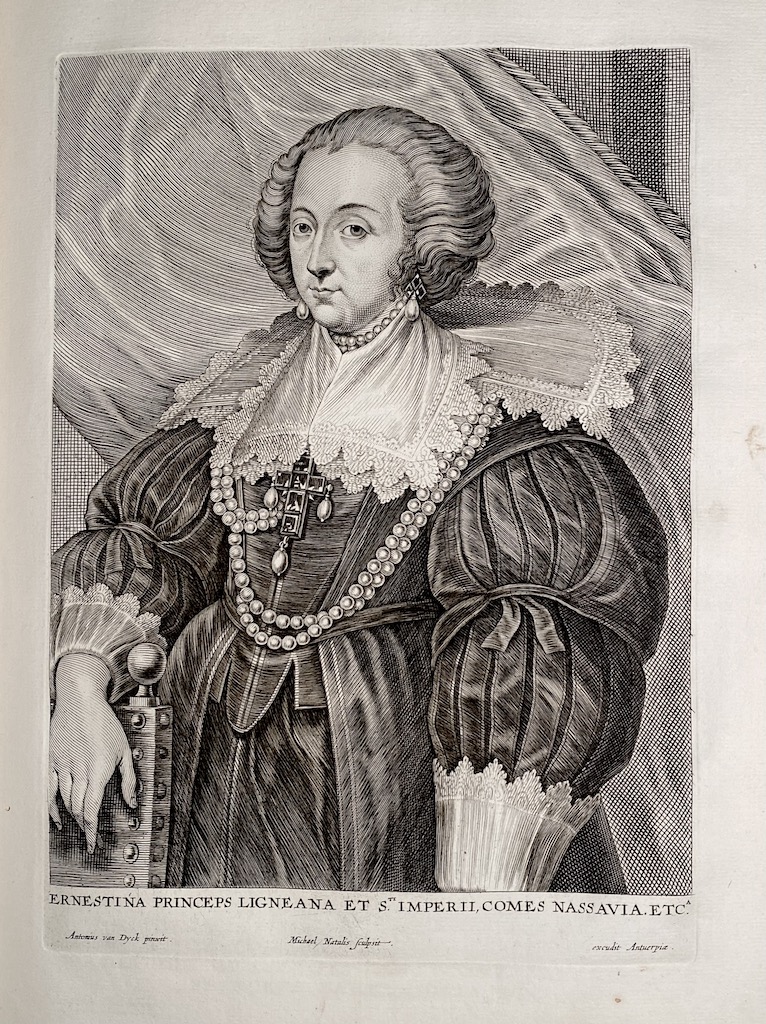
34. Ernestine Yolande de Ligne, Countess of Nassau-Siegen (Flemish, 1594 – 1668); engraved by Michiel Natalis, published by Jan Meyssens. Inscription: “ERNESTINA PRINCEPS LIGNEANA ET S.TI IMPERII, COMES NASSAVI. ETC.A”. In lower margin: “Antonius van Dyck pinxit.” <–> “Michael Natalis sculpsit.” <–> “…excudit Antuerpiæ.”. Second state with the initials of Ioannes Meyssens erased. 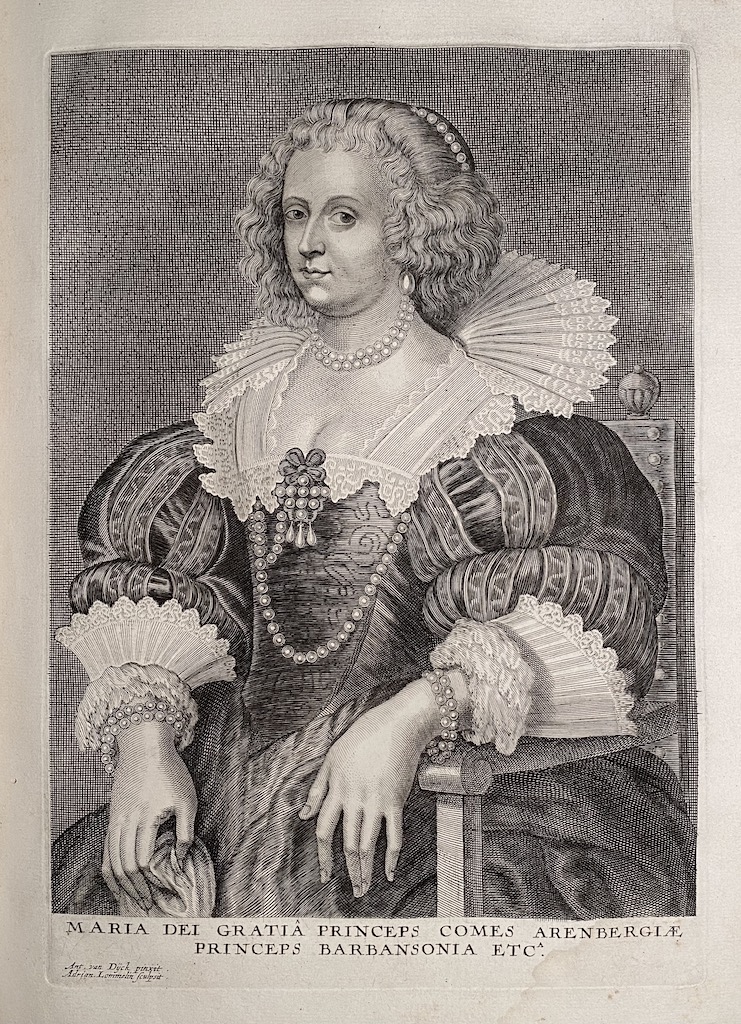
35. Marie de Barbançon, Princess of Arenberg (1602 – 1675); engraved by Adriaen Lommelin. Inscription: “MARIA DEI GRATIÂ PRINCEPS COMES ARENBERGIÆ | PRINCEPS BARBASONIA ETC.A”. In lower margin: “Ant. van Dÿck pinxit. | Adrian. Lommelin sculpsit.”. Second, lettered state with title and production details and adjustments made in the face. British Museum # 1876,1014.181 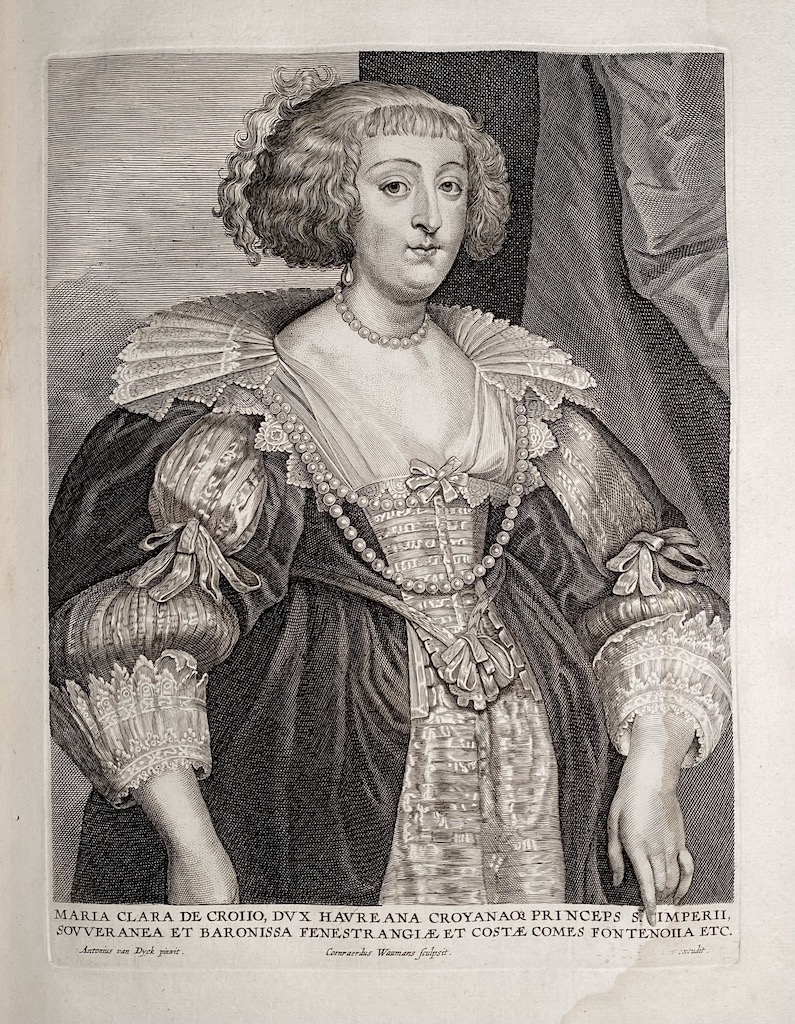
36. Marie-Claire de Croy, Duchess of Havré (Flemish, 1605 – 1664); engraved by Conraad Waumans, published by Ioannes Meyssens. Inscription: “MARIA CLARA DE CROIIO, DVX HAVREANA CROYANAQ3 PRINCEPS STE. IMPERII, | SOVVERANEA ET BARONISSA FENESTRANGIÆ ET COSTÆ COMES FONTENOIIA ETC.”. In lower margin: “Antonius van Dyck pinxit.” <–> “Coenraerdus Waumans sculpsit.” <–> “…excudit.”. Third state with Ioannes Meyssens’ name burnished. British Museum # 1891,1015.21. [Similar to №64, which has Ioannes Meysens’ name present]. 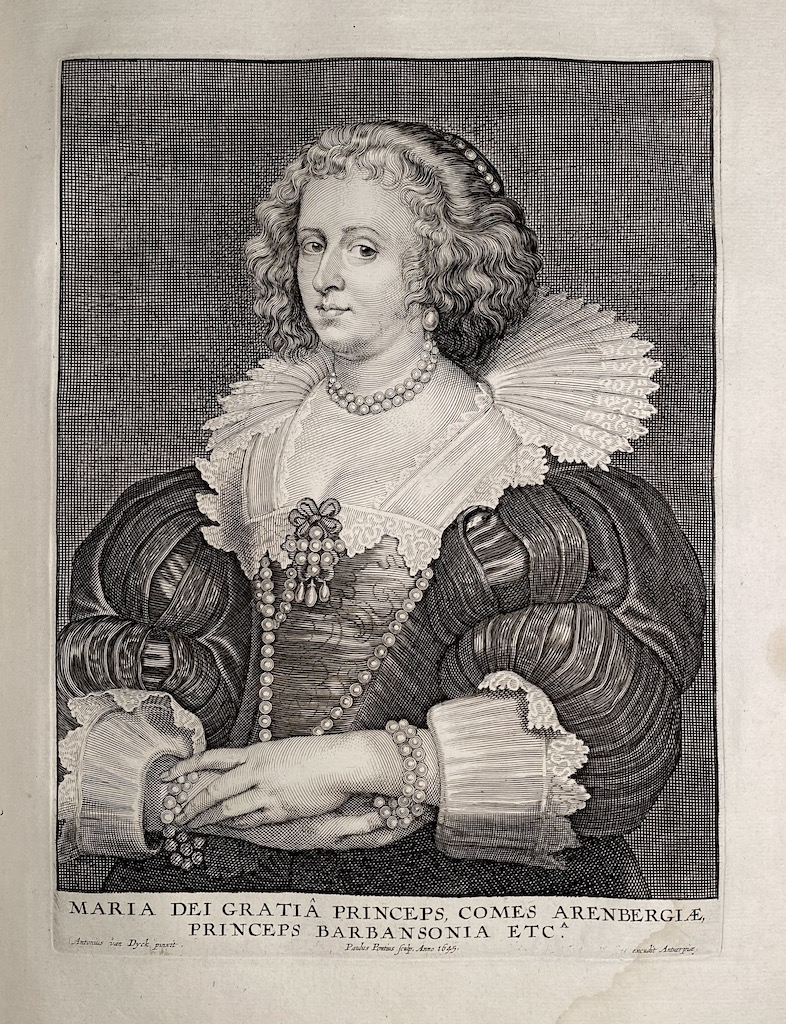
37. Marie de Barbançon, Princess of Arenberg (1602 – 1675); engraved by Paulus Pontius, published by Ioannes Meyssens. Inscription: “MARIA DEI GRATIÂ PRINCEPS COMES ARENBERGIÆ, | PRINCEPS BARBASONIA ETC.A”. In lower margin: “Antonius van Dyck pinxit. | Paulus Pontius sculp. Anno 1645.” <–> “… excudit Antuerpiæ”. Second state with a thick borderline, title and production details added, Ioannes Meyssens’s name burnished. 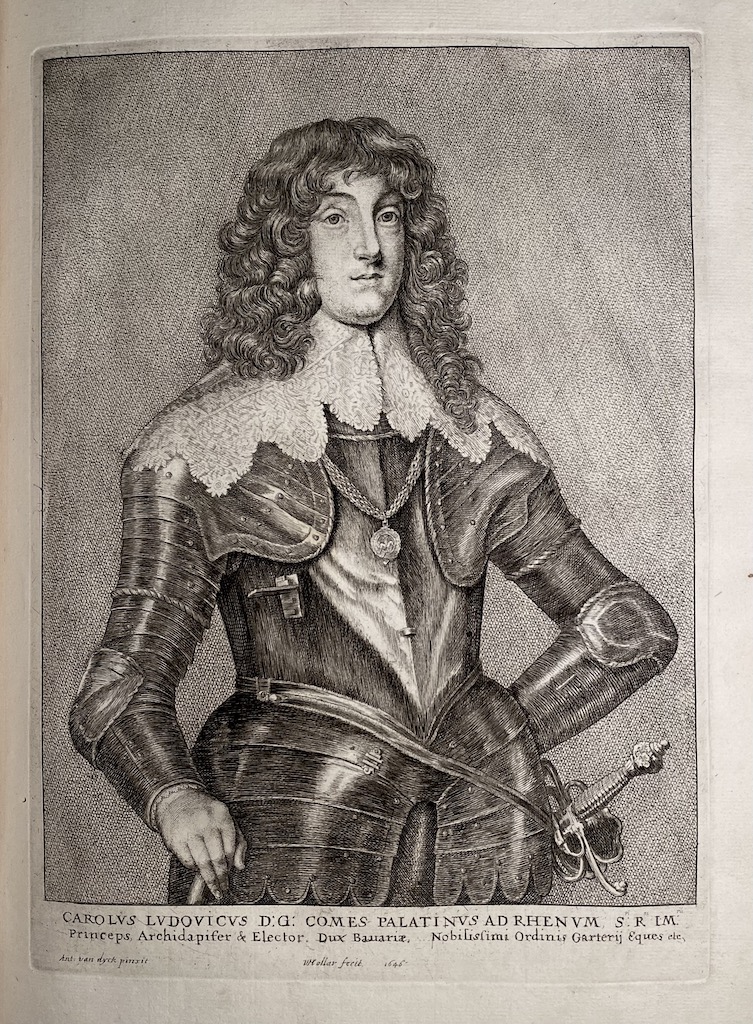
38. Karl I Ludwig, Elector Palatine (German, 1617 – 1680); engraved by Wenceslaus Hollar (Bohemian, 1607 – 1677). Inscription: “CAROLVS LVDOVICVS D:G: COMES PALATINVS AD RHENVM, S:ri R.ni IM:rii | Princeps, Archidapifer & Elector, Dux Bauariæ, …Nobilissimi Ordinis Garterij Eques etc.”. Below: “Ant: van Dyck pinxit” <–> “WHollar fecit,” <–> “1646”. First, lettered state with the title and production details, without “H: van de Borcht excu:”. British Museum # 1867,1012.598. Hendrik van der Borcht II (Dutch, 1614 – c. 1690) 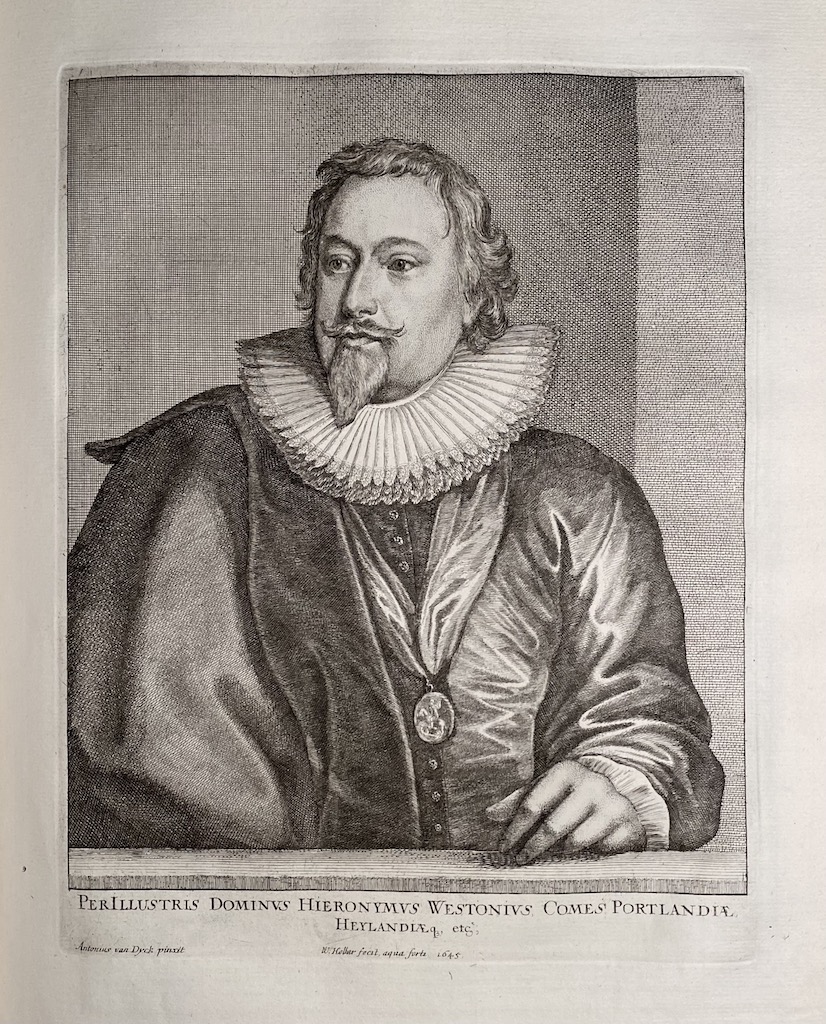
39. Richard Weston, 1st Earl of Portland (British, 1577 – 1635); engraved by Wenceslaus Hollar, published by Ioannes Meyssens. Inscription: “PERILLUSTRIS DOMINVS HIERONYMVS WESTONIVS, COMES PORTLANDIÆ, | HEYLANDÆq3, etc’,”. Below: “Antonius van Dyck pinxit”<–> “W: Hollar fecit, aqua forte. 1645”. Ioannes Meyssens’s name completely burnished. 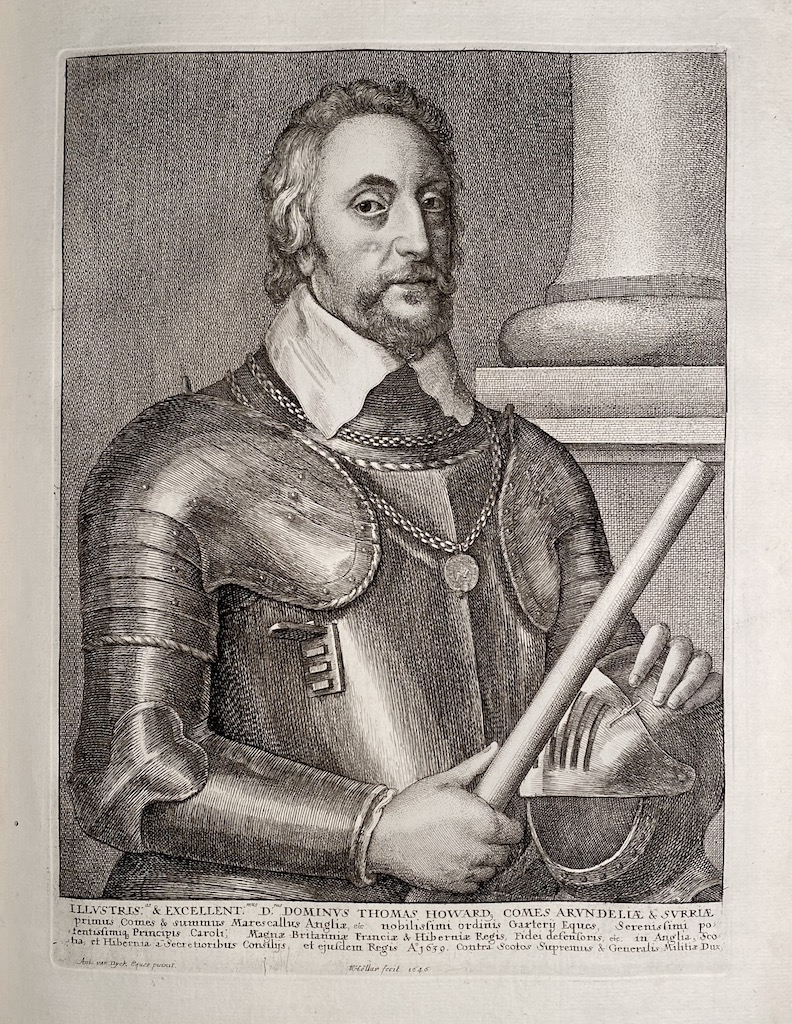
40. Thomas Howard, 14th Earl of Arundel (British, 1585 – 1646); engraved by Wenceslaus Hollar, published by Ioannes Meyssens. Inscription: "ILLVSTRIS:us & EXCELLENT:mus D:nus. DOMINVS THOMAS HOWARD, COMES ARXNDELIÆ & SVRRIÆ | primus Comes & summus Marescallus Angliæ, etc nobilisimi ordiuis Garterÿ Eques, Serenis∫imi po: | tentis∫imq3 Principis Caroli: Magnæ Britanniæ & Hiberniæ Regis, Fidei defen∫oris, etc. in Anglia, Sco | tia et Hibernia a Secretioribus Consilijs, et eju∫dem Regis Ao1639. Contra | Scotos Supremus & Generalis Militiæ Dux,”. In lower margin: “Ant: van Dyck Eques pinxit” <–> “WHollar fecit 1646”. Second state with Ioannes Meyssens’s name completely burnished. 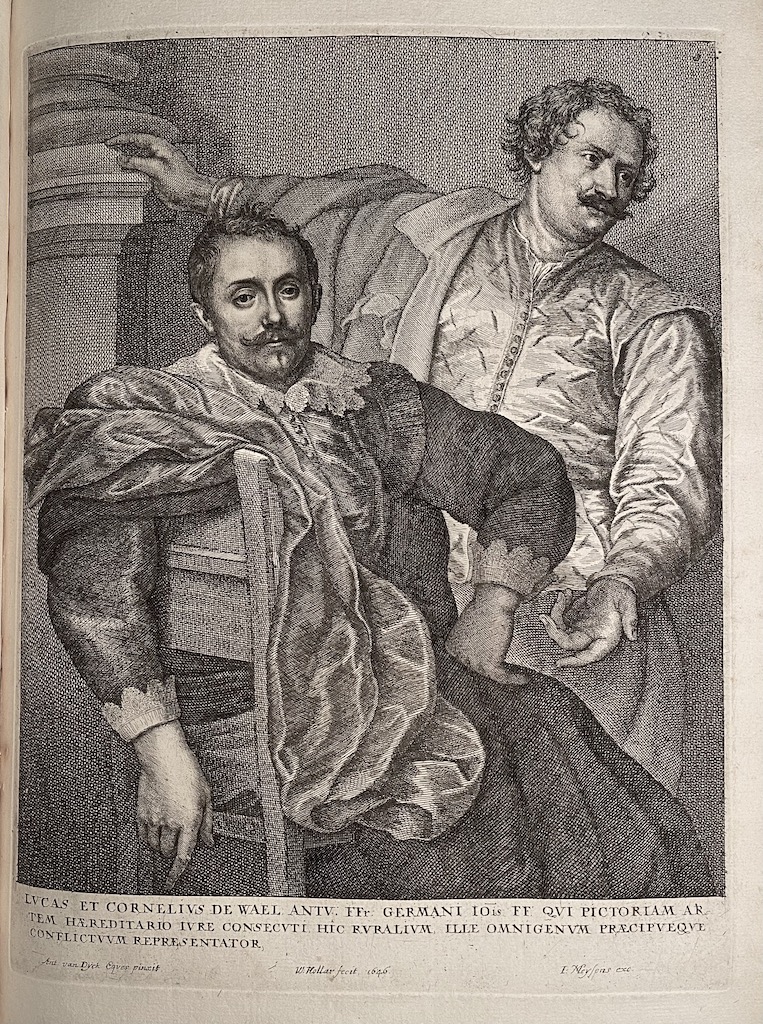
41. Lucas de Wael (Flemish, 1591 – 1661) and Cornelis de Wael (Flemish, 1592 – 1667); engraved by Wenceslaus Hollar, published by Ioannes Meyssens. Inscription: “LVCAS ET CORNELIVS DE WAEL ANTV: FFr. GERMANI IOis QUI PICTORIAM AR | TEM HÆREDITARIO IVRE CONSECVTI HIC RVRALIVM, ILLE OMNIGENVM PRÆCIPVEQVE / CONFLICTVVM REPRÆSENTATOR.”. In lower margin: “Ant. van Dyck Eques pinxit.” <–> “W: Hollar fecit, 1646.” <–> “I: Meysens exc”. First, lettered state with the title and production details. 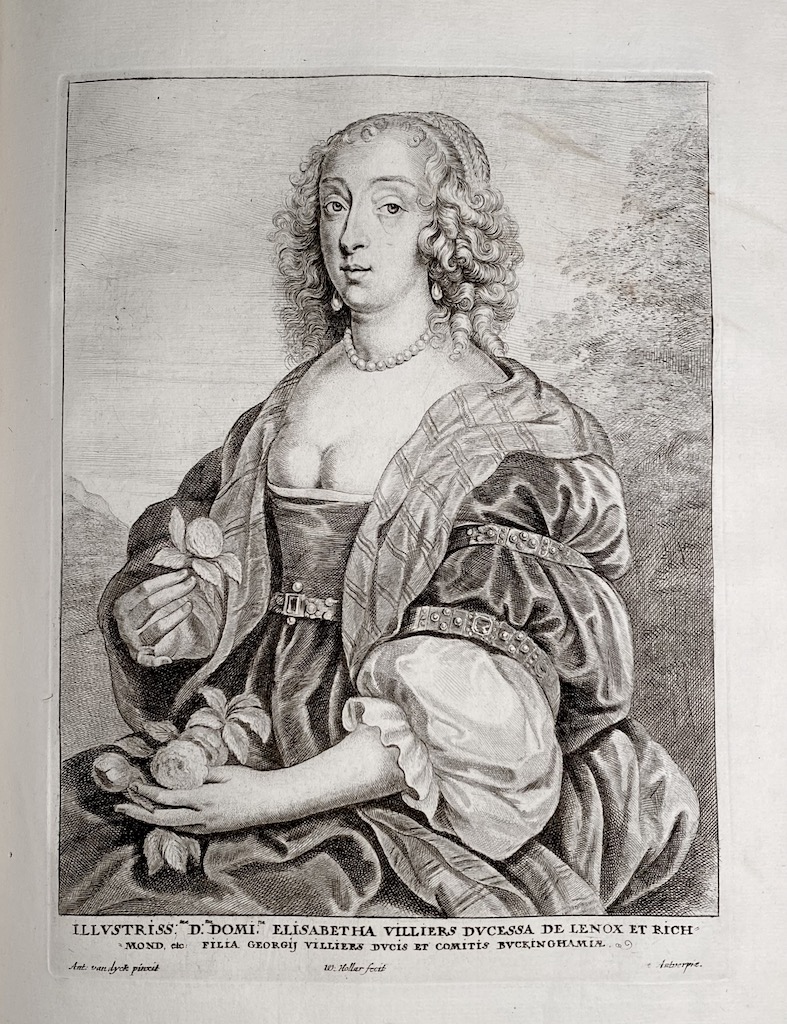
42. Mary (Elisabetha ) Villiers, Duchess of Lennox and Richmond (British, 1622 – 1685); engraved by Wenceslaus Hollar, published by Ioannes Meyssens. Inscription: “ILLUSTRISS: ma D:ma DOMI.na ELISABETHA VILLIERS DVCESSA DE LENOX ET RICH | MOND. etc: FILIA GEORGIJ VILLIERS DVCIS ET COMITIS BVCKINGHAMIÆ.”. In lower margin: “Ant: van dyck pinxit” <–> “W:Hollar fecit” <–> “… Antverpiæ.”. Ioannes Meyssens’ name completely burnished. First state with the title and production details. 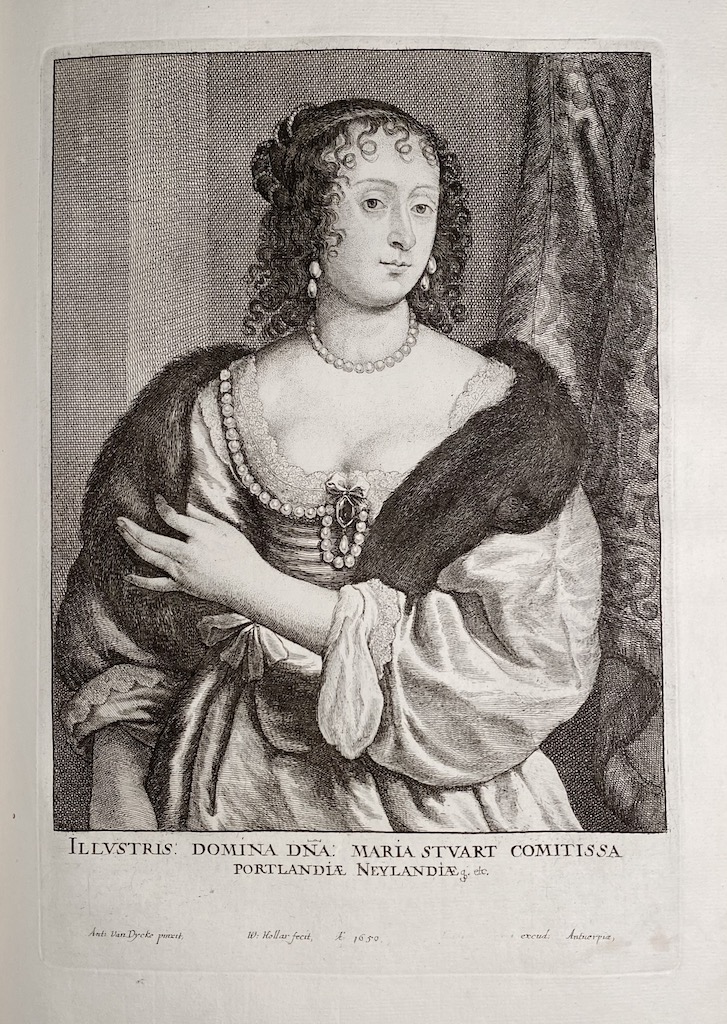
43. Frances (Maria) Stuart, Countess of Portland (British, 1617 – 1694); engraved by Wenceslaus Hollar, published by Ioannes Meyssens. Inscription: “ILLVSTRIS: DOMINA DNA: MARIA STVART COMITISSA | PORTLANDIÆ NEYLANDIÆ, etc.”. Below: “Ant: Van Dycke pinxit,” <–> “W: Hollar fecit, A:o 1650,”, “...excud: Antuerpiæ,”. Second state with Meyssens’ name burnished. British Museum # 1853,0112.1761 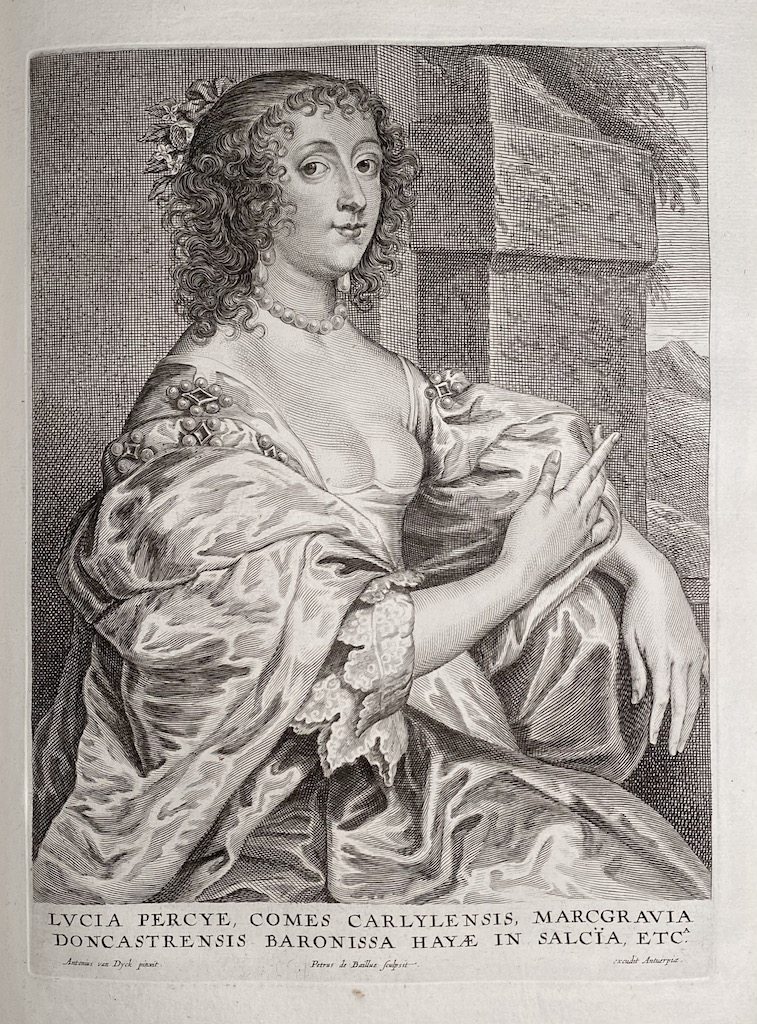
44. Lucy Percy, Countess of Carlisle (British, 1599 – 1660); engraved by Pieter de Bailliu, published by Ioannes Meyssens. Inscription: “LVCIA PERCYE, COMES CARLYLENSIS, MARCGRAVIA | DONCASTRENSIS BARONISSA HAYÆ IN SALCÏA, ETC.A”. In lower margin: “Antonius van Dyck pinxit.” <–> “Petrus de Baillue sculpsit.” <–> “...excudit Antuerpia.”. Third, lettered state with Joannes Meyssens’ name burnished. 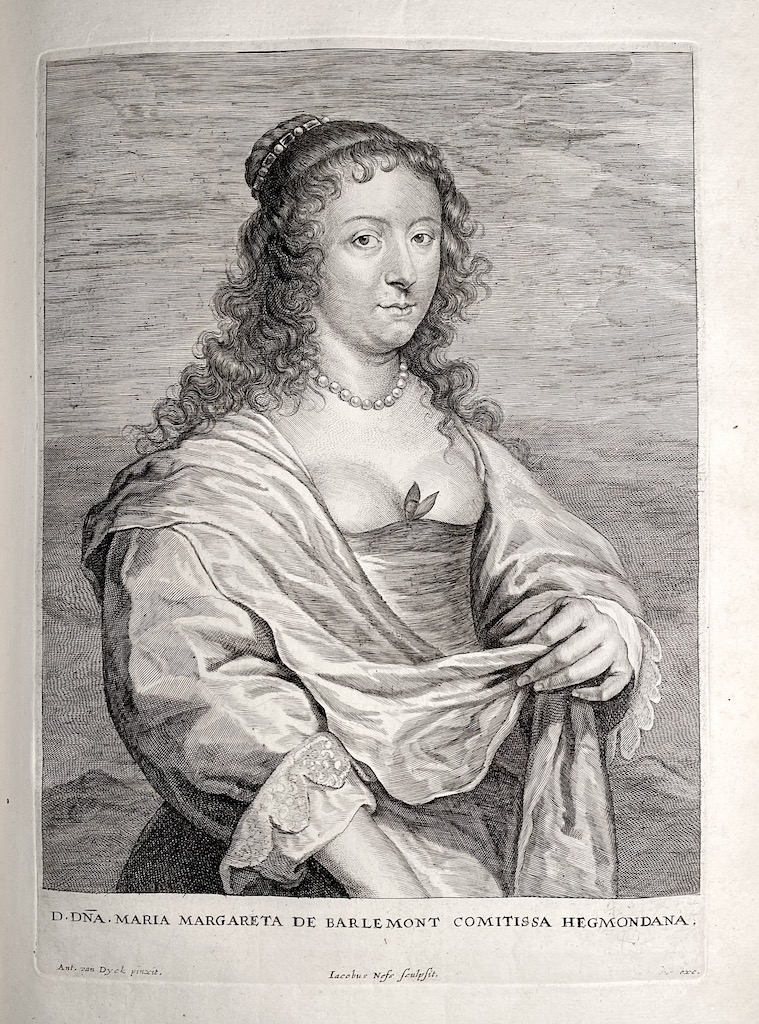
45. Marie-Marguerite de Berlaymont ( ? – 1654); engraved by Jacobus Neeffs, published by Ioannes Meyssens. Inscription: “D.DNA. MARIA MARGARETA DE BARLEMONT COMITISSA HEGMONDANA.” In lower margin: “Ant. van Dyck pinxit.” <–> “Iacobus Nefs sculpsit.”<–> “...exc.”. Fourth state with Ioannes Meyssens’ name erased. British Museum # 1876,1014.206. [Similar to №67, which has Ioannes Meysens name present]. 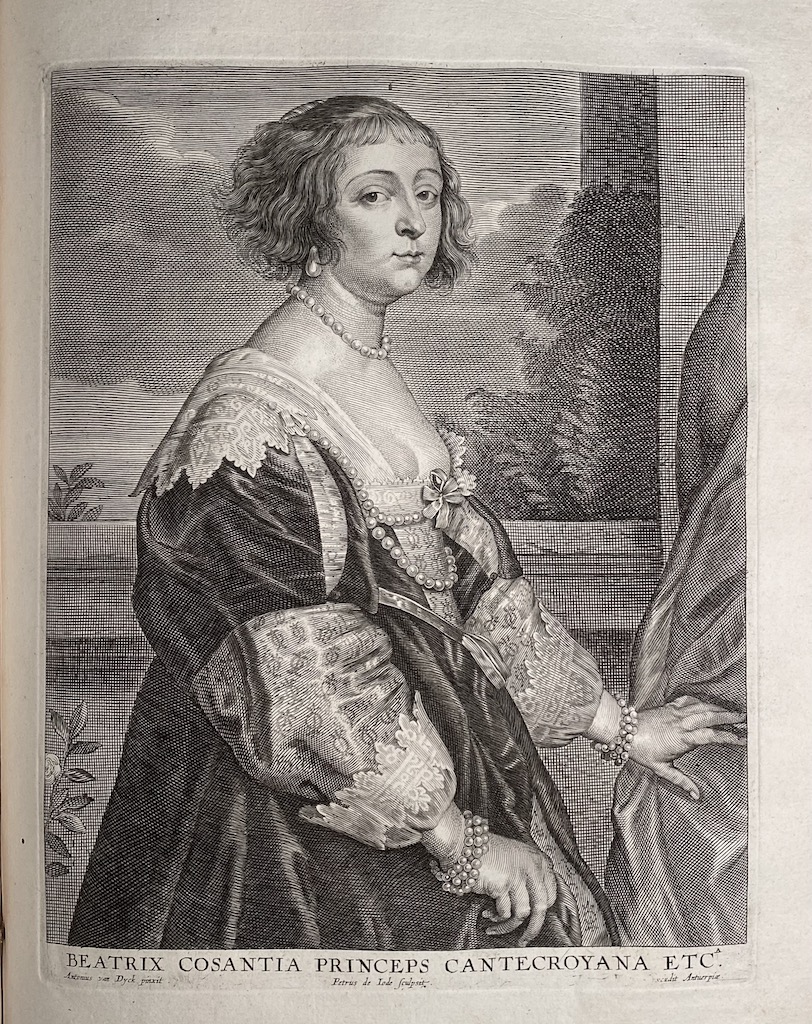
46. Béatrix Constance de Cussance, Princess of Cantecroix (French, 1614 – 1663); engraved by Pieter de Jode II, published by Ioannes Meyssens. Inscription: “BEATRIX COSANTIA PRINCEPS CANTECROYANA ETC.A”. In lower margin: “Antonius van Dyck pinxit” <–>“Petrus de Iode sculpsit.” <–> “… excudit Antuerpiæ.”. Second, lettered state with Meyssens’ name burnished. 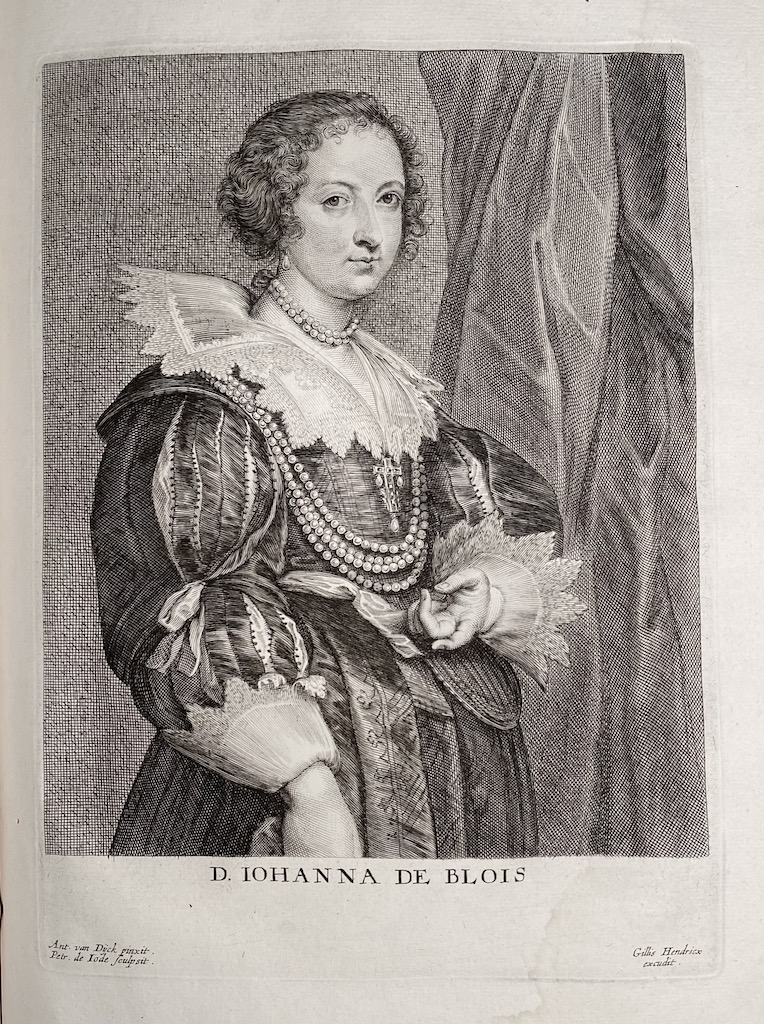
47. Johanna de Blois; engraved by Pieter de Jode II, published by Gillis Hendricx. Inscription: “D. IOHANNA DE BLOIS”. In the lower margin: “Ant. van Dÿck pinxit | Petr. de Iode sculpsit” <–> “Gillis Hendricx | excudit.”. British Museum # 1876,1014.189. 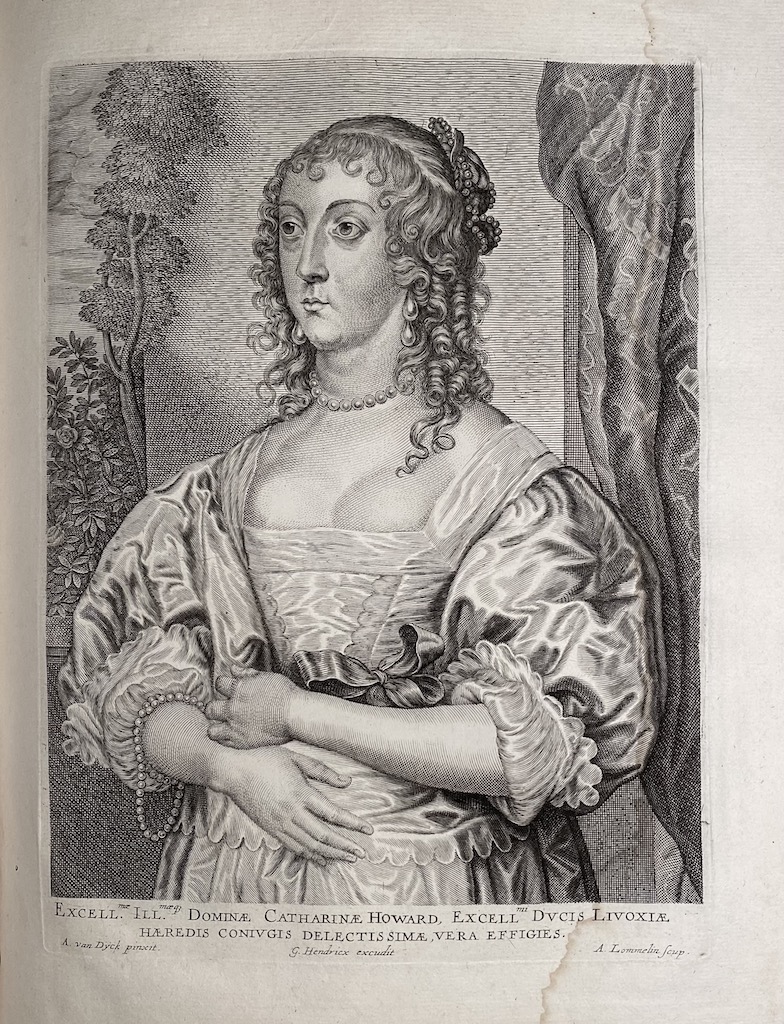
48. Katherine Howard, Countess of Newburgh, Lady d’Aubigny (British, ? – 1650); engraved by Adriaen Lommelin, published by Gillis Hendricx. Inscription: “EXCELLmæ ILL.mæq3 DOMINÆ CATHARINÆ HOWARD, EXCELLmi DUCIS LIVOXIÆ | HÆREDIS CONIUGIS DELECTISSIMÆ, VERA EFFIGIES.” In lower margin: “A. van Dÿck pinxit.” <–> “G. Hendricx excudit” <–> “A. Lommelin scup.”. British Museum # P,3.326 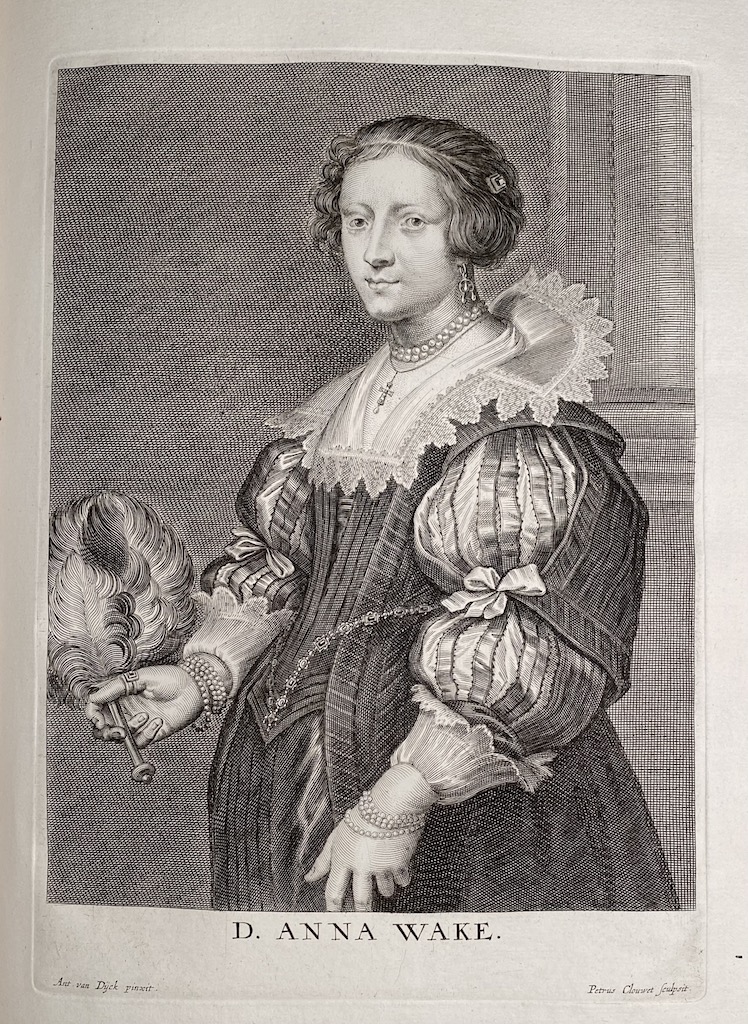
49. Anna Wake (Flemish, 1606 – 1680); engraved by Pieter Clouwet. Inscription: “D. ANNA WAKE.”. In lower margin: “Ant. van Dÿck pinxit.” <–> “Petrus Clouwet sculpsit”. 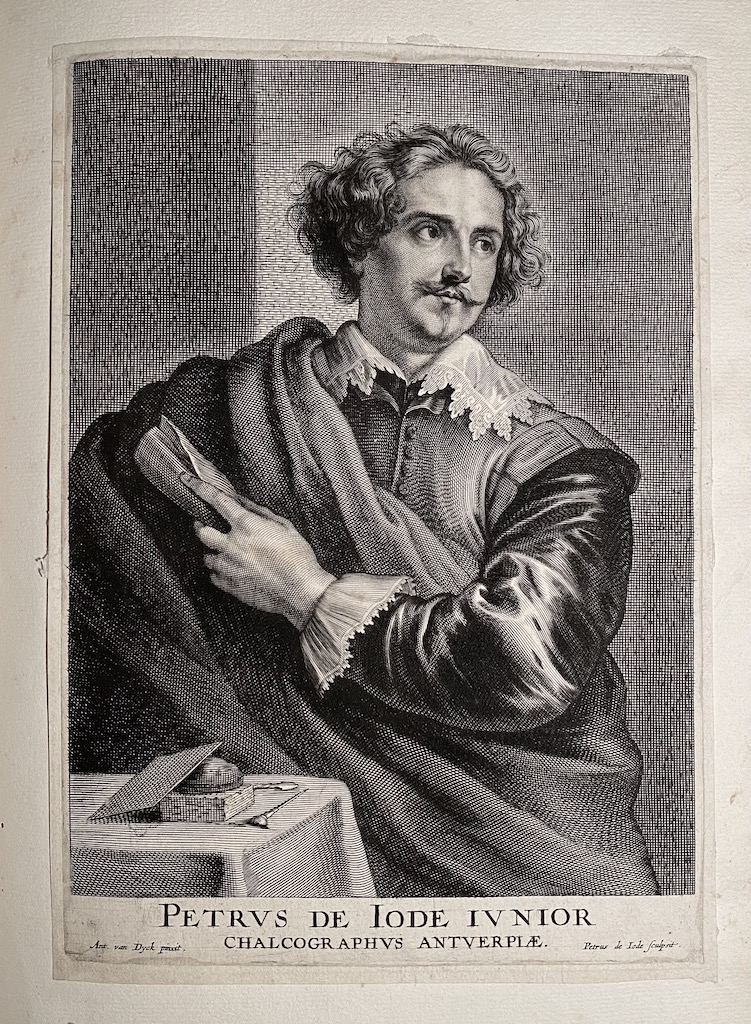
50. Pieter de Jode II (Flemish, 1606-1670/74); engraved by Pieter de Jode II. Inscription: “PETRVS DE IODE IVNIOR / CHALCOGRAPHVS ANTVERPIÆ.”. In lower margin: “Ant. van Dyck pinxit.”<–> “Petrus de Iode sculpsit.”. Third state (before the initials G.H. (of Gillis Hendricx) added. The print with cut off margins pasted to the bound-in leaf. 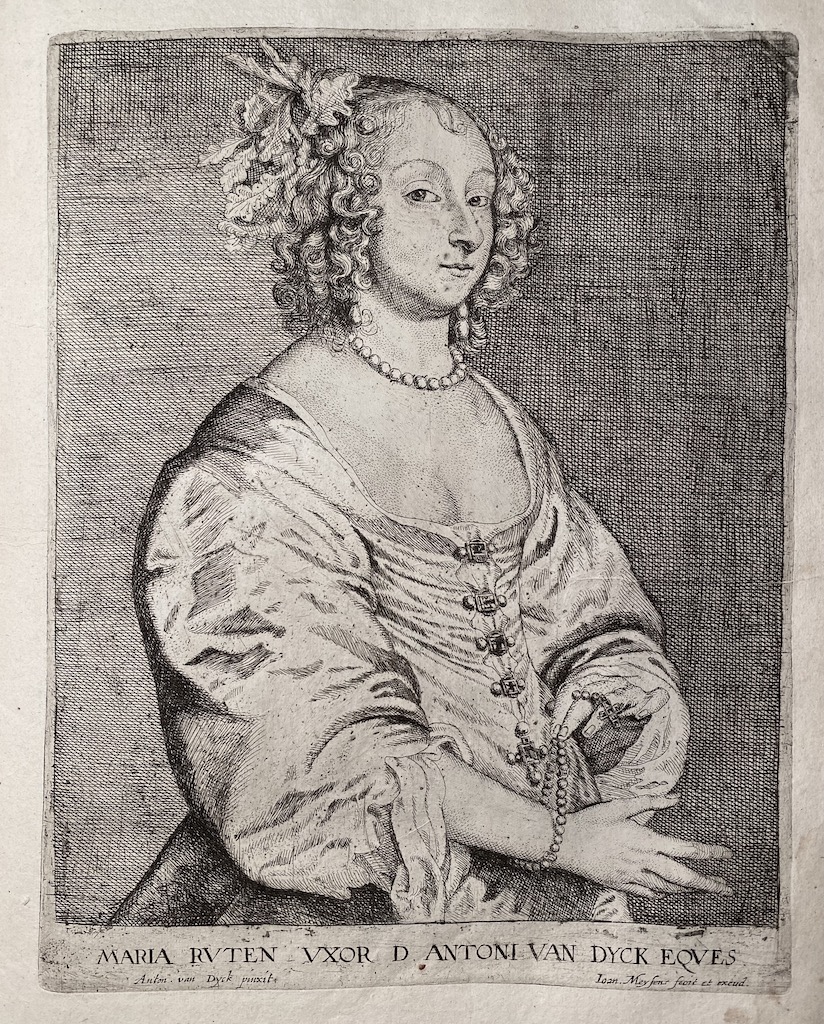
51. Mary Ruthven, Lady van Dyck (Scottish, c. 1622 – 1645); engraved and published by Ioannes Meyssens. Inscription: “MARIA RVTEN VXOR D. ANTONI VAN DYCK EQVES”. In lower margin: “Anton.van Dyck pinxit” <–> “Ioan. Meysens fecit et excud.”. First, lettered state with the title and production details. Tired plate. British Museum # 1863,0725.747. Van Dyck's wife. 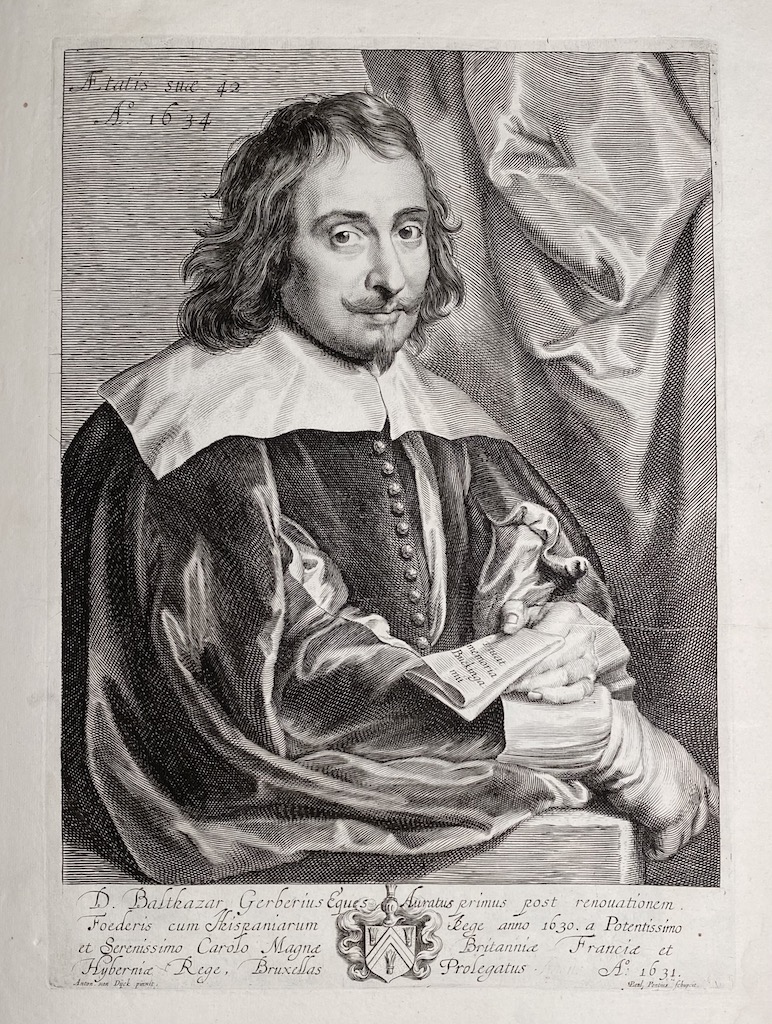
52. Sir Balthazar Gerbier (British, Flemish, 1592 – 1663); engraved by Paulus Pontius. Inscription: “D. Balthazar Gerberius Eques Auratus primus post renouationem. | Foederis cum Hispaniarum Rege anno 1630. A Potentissimo | et Serenissimo Carolo Magnæ Britanniæ Franciæ et Hiberniæ. Rege, Bruxellas Prolegatus. A:o 1631”. Below “Anton van Dyck pinxit”<–> “Paul Pontius schupcit.”. Top left corner: “Ætatis suæ 42 | A.o 1634”. The paper in Gerbier’s hand is lettered “viuat | memoria | Buckinga: | mii”. 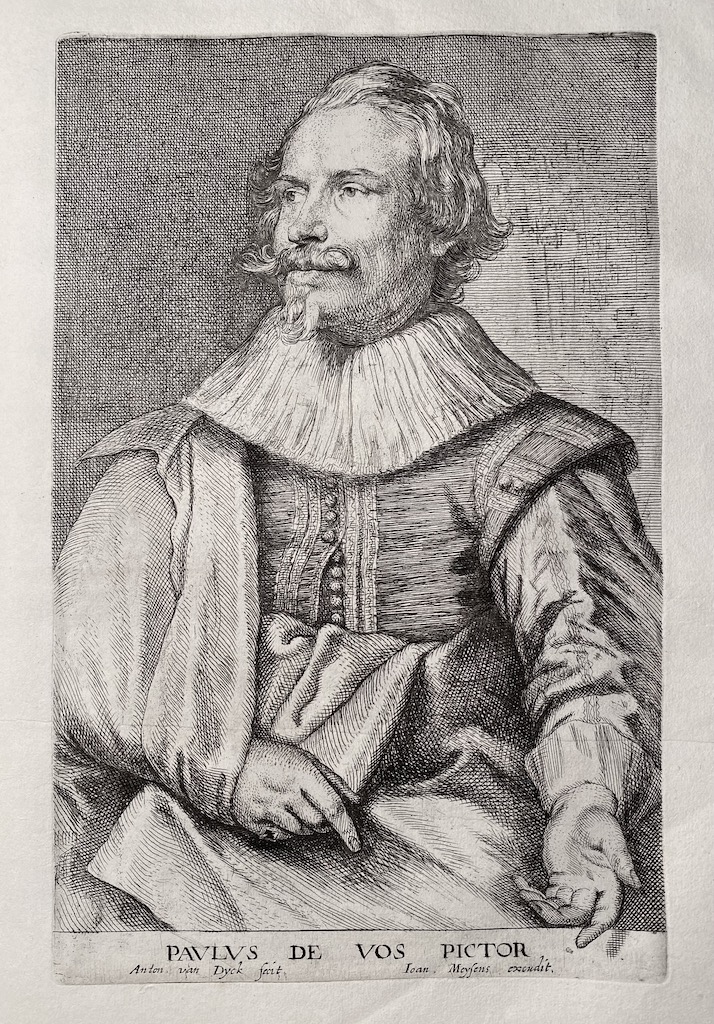
53. Paul de Vos (Flemish, 1596 – 1678); printed by Ioannes Meyssens, face and collar engraved by Anthony van Dyck, the body engraved by Ioannes Meyssens. Second, lettered state. Inscription: PAVLVS DE VOS PICTOR”. In lower margin: “Anton. van Dyck pinxit fecit.”, and “Ioan. Meysens excudit.”. British Museum # R,1b.95. [Look s very much alike №68, but with a one-line inscription and engraved by Meyssens instead of Bolswert]. 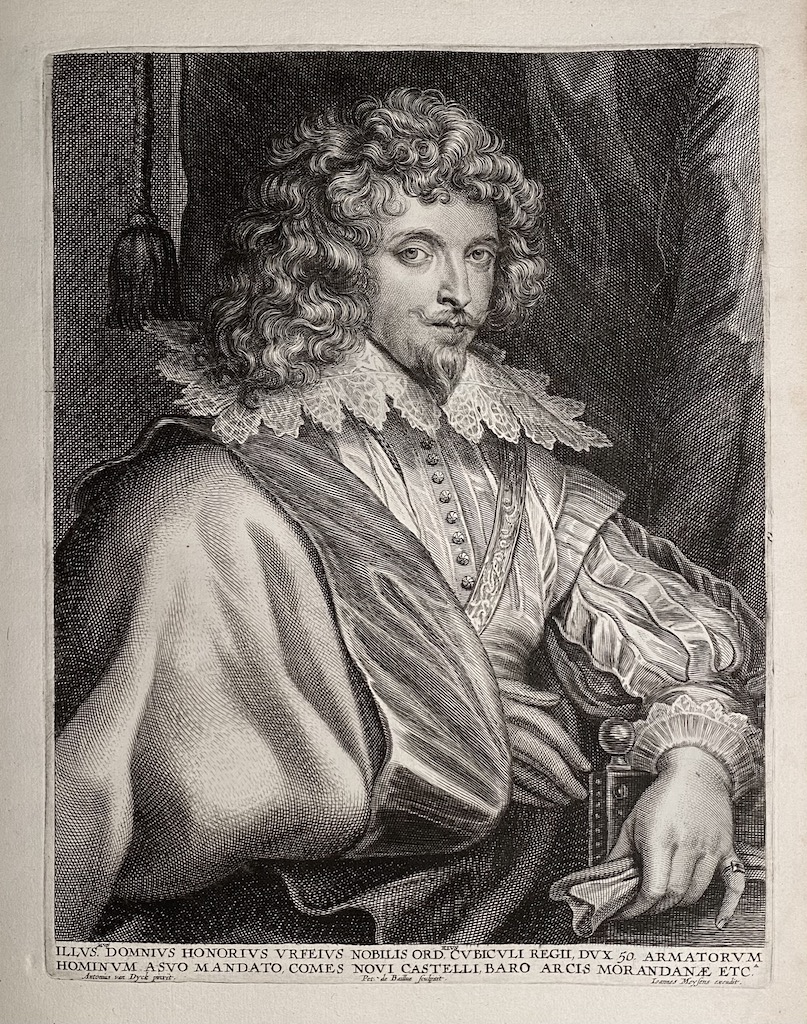
54. Honoré d’Urfé, marquis de Valromey, comte de Châteauneuf (French, 1568 – 1625); engraved by Pieter de Bailliu (Flemish, 1613 – 1660). Inscription: “ILLVS.MVS DOMNIVS HONORIVS VRFEIVS NOBILIS ORD.RIVS CVBICVLI REGII, DVX 50. ARMATORVM | HOMINVM A SVO MANDATO, COMES NOVI CASTELLI, BARO ARCIS MORANDANÆ ETC.A”. Below: “Antonius van Dyck pinxit” <–> “Pet. de Bailliue sculpsit.” <–> “Ioanes Meysens excudit.”. Second lettered state with title and production details. [Similar to №14, but with Ioanes Meysens name in place]. 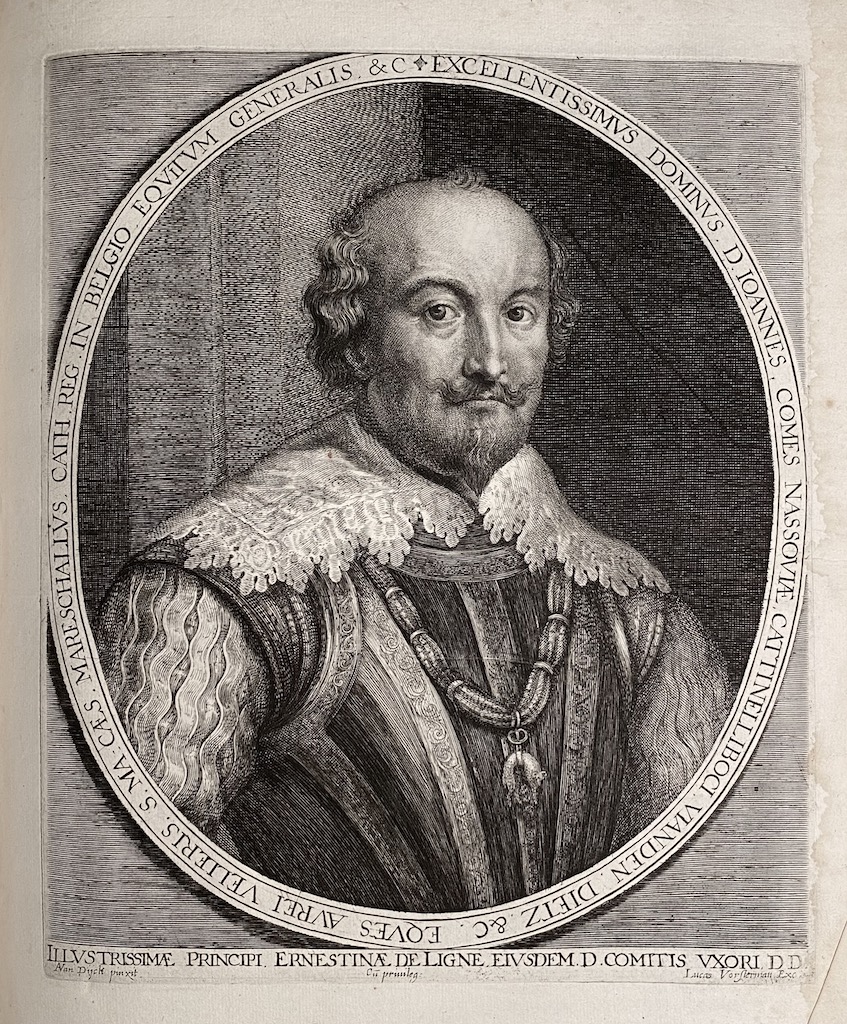
55. Johannes [John VIII], Count of Nassau-Siegen (German, 1583 – 1638); engraved by Lucas Vorsterman I (Flemish, 1595 – 1675). Inscription: in the oval around the portrait “EXCELLENTISSIMVS DOMINVS: D. IOANNES, COMES NASSAOVIÆ, CATTNELLIBOCI: VIANDEN, DIETZ, &C. EQVES AVREI VELLERIS. S. MA: CÆS, MARESCHALIVS, CATH. REG. IN BELGIO. EQVITVM GENERALIS. &C”, in lower margin: “ILLVSTRISSIMÆ PRINCIPI ERNESTINÆ DE LIGNE EIVSDEM D. COMITIS VXORI DD.”. Below: “AVan Dÿck pinxit.” <–> “Cū Priuleg” <–> “Lucas Vorsterman exc”. Third state. [For the fourth state with Lucas “Vorsterman exc” burnished see № 15]. 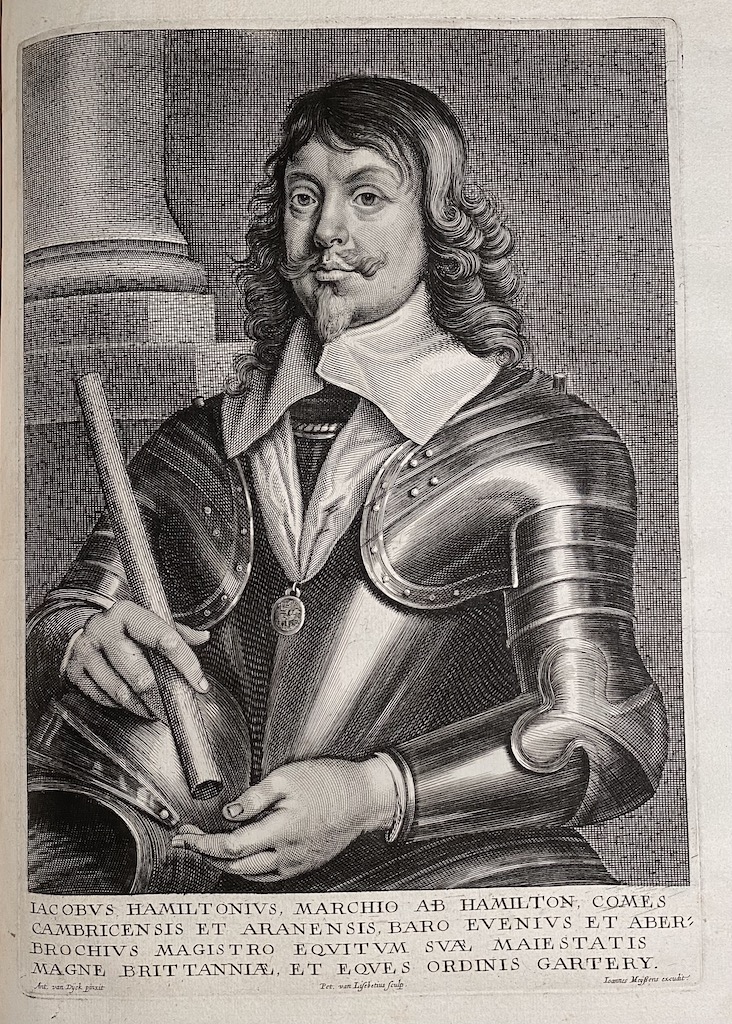
56. James Hamilton, 1st Duke of Hamilton (British, 1606 – 1649); engraved by Peeter van Lisebetten (Flemish,(1630 – 1678), published by Ioannes Meysens. Inscription: “IACOBVS HAMILTONIVS, MARCHIO AB HAMILTON, COMES | CAMBRICENSIS ET ARANENSIS, BARO EVENIVS ET ABER: | BROCHIVS MAGISTRO EQVITVM SVÆ MAIESTATIS | MAGNE BRITTANIÆ, ET EQUES ORDINIS GARTERY.”.In lower margin: “Ant. van Dÿck pinxit” <–> “Pet. van Lisebetius sculp.”<–> “Ioannes Meÿssens excudit.”. Second state with title and signatures. British Museum # P,2.208. 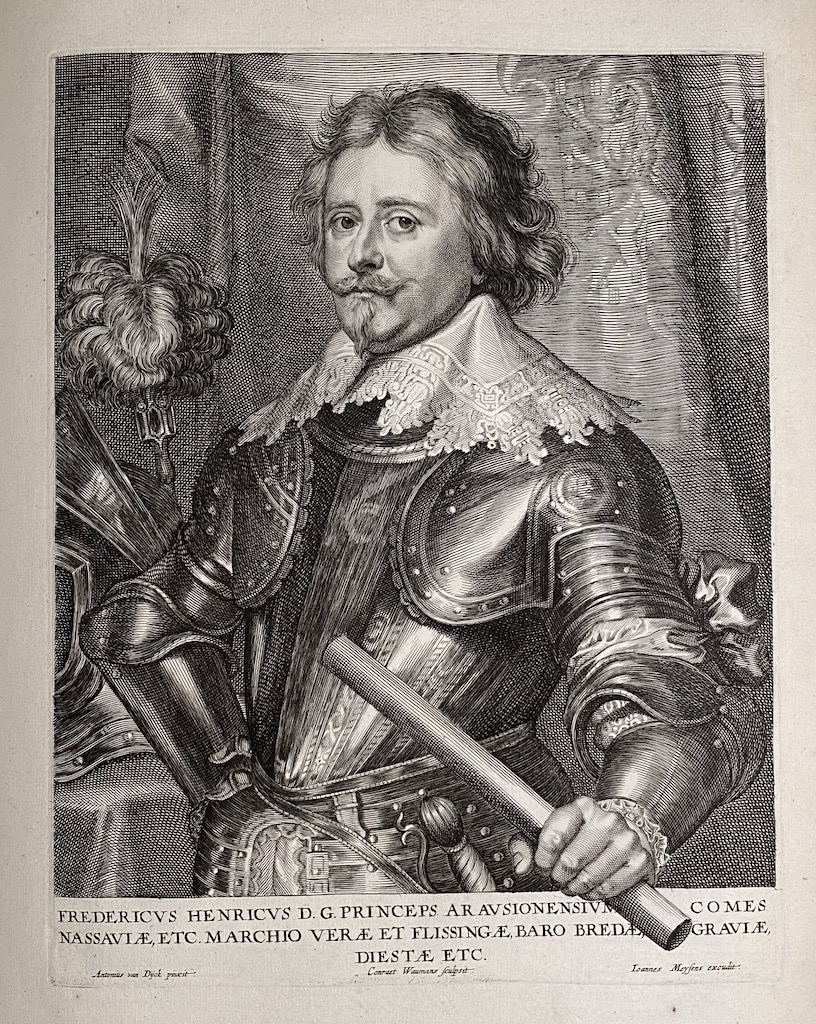
57. Frederick Henry, Prince of Orange, Count of Nassau (Dutch, 1584 – 1647); engraved by Conrad Waumans [Woumans] (Flemish, 1619 – after 1675). Inscription: “FREDERICVS HENRICVS, D.G. PRINCEPS ARAVSIONENSIVM, COMES | NASSAVIÆ, ETC. | MARCHIO VERÆ ET FLISSINGÆ, BARO BREDÆ GRAVÆ, | DIESTÆ ETC.”. Below: “Antonius van Dÿck pinxit” <–> “Conraet Waumans sculpsit” <–> “Ioannes Meyssens excudit.” First, lettered state with title and production details. [Similar to №5, but this one with Ioannes Meyssens name present]. 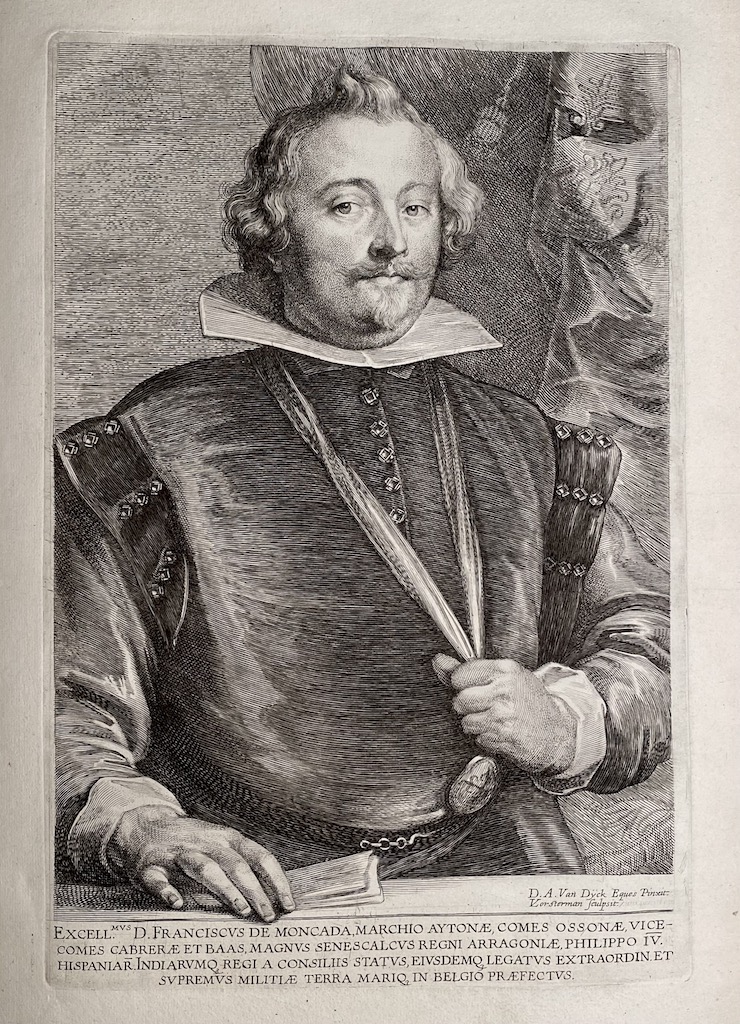
58. Francisco de Moncada, Count d’Osuna (Spanish, 1568 – 1635); engraved by Lucas Vorsterman I. Inscription: “EXCELL.MVS D. FRANCISCVS DE MONCADA MARCHIO AYTONÆ, COMES OSSONÆ VICE– | COMES CABRERÆ ET BAAS, MAGNVS SENESCALCVS REGNI ARRAGONIÆ, PHILIPPO IV. | HISPANIAR.INDIARVMQ3 REGI A CONSILIIS STATVS, EIVSDEMQ3 LEGATVS EXTRAORDIN,ET | SVPREMVS MILITIÆ TERRA MARIQ3 IN BELGIO PRÆFECTVS". Above within portrait frame, to the right: “D.A.van Dÿck pinxit. | LVorsterman sculpsit.”. 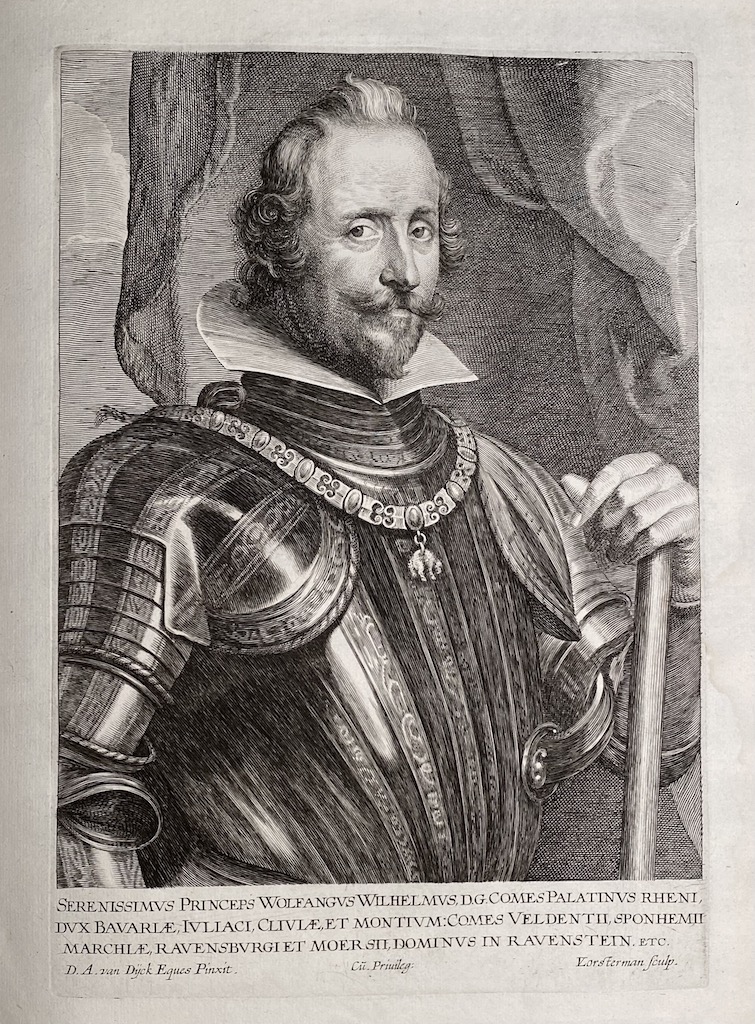
59. Wolfgang Wilhelm, Count of Pfalz-Neuburg and Duke of Jülich (German, 1578 – 1653); engraved by Lucas Vorsterman I. Inscription: "SERENISSIMVS PRINCEPS WOLFGANGVS WILHELMVS, D.G. COMES PALATINVS RHENI, | DVX BAVARIÆ, IVLIACÆ, ET MONTIVM :COMES VELDENTII, SPONHEMII | MARCHIÆ, RAVENSBVRGI ET MOERSII, DOMINVS IN RAVENSTEIN. ETC." In lower margin: "D. A. van Dÿck Eques Pinxit." <–> "Cū. Priuileg:" <–> "LVorsterman sculp.". Fifth state with initials of Gillis Hendricx burnished. British Museum # 1863,0509.825. 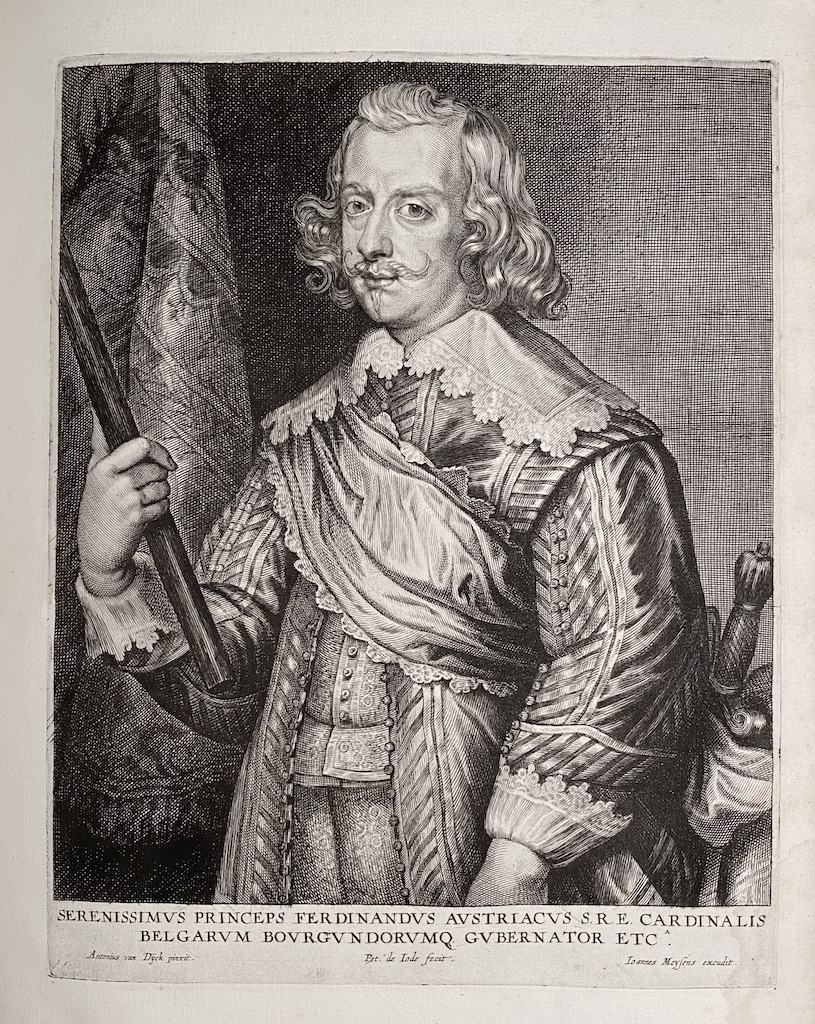
60. Ferdinand, Cardinal Infante of Spain and Archduke of Austria (Spanish, 1609 – 1641); engraved by Pieter de Jode II, published by Ioannes Meyssens. Inscription: “SERENISSIMVS PRINCEPS FERDINANDVS AVSTRIACVS S.R.E CARDINALIS | BELGARVM BORGVNDIORVMQ3 GVBERNATOR ETC.A”. In lower margin: “Antonius van Dÿck pinxit” <–> “Pet. de Iode fecit” <–> “Ioannes Meysens excudit”. Third, lettered state with title and production details. British Museum # R,1a.28. 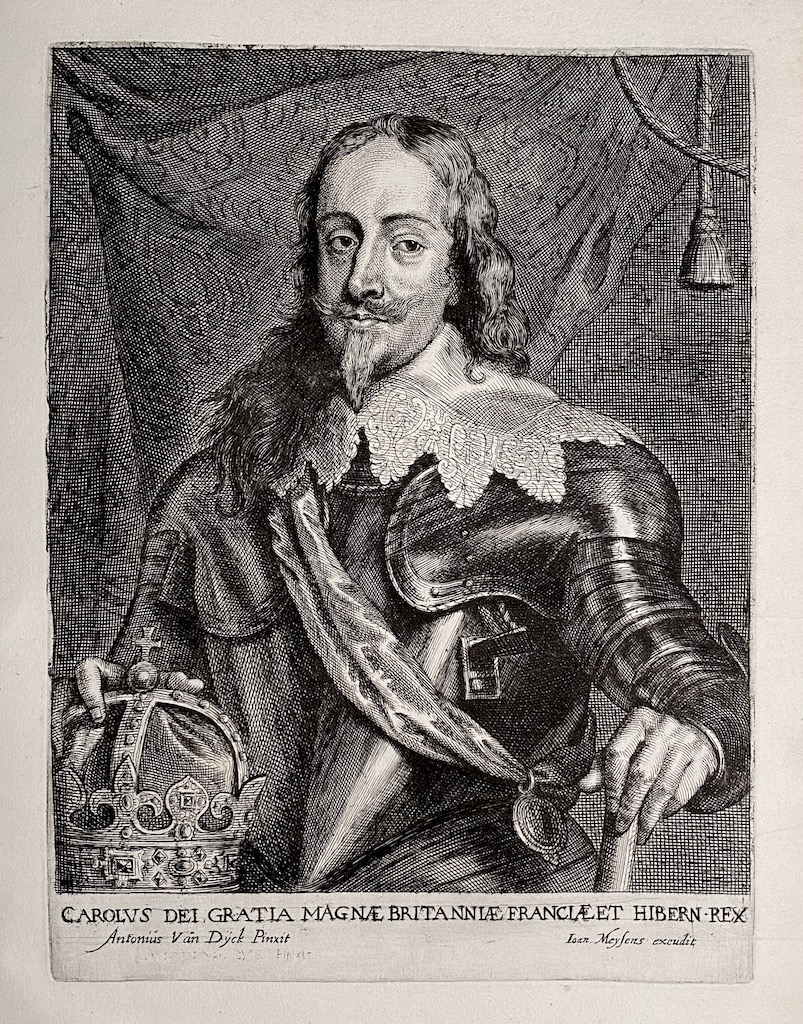
61. Charles I, King of England, Scotland, and Ireland (British, 1600 – 1649); engraved by Johannes [Jan] Meyssens (Flemish, 1612 – 1670). Inscription: “CAROLVS DEI GRATIA MAGNÆ BRITANNIÆ, FRANCIÆ ET HIBERNIÆ REX”. Below: “Antonius Van Dÿck eques pinxit” <–> “Ioan. Meysens excudit”. [Similar to №4, but with Ioannes Meysens name present]. 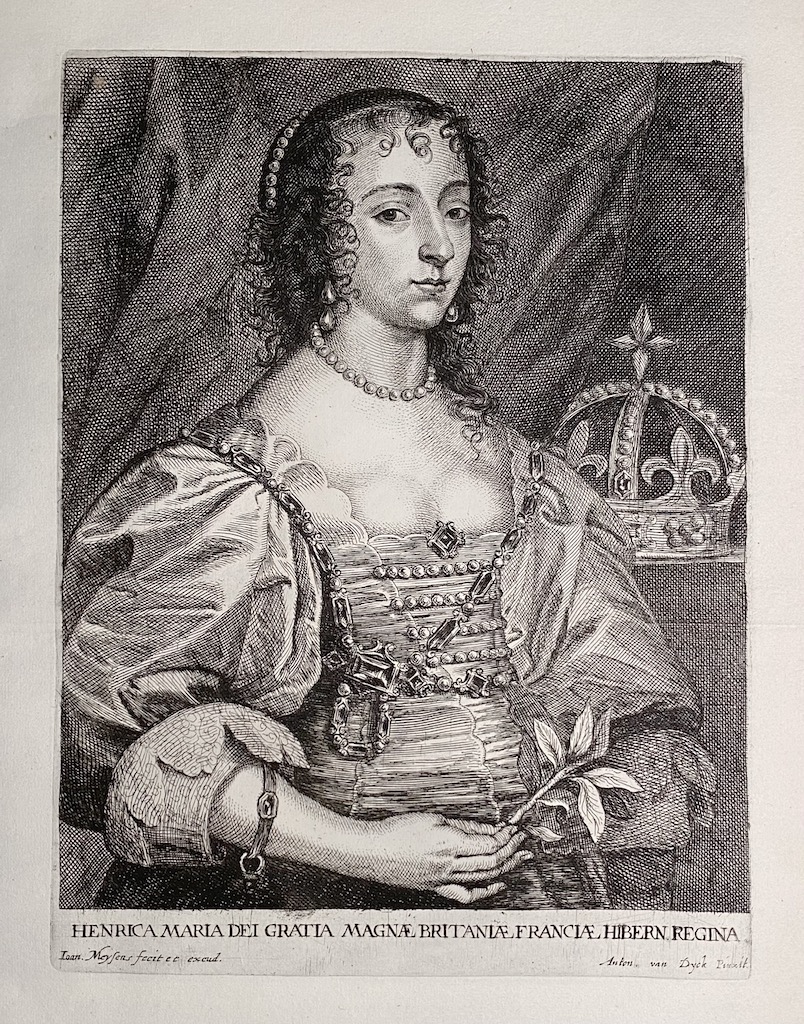
62. Henriette Marie de Bourbon, engraved and published by Ioannes Meyssens. Inscription: “HENRICA MARIA DEI GRATIA MAGNÆ BRITANIÆ FRANCIAÆ HIBERN. REGINA.” Lettered with production details in lower margin: “Ioan. Meysens fecit et excud.” <–> “Anton van Dyck Pinxit”. Third state, finished with a burin. [Similar to print №31, but this one with Ioan. Mey∫ens signature present]. 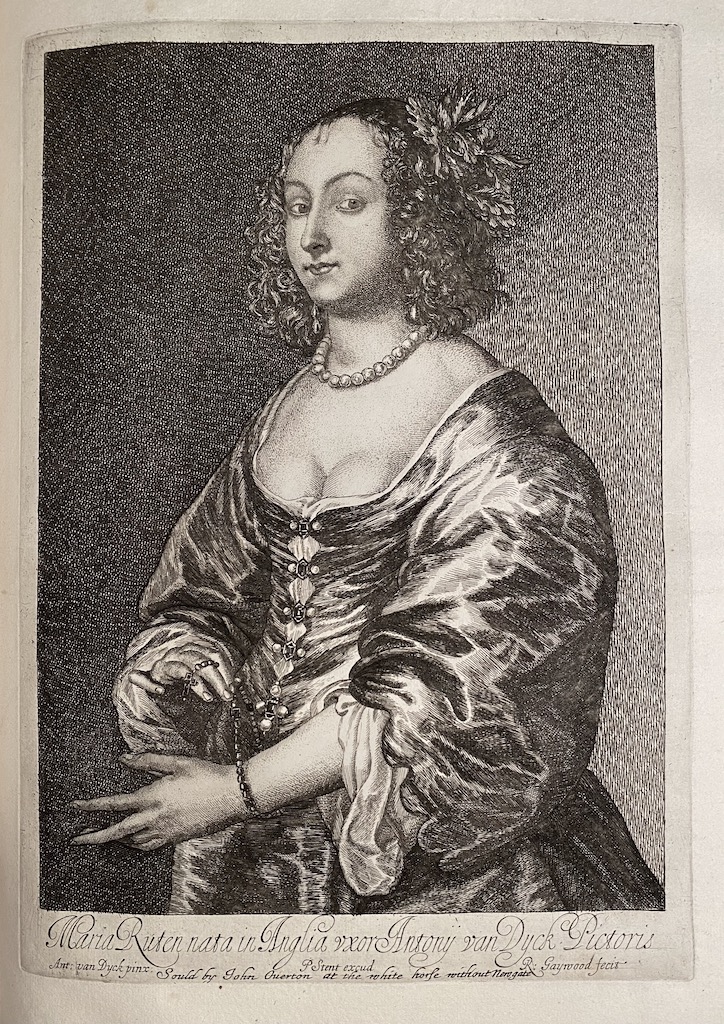
63. Mary Ruthven, Lady van Dyck (Scottish, c. 1622 – 1645); copy in reverse by Richard Gaywood after Bolswert (see also №51 by Meyssens) published by Peter Stent. Inscription: “Maria Ruten nata in Anglia vxor Antonÿ van Dyck Pictoris”. Below: “Ant: van Dyck pinx:”, “P Stent excud”, “R: Gaywood fecit”. Below centre: “Sould by John Ouerton at the white horse without New gate”. John Overton, publisher (British, 1639/40 – 1713); Richard Gaywood (British, fl. c. 1644 – 1677). Peter Stent (British, fl. c. 1637 – 1665). See BM # P,3.351. 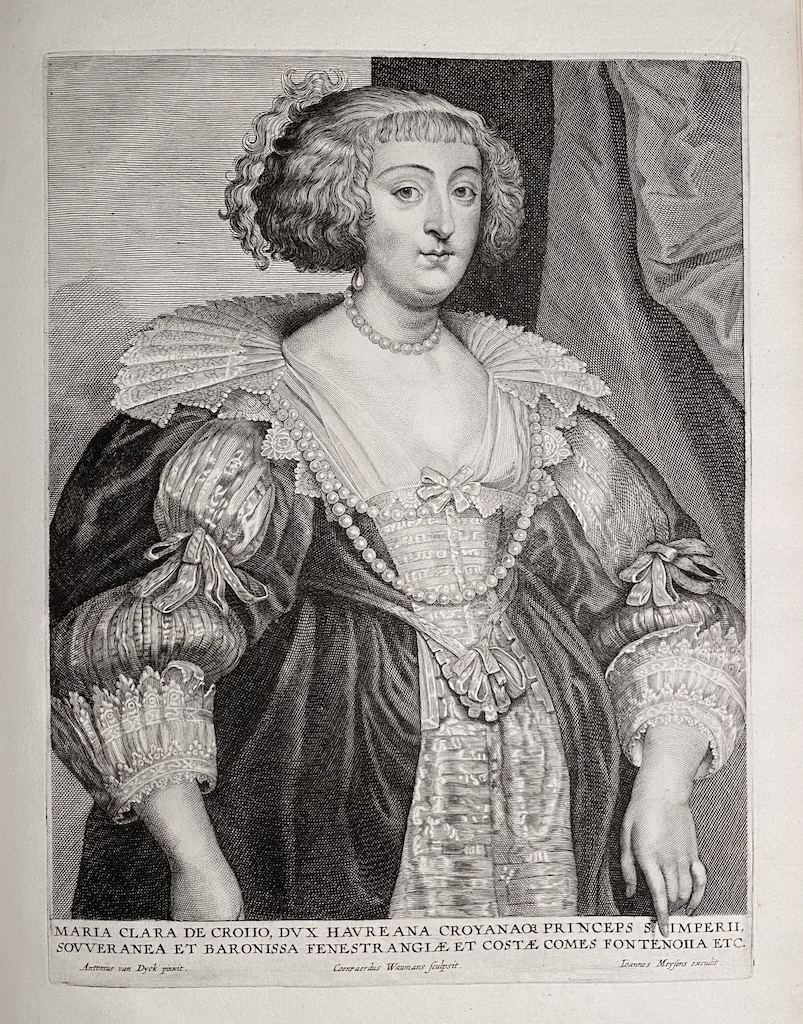
64. Marie-Claire de Croy, Duchess of Havré (Flemish, 1605 – 1664); engraved by Conraad Waumans, published by Ioannes Meyssens. Inscription: “MARIA CLARA DE CROIIO, DVX HAVREANA CROYANAQ3 PRINCEPS STE. IMPERII, | SOVVERANEA ET BARONISSA FENESTRANGIÆ ET COSTÆ COMES FONTENOIIA ETC”. In lower margin: “Antonius van Dyck pinxit.” <–> “Coenraerdus Waumans sculpsit.” <–> “Ioannes Meysens excudit.”. Second state. British Museum # R,1a.188. [Similar to №36, but this one with Ioannes Meysens name present]. 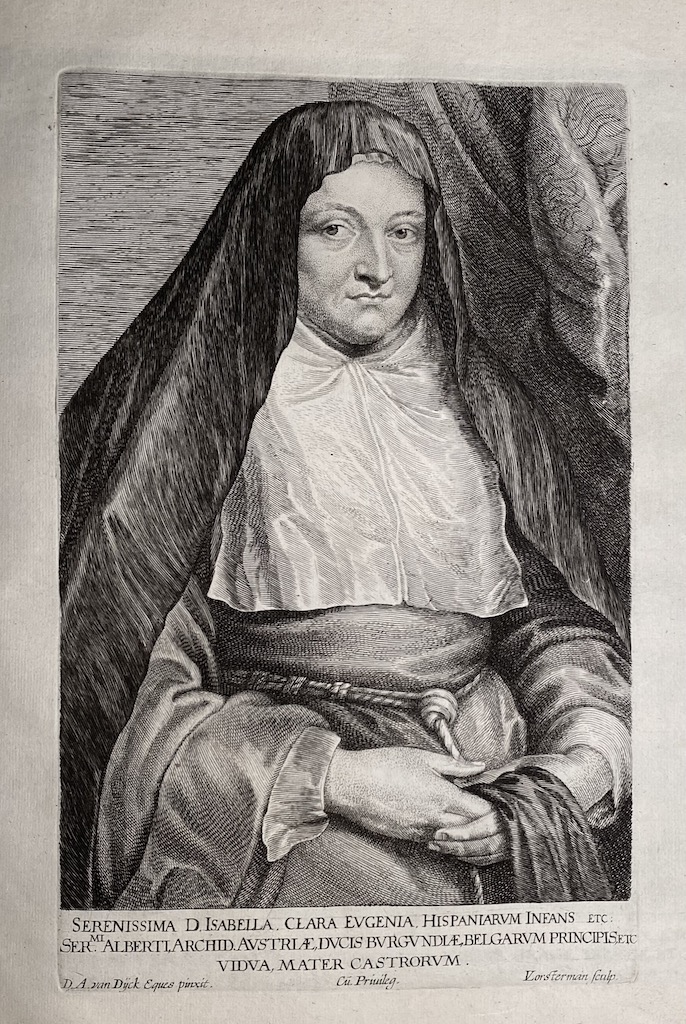
65. Isabel Clara Eugenia, ruler of the Spanish Netherlands (Spanish, 1566 – 1633); engraved by Lucas Vorsterman I. “SERENISSIMA D. ISABELLA. CLARA. EVGENIA. HISPANIARVM INFANS ETC. | SER.MI ALBERTI. ARCHID. AVSTRIÆ, DVCIS BVRGVNDIÆ, BELGARVM PRINCIPIS, ETC. | VIDVA, MATER CASTRORVM.” In lower margin: “D. A.van Dÿck Eques pinxit.” <–> “Cū Priuileg.” <–> “LVorsterman sculp.”. Fourth state with initials of Gillis Hendricx burnished. British Museum # 1863,0509.820. 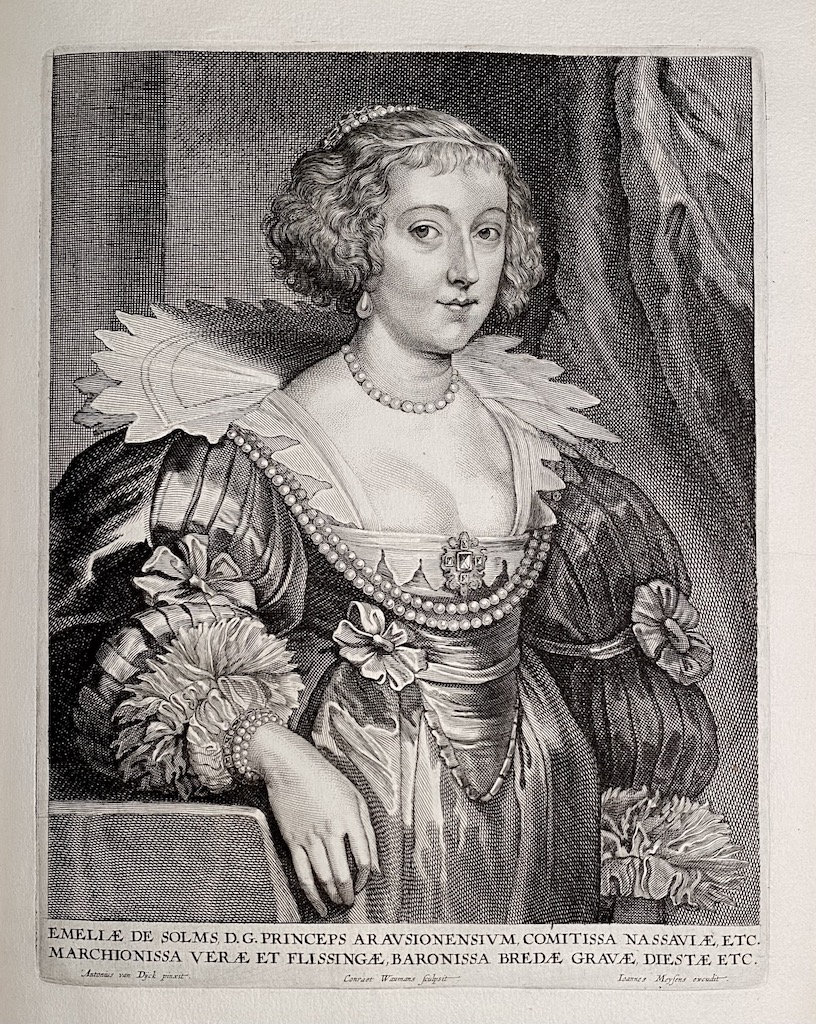
66. Amalia van Solms, Princess of Orange (German, 1602 – 1675), engraved by Conraad Waumans and published by Johannes Meyssens. Inscription: “EMELIÆ DE SOLMS, D. G. PRINCPES ARAVSIONENSIVM, COMITISSA NASSAUVIÆ, ETC. | MARCHIONISSA VERÆ ET FLISSINGÆ, BARONISSA BREDÆ, GRAVÆ, DIESTÆ ETC.” In lower margin: “Antonius van Dijck pinxit.”, “Conraet Waumans sculpsit.” and “Ioannes Meysens excudit.”. First, lettered state with the title and production details lettered. [Similar to №32, but this one with Ioannes Meysens name present]. 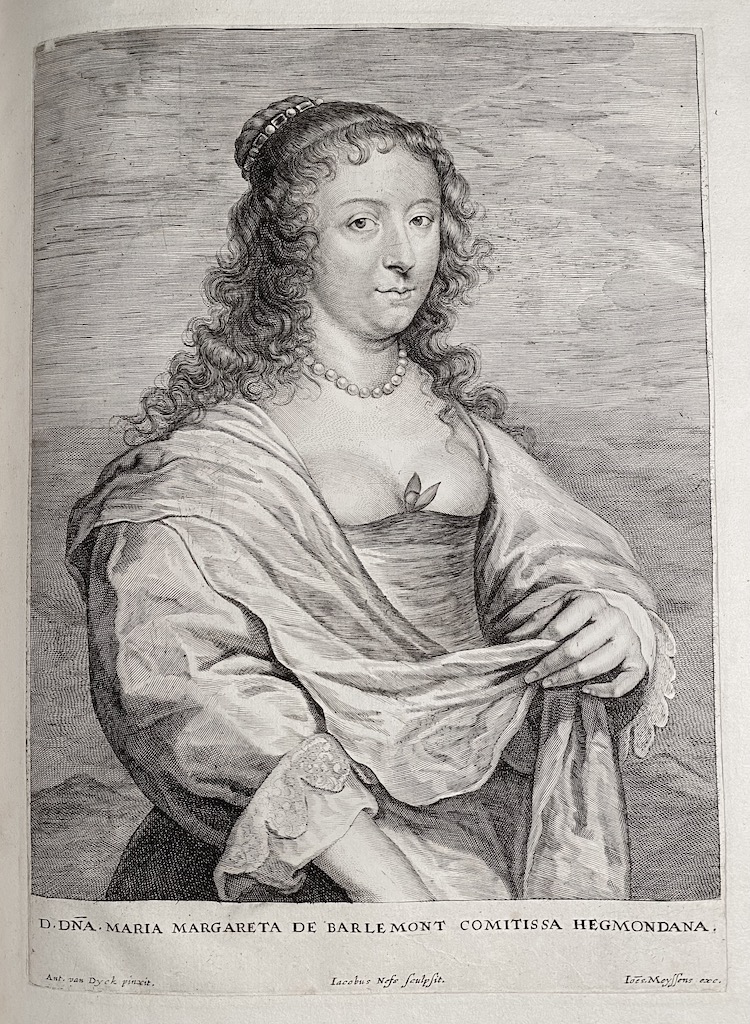
67. Marie-Marguerite de Berlaymont ( ? – 1654); engraved by Jacobus Neeffs, published by Ioannes Meyssens. Inscription: “D.DNA. MARIA MARGARETA DE BARLEMONT COMITISSA HEGMONDANA.” In lower margin: “Ant. van Dyck pinxit.” <–> “Iacobus Nefs sculpsit.” <–> “Ioes Meyssens exc.”. Fourth state. [Similar to №45, but this one with Ioannes Meysens name present]. 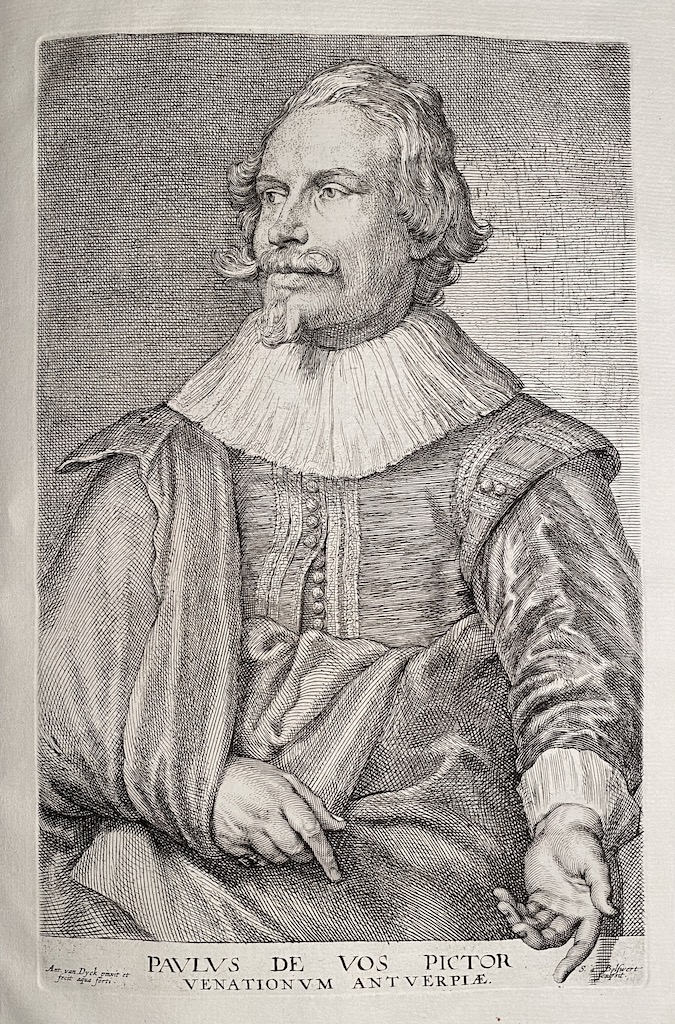
68. Paul de Vos (Flemich, 1596-1678); engraved and etched by Anthony van Dyck and by Schelte Adamsz. Bolswert, published by Gillis Hendricx. Eighth state with the initials of Gillis Hendricx burnished. Inscription: PAVLVS DE VOS PICTOR | VENATIONVM ANTVERPIÆ.”. “Ant. van Dyck pinxit et | fecit aqua forti.” <–> “S. à Bol∫wert | sculpsit. ”. [Look s very much alike №53, but with a two-line inscription and engraved by Bolswert instead of Meyssens, etc.]. 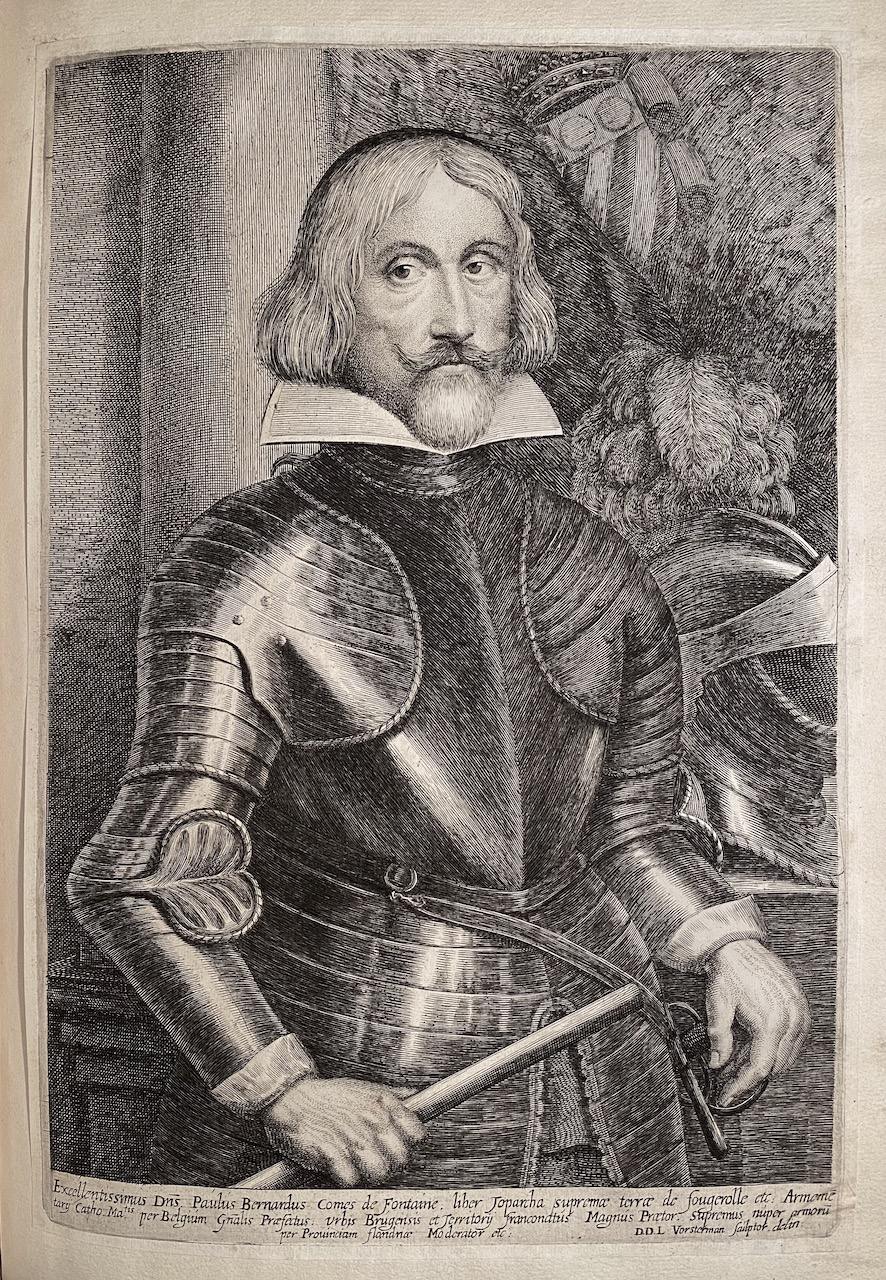
69. Paul-Bernard de Fontaines (French, 1566 – 1643) delineated and engraved by Lucas Vorsterman I (Flemish, 1595 – 1675) in 1615–75. Inscription: “Excellentissimus Dns. Paulus Bernardus Comes de Fontaine. liber Toparcha supremae terrae de fougerolle etc: Armeme tarij Catho. Matis. per Belgium Gnalis Praefectus: Vrbis Brugensis et Territorij fraconatus Magnus Praetor. Supremus nuper armpru Prouinciam flandriae Moderator etc: D.D.L Vorsterman sculptor. delin”. Cut without margins and pasted to inbound leaf. See: MET: Accession Number: 51.501.1332 -
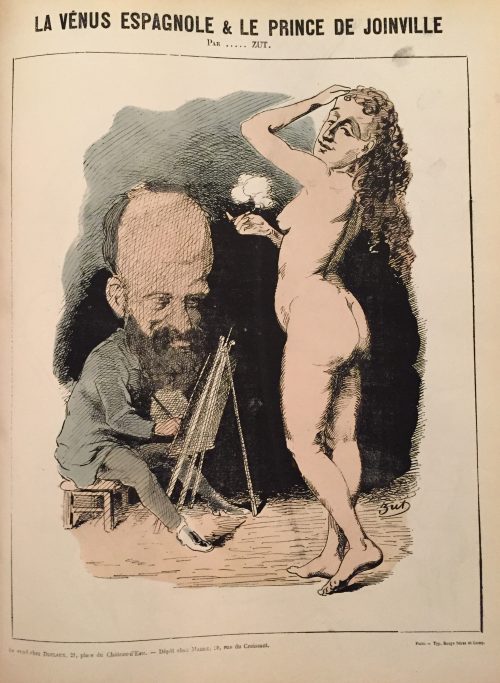 La vénus espagnole et le prince de Joinville par Zut [The Spanish Venus and the Prince of Joinville, by Zut]. Empress Eugénie poses naked for the Prince de Joinville holding a cigarette in her hand. He stares at her intently from his easel.
La vénus espagnole et le prince de Joinville par Zut [The Spanish Venus and the Prince of Joinville, by Zut]. Empress Eugénie poses naked for the Prince de Joinville holding a cigarette in her hand. He stares at her intently from his easel. -
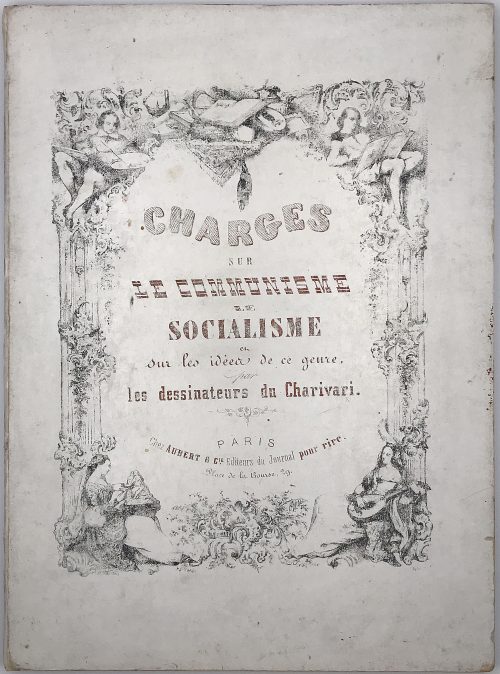 Charges sur le Communisme, le socialisme et sur les idées de ce genre par les dessinateurs du Charivari. Binding: original cardboard. Catalogue raisonée: Hazard & Delteil 1904 / Catalogue raisonné de l'oeuvre lithographié de Honoré Daumier [LIB-2176.2019 in this collection], p. 267: 20 illustrations by Daumier, Cham, Vernier, Ed. de Beaumont. Sticker: Vendu par Francois, Grande-Rue №33, à Rouen. Bought in Paris, seller claimed 1848, first edition. Similar title here : #31. Charges sur le communisme Le socialisme et sur les idées de ce genre par les dessinateurs. Paris, Chez Aubert & Cie., Éditeurs du Journal pour rire, sans date (vers 1865). Relié, plein cartonnage vert décoré et illustré de l'éditeur, in-folio (34,5 x 26 cm) de 20 planches lithographiées. 250 €. Caricatures par Cham (11), Gustave Janet (1), ADC (1), sans nom (3), Daumier (1), Lorentz-Jean-Paul Laurens (3). Nous trouvons pour ce même cartonnage des recueils différents à diverses périodes ; le nôtre doit dater des années 1865-67, moment où Jean-Pierre Laurens fut condamné par la justice du Second Empire pour son anticléricalisme.
Charges sur le Communisme, le socialisme et sur les idées de ce genre par les dessinateurs du Charivari. Binding: original cardboard. Catalogue raisonée: Hazard & Delteil 1904 / Catalogue raisonné de l'oeuvre lithographié de Honoré Daumier [LIB-2176.2019 in this collection], p. 267: 20 illustrations by Daumier, Cham, Vernier, Ed. de Beaumont. Sticker: Vendu par Francois, Grande-Rue №33, à Rouen. Bought in Paris, seller claimed 1848, first edition. Similar title here : #31. Charges sur le communisme Le socialisme et sur les idées de ce genre par les dessinateurs. Paris, Chez Aubert & Cie., Éditeurs du Journal pour rire, sans date (vers 1865). Relié, plein cartonnage vert décoré et illustré de l'éditeur, in-folio (34,5 x 26 cm) de 20 planches lithographiées. 250 €. Caricatures par Cham (11), Gustave Janet (1), ADC (1), sans nom (3), Daumier (1), Lorentz-Jean-Paul Laurens (3). Nous trouvons pour ce même cartonnage des recueils différents à diverses périodes ; le nôtre doit dater des années 1865-67, moment où Jean-Pierre Laurens fut condamné par la justice du Second Empire pour son anticléricalisme. -
 Artist: Utagawa Kunisada [歌川 国貞]; a.k.a. Utagawa Toyokuni III [三代歌川豊国] (Japanese, 1786 – 1865). Signed: Toyokuni ga [豊国 画] in a red toshidama cartouche. Publisher: Ibaya Senzaburō [伊場屋仙三郎] (Japanese, fl. C. 1845 – 1847), seal: San [三] (Marks 11-001 | 127c). Block carver: Matsushima Fusajirō [松嶋房次郎] (Japanese, fl. 1843 – 1850); seal [彫工房] – Hori kō Fusa. Double nanushi censor seal: Kunigasa & Watanabe (1849-50). Actor: Ichikawa Danjūrō VII [市川団十郎] (Japanese, 1791 – 1859); other names: Ichikawa Ebizō V [市川海老蔵], Ichikawa Hakuen II, Ichikawa Shinnosuke I. Play: Yukari no Hana Iro mo Yoshiwara [紫花色吉原], performed at the Kawarazaki Theater (Edo) from the 5th day of the 5th lunar month of Kaei 3 (1850) (see Kabuki Playbill at MFA (Boston) № 11.27996).
Artist: Utagawa Kunisada [歌川 国貞]; a.k.a. Utagawa Toyokuni III [三代歌川豊国] (Japanese, 1786 – 1865). Signed: Toyokuni ga [豊国 画] in a red toshidama cartouche. Publisher: Ibaya Senzaburō [伊場屋仙三郎] (Japanese, fl. C. 1845 – 1847), seal: San [三] (Marks 11-001 | 127c). Block carver: Matsushima Fusajirō [松嶋房次郎] (Japanese, fl. 1843 – 1850); seal [彫工房] – Hori kō Fusa. Double nanushi censor seal: Kunigasa & Watanabe (1849-50). Actor: Ichikawa Danjūrō VII [市川団十郎] (Japanese, 1791 – 1859); other names: Ichikawa Ebizō V [市川海老蔵], Ichikawa Hakuen II, Ichikawa Shinnosuke I. Play: Yukari no Hana Iro mo Yoshiwara [紫花色吉原], performed at the Kawarazaki Theater (Edo) from the 5th day of the 5th lunar month of Kaei 3 (1850) (see Kabuki Playbill at MFA (Boston) № 11.27996). Sano Jirōzaemon [佐野次郎左衛門] – provincial commoner who killed a famous Yoshiwara courtesan named ManjiyaYatsuhashi [万字屋 八ツ橋] (on the second sheet of the pair):
Sano Jirōzaemon [佐野次郎左衛門] – provincial commoner who killed a famous Yoshiwara courtesan named ManjiyaYatsuhashi [万字屋 八ツ橋] (on the second sheet of the pair):
Another Kunisada's print with the same characters in the same play and same performance can be seen at MFA (Boston) № 11.40190.
SVJP-0298.2019: Ichikawa Ebizō V as Sano Jirōzaemon.

SVJP-0297.2019: Iwai Kumesaburō III as Manjiya Yatsuhashi
 One more example can be seen at the two upper images in Waseda University Cultural Resources Database, № 006-2707:
One more example can be seen at the two upper images in Waseda University Cultural Resources Database, № 006-2707:

-
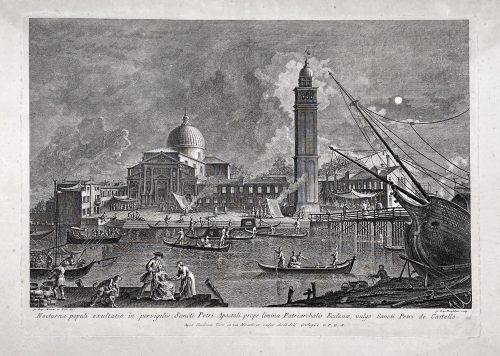
From the series of prints 'Prospectum Ædium Viarumque Insigniorum Urbis Venetiarum'. Inscribed below image left: "Jo. Bap. Moretti et Filii del. e Pinx."; right: "Jo. Baptista Brustoloni sculp."; in lower margin centre: "Nocturna populi exultatio in pervigilio Sancti Petri Apostoli prope limina Patriarchalis Ecclesiæ, vulgò Sancti Petri de Castello. / Apud Ludovicum Furlanetto supra Pontem vulgo dictum dei Baretteri C.P.E.S.". The third state, published by Teodoro Viero; the numbering on plate lower right, next to the inscription in Latin is cancelled as indicated by bibliography.
The subject is taken from a drawing by Giovanni Battista Moretti (Italian, active Venice, 1748-75) which in turn derives from a Canaletto painting. The print comes from the most important of Brustolon’s series, Prospectuum Aedium Viarumque Insignorum Urbis Venetiarum, dedicated to the Doge Marco Foscarini, from drawings by Canaletto, Moretti and sons and others, published for the first time by Ludovico Furlanetto in 1763 and later by Teodoro Viero. Giambattista Brustolon (1712–1796) was a famous Venetian engraver, a pupil of Joseph Wagner; whose talent is best displayed in his famous nocturnals: ‘riesce a dare il meglio di sé … nei famosi notturni’ (Succi).
Plate: 324 × 458 mm Sheet: 350 × 471 cm
References: The British Museum 1944,1014.209.48; The Metropolitan Museum of Art 60.611.29(4) (first state); Dario Succi, Da Carlevaris ai Tiepolo, 1983, pp.81-93, n. 55; William George Constable, J. G. Links, Canaletto: Giovanni Antonio Canal. 1697–1768. Oxford, 1989, vol. II, cat. no. 10, p. 674.
Condition: a very slight central fold, slight foxing and a very slight stain to the top, four small pinholes in corners, not affecting the engraving; else a well-margined copy in good condition.
-
 Artist: Utagawa Sadahide [歌川 貞秀], a.k.a. Gountei Sadahide [五雲亭 貞秀] (1807 – c. 1878/9). Publisher: Iseya Ichiemon [伊勢屋市右衛門] (Japanese, fl. c 1823 – 1864), seal name Kaku-Tsuji [角辻]. Signed: Gountei Sadahide ga [五雲亭貞秀画] Censor's seal: kiwame, date seal: Tenpō 3 (1832). Size: Uncut fan print (uchiwa-e); 218 x 282 mm. Portrait of a young woman dressed in a green kimono decorated with arabesque (karakusa) and flowers, her black obi adorned with a dragon, in a western-style frame, on a blue background; and a painting of a parrot on a pomegranate tree. A similar design was used by Sadahide in 1860, described in detail by Sebastian Izzard in his Japanese Prints of the Mid-Nineteenth Century: 1830–1865, September 20–October 24, 2006 exhibition: Picture of a Curio Shop in Yokohama: reverse painting on glass of a crimson parrot, coloured copperplate engraving of a mother and child (Yokohama urimono mise no zu: gyokuban abura-e, doban-e saishiki). Colour woodblock print: oban tate-e, 143/8 x 93/4 in. (36.5 x 24.8 cm.); Man-en I/3 (3/1860) Series: Picture of Goods for Sale in Yokohama (Yokohama urimono zue no uchi) Signature: Gountei Sadahide ga, double toshidama seal Publisher: Daikokuya Kinnosuke.
Artist: Utagawa Sadahide [歌川 貞秀], a.k.a. Gountei Sadahide [五雲亭 貞秀] (1807 – c. 1878/9). Publisher: Iseya Ichiemon [伊勢屋市右衛門] (Japanese, fl. c 1823 – 1864), seal name Kaku-Tsuji [角辻]. Signed: Gountei Sadahide ga [五雲亭貞秀画] Censor's seal: kiwame, date seal: Tenpō 3 (1832). Size: Uncut fan print (uchiwa-e); 218 x 282 mm. Portrait of a young woman dressed in a green kimono decorated with arabesque (karakusa) and flowers, her black obi adorned with a dragon, in a western-style frame, on a blue background; and a painting of a parrot on a pomegranate tree. A similar design was used by Sadahide in 1860, described in detail by Sebastian Izzard in his Japanese Prints of the Mid-Nineteenth Century: 1830–1865, September 20–October 24, 2006 exhibition: Picture of a Curio Shop in Yokohama: reverse painting on glass of a crimson parrot, coloured copperplate engraving of a mother and child (Yokohama urimono mise no zu: gyokuban abura-e, doban-e saishiki). Colour woodblock print: oban tate-e, 143/8 x 93/4 in. (36.5 x 24.8 cm.); Man-en I/3 (3/1860) Series: Picture of Goods for Sale in Yokohama (Yokohama urimono zue no uchi) Signature: Gountei Sadahide ga, double toshidama seal Publisher: Daikokuya Kinnosuke.
-
 Ogata Gekkō [尾形月耕] (Japanese, 1859 – 1920). An uchiwa-e (fan-print) of advertisement of tobacco of Kagoshima Prefecture, c. 1890 (Meiji Period). Barefoot Tengu* is sitting on a torii (entrance to a Shinto shrine), smoking a cigarette through a mouthpiece. _______ * Tengu [天狗] (heavenly dog) is a type of legendary creature found in Japanese folk religion and are also considered a type of Shinto god (kami) or yōkai (supernatural beings).
Ogata Gekkō [尾形月耕] (Japanese, 1859 – 1920). An uchiwa-e (fan-print) of advertisement of tobacco of Kagoshima Prefecture, c. 1890 (Meiji Period). Barefoot Tengu* is sitting on a torii (entrance to a Shinto shrine), smoking a cigarette through a mouthpiece. _______ * Tengu [天狗] (heavenly dog) is a type of legendary creature found in Japanese folk religion and are also considered a type of Shinto god (kami) or yōkai (supernatural beings). -
 Artist: Utagawa Kuniyoshi [歌川 國芳] (Japanese, 1798 – 1861).
Artist: Utagawa Kuniyoshi [歌川 國芳] (Japanese, 1798 – 1861).Title: Suzume fukube [美人団扇絵] (Sparrow and gourds).
Series: Kacho awase [花鳥合] (Collection of flowers and birds).
Publisher: Aritaya Seiemon [有田屋 清右衛門] (Japanese, fl. c. 1830 – 1862); Seal: Marks 17-011 | 014d.Signed: Ichiyosai Kuniyoshi ga in a red cartouche and sealed with paulownia crest (kiri mon).
Size: Uchiwa-e (untrimmed fan print) 296 x 230 mm.
Double nanushi censor seals: Kinugasa & Watanabe, Kaei 2-3 (1849–50).
Ref.: Kuniyoshi Project. -
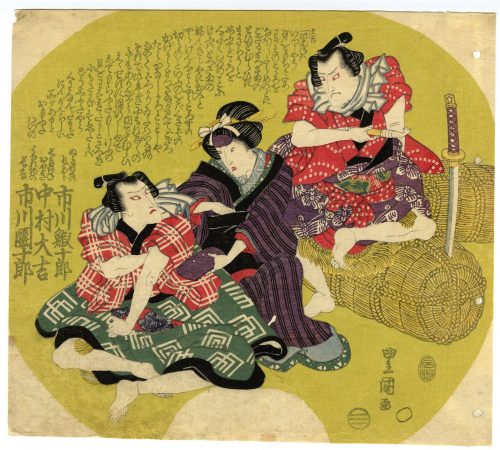 Artist: Utagawa Toyokuni I [歌川豊国] (1769–1825). Publisher: Ibaya Senzaburō [伊場屋 仙三郎] (fl. 1815 – 1869). Signed: Toyokuni ga [豊国 画]. Publisher's seal: Ibaya Sensaburō (Marks 08-067 | 127b). Date-aratame seal: Bunsei 3 (1820). Size: Uncut fan print (uchiwa-e), 224 x 254 mm. Ichikawa Ebijūrō I as Nuregami Chōgorō [濡髪の長五郎], Nakamura Daikichi as Hanaregoma Oseki [放駒のお関], and Ichikawa Danjūrō VII as Hanaregoma Chōkichi [放駒長吉] in a kabuki play Futatsu Chôchô Kuruwa Nikki [双蝶々曲輪日記] (A Diary of Two Butterflies in the Pleasure Quarters (see: LIB-0879.2015 | Brandon, James R., Leiter, Samuel L. Kabuki Plays on Stage: Brilliance and Bravado, 1697-1766 (Volume 1). — Honolulu: University of Hawai'i Press, 2002.) The play was performed at Kawarasakiza (Edo) in May of 1820. Actors: Ichikawa Ebijūrō I [市川鰕十郎] (Japanese, 1777 – 1827); other names: Ichikawa Ichizō I [市川市蔵], Ichinokawa Ichizō [市ノ川市蔵]. Nakamura Daikichi I [初代中村大吉](Japanese, 1773 – 1823); other names: Fujikawa Daikichi [藤川大吉]; poetry name Hajō [巴丈]; pen name Naruo Yatarō [藤川大吉]. Ichikawa Danjūrō VII 市川団十郎 (Japanese, 1791 – 1859); other names: Ichikawa Ebizō V, Ichikawa Hakuen II, Ichikawa Shinnosuke I.
Artist: Utagawa Toyokuni I [歌川豊国] (1769–1825). Publisher: Ibaya Senzaburō [伊場屋 仙三郎] (fl. 1815 – 1869). Signed: Toyokuni ga [豊国 画]. Publisher's seal: Ibaya Sensaburō (Marks 08-067 | 127b). Date-aratame seal: Bunsei 3 (1820). Size: Uncut fan print (uchiwa-e), 224 x 254 mm. Ichikawa Ebijūrō I as Nuregami Chōgorō [濡髪の長五郎], Nakamura Daikichi as Hanaregoma Oseki [放駒のお関], and Ichikawa Danjūrō VII as Hanaregoma Chōkichi [放駒長吉] in a kabuki play Futatsu Chôchô Kuruwa Nikki [双蝶々曲輪日記] (A Diary of Two Butterflies in the Pleasure Quarters (see: LIB-0879.2015 | Brandon, James R., Leiter, Samuel L. Kabuki Plays on Stage: Brilliance and Bravado, 1697-1766 (Volume 1). — Honolulu: University of Hawai'i Press, 2002.) The play was performed at Kawarasakiza (Edo) in May of 1820. Actors: Ichikawa Ebijūrō I [市川鰕十郎] (Japanese, 1777 – 1827); other names: Ichikawa Ichizō I [市川市蔵], Ichinokawa Ichizō [市ノ川市蔵]. Nakamura Daikichi I [初代中村大吉](Japanese, 1773 – 1823); other names: Fujikawa Daikichi [藤川大吉]; poetry name Hajō [巴丈]; pen name Naruo Yatarō [藤川大吉]. Ichikawa Danjūrō VII 市川団十郎 (Japanese, 1791 – 1859); other names: Ichikawa Ebizō V, Ichikawa Hakuen II, Ichikawa Shinnosuke I. -
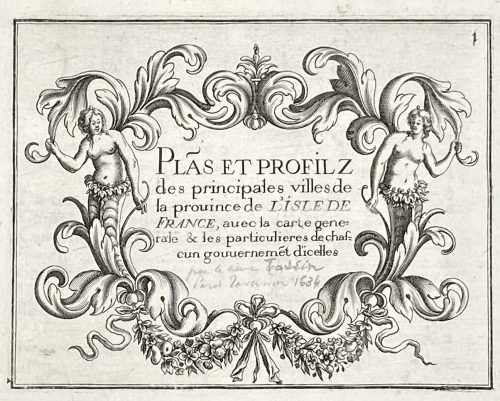 Title page: Text engraved within a vignette with two naked female torses in garlands: Plãs et profilz | des principales villes de | la prouince de L'ISLE DE | FRANCE, auec la carte gene~ | rale & les particulieres de chaf~ | cun gouuernement d'icelles. Below handwritten pencil inscription by a previous owner: "par ... Tassin ... 1634". Size: 17.6 x 23.7 cm, Binding: Italian style, green half-vellum, burgundy morocco title label with vertical gilt lettering to spine, peacock marbled boards. Pagination: Two blank flyleaves in the front and two in the back; 18 numbered engraved plates, including:
Title page: Text engraved within a vignette with two naked female torses in garlands: Plãs et profilz | des principales villes de | la prouince de L'ISLE DE | FRANCE, auec la carte gene~ | rale & les particulieres de chaf~ | cun gouuernement d'icelles. Below handwritten pencil inscription by a previous owner: "par ... Tassin ... 1634". Size: 17.6 x 23.7 cm, Binding: Italian style, green half-vellum, burgundy morocco title label with vertical gilt lettering to spine, peacock marbled boards. Pagination: Two blank flyleaves in the front and two in the back; 18 numbered engraved plates, including:- Title page
- Table of Contents
- Normandie
- Environs de Paris
- Folding map of Paris – a simplified copy of Mathieu Merian's 1615 perspective plan, with minor updates, notably on the current housing estate of Ile Saint-Louis.
- Paris
- Gouvernment de Soissons
- Soissons
- Gouvernment de Beauvais
- Beauvais
- Gouvernment de Compiègne
- Compiègne
- Gouvernment de Noyon
- Noyon
- Gouvernment de Coussi
- Coussi
- Gouvernment de Senlis
- Senlis
-
 Ichikawa Ebizo V (1791 – 1859) a.k.a. Ichikawa Danjûrô VII was a great-great-great-son of Ichikawa Danjûrô I. He started his stage career in 1794, at the age of 4, playing in Shibaraku (the role he is depicted here). During his stage life, he played every role type. He was later banished from Edo for living too luxurious life for an actor. While in exile he flourished in Kioto and Osaka. Kichirei (Festive Annual Custom). Publisher: Takenouchi Magohachi (Hoeidô) Circa 1833. Description: 役者の舞台姿を描いた「舞台姿」シリーズと、日常図を描いた「千社詣」シリーズがあり、同じ役者が向かい合って対になる。(『五渡亭国貞』). Signed: Gototei Kunisada ga [五渡亭国貞画]. Censor's seal: kiwame 改印:極. Ref.: Shindo, Gototei Kunisada Yakusha-e no Sekai (1993), plate 88; Utagawa Kunisada, 150th Anniversary of His Death, Ota Memorial Museum, no. 169; MFA ACCESSION NUMBER 11.43128.
Ichikawa Ebizo V (1791 – 1859) a.k.a. Ichikawa Danjûrô VII was a great-great-great-son of Ichikawa Danjûrô I. He started his stage career in 1794, at the age of 4, playing in Shibaraku (the role he is depicted here). During his stage life, he played every role type. He was later banished from Edo for living too luxurious life for an actor. While in exile he flourished in Kioto and Osaka. Kichirei (Festive Annual Custom). Publisher: Takenouchi Magohachi (Hoeidô) Circa 1833. Description: 役者の舞台姿を描いた「舞台姿」シリーズと、日常図を描いた「千社詣」シリーズがあり、同じ役者が向かい合って対になる。(『五渡亭国貞』). Signed: Gototei Kunisada ga [五渡亭国貞画]. Censor's seal: kiwame 改印:極. Ref.: Shindo, Gototei Kunisada Yakusha-e no Sekai (1993), plate 88; Utagawa Kunisada, 150th Anniversary of His Death, Ota Memorial Museum, no. 169; MFA ACCESSION NUMBER 11.43128. -
 Title: Eleventh lunar month (Chuto no zu); Series: Fashionable Twelve Months (Imayo juni-kagetsu). Another version of translation: Modern Beauties of Twelve Months. Artist: Utagawa Toyokuni I [歌川豊国] (1769–1825). Pubisher: Ibaya Senzaburō [伊場屋仙三郎] (Japanese, 1815 – 1869), seal: Dansendō [伊場仙]. Signed: Toyokuni ga and sealed with toshidama. Date-kiwame seal: Ushi (ox), Bunsei 5 (1822). Size: double-sheet uncut fan print ( aiban uchiwa-e), 219 x 295 mm.
Title: Eleventh lunar month (Chuto no zu); Series: Fashionable Twelve Months (Imayo juni-kagetsu). Another version of translation: Modern Beauties of Twelve Months. Artist: Utagawa Toyokuni I [歌川豊国] (1769–1825). Pubisher: Ibaya Senzaburō [伊場屋仙三郎] (Japanese, 1815 – 1869), seal: Dansendō [伊場仙]. Signed: Toyokuni ga and sealed with toshidama. Date-kiwame seal: Ushi (ox), Bunsei 5 (1822). Size: double-sheet uncut fan print ( aiban uchiwa-e), 219 x 295 mm.

-
 Utagawa Kunisada (Japanese: 歌川 国貞; also known as Utagawa Toyokuni III (三代歌川豊国); 1786 – 12 January 1865).
Utagawa Kunisada (Japanese: 歌川 国貞; also known as Utagawa Toyokuni III (三代歌川豊国); 1786 – 12 January 1865).A man with a shaved head (a monk), holding a paper lantern and an umbrella, walks with a young woman (a geisha) in the rain.
SIGNED: Gototei Kunisada ga [五渡亭国貞画]
Censor's seals: kiwame, futakata.
Blockcutter's mark: Seizô tô [改印:極、貳方]
MFA ACCESSION NUMBER 11.15150; MFA dating: about 1815–21 (Bunka 12–Bunsei 4);
Size: Vertical Ōban (382 x 260 mm). SOLD -
 Artist: Utagawa Kunisada [歌川 国貞], a.k.a. Utagawa Toyokuni III [三代 歌川 豊国] (Japanese, 1786 – 1865). Signed: Toyokuni ga [豊国 画] in a red toshidama cartouche Block carver: Yokokawa Takejirō [横川竹二郎] (Japanese, fl. 1845 – 1863), seal: 彫竹 – Hori Take. Publisher: Ibaya Senzaburō [伊場屋仙三郎] (Japanese, fl. c. 1845 – 1847). Combined date and kiwame seal: Ansei 5 (II-XII/1858). Size: Untrimmed fan print (uchiwa-e), 300 x 232 mm.
Artist: Utagawa Kunisada [歌川 国貞], a.k.a. Utagawa Toyokuni III [三代 歌川 豊国] (Japanese, 1786 – 1865). Signed: Toyokuni ga [豊国 画] in a red toshidama cartouche Block carver: Yokokawa Takejirō [横川竹二郎] (Japanese, fl. 1845 – 1863), seal: 彫竹 – Hori Take. Publisher: Ibaya Senzaburō [伊場屋仙三郎] (Japanese, fl. c. 1845 – 1847). Combined date and kiwame seal: Ansei 5 (II-XII/1858). Size: Untrimmed fan print (uchiwa-e), 300 x 232 mm.A young woman adjusting her hairpin on a balcony during the Tanabata festival, as inscribed on the white folding fan: [七夕] (Tanabata).
Inscription on the blue book (print title): Early autumn [はつ秋や] (hatsu akiya), inscription on the purple book (series title): Short love songs, second volume [端唄の意 二編] (Hauta no kokoro nihen). According to Marks (2010), Hauta no kokoro nihen series of fan prints was published by Ibaya in 1858 (p. 267|P6871).
The series refers to love songs of a certain type popular in late Edo. They were performed with the accompaniment of a shamisen, “Seven herbs of autumn, the song of the insects is not heard; the bodies of lightning bugs are burnt, and the precious writings of love are getting thinner like the song of the insects as I am waiting for you. So, on an early autumn evening, I spot the glitter of a lightning bug that lingered among the autumn grasses, and while listening to the pine cricket, I am singing with my heart troubled by love". [Tokyo National Museum; translation provided by Elena Varshavsky].Tanabata [たなばた] or [七夕] – meaning "Evening of the seventh", also known as the Star Festival [星祭] (Hoshi matsuri) – is a Japanese festival originating from the Chinese Qixi Festival. One popular Tanabata custom is to write one's wishes on a piece of paper and hang that piece of paper on a specially erected bamboo tree, in the hope that the wishes become true.
-
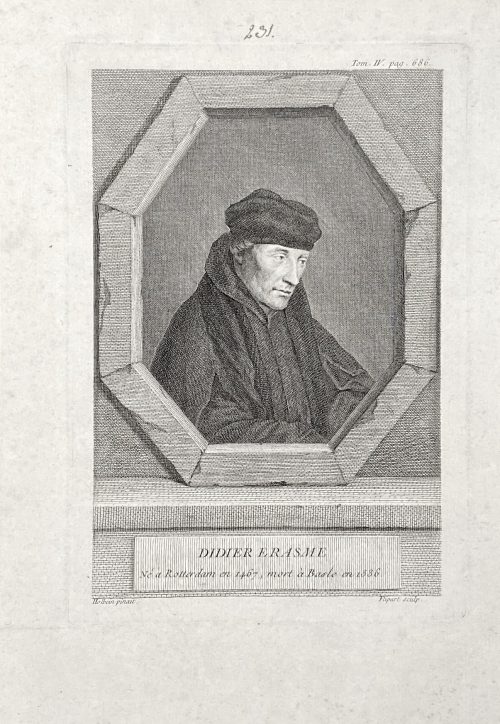 The portrait of Erasmus of Rotterdam (1466 – 1536), half-length, head to the right, body facing right, looking away, in a trompe-l'oeil octagonal frame. Inscriptions: Top right: Tom IV, pag. 686. Center of the image: DIDIER ERASME / Ne a Rotterdam en 1467, mort a Basle en 1536. Bottom of the plate: Holbein pinxit | Flipart Sculp. From the book Histoire générale des Provinces-Unies by Bénigne Dujardin (French, 1689 – 1771?) and Gottfried Sellius (real name Gottfried Sell) (1704? – 1767), published in 1757 in Paris by P. G. Simon. Volume 4, facing p. 686. Size: Sheet: 25 x 17.5 cm; Plate: 19.5 x 13.5 cm; Image: 18 x 12 cm. References: (1) Van Someren v.2, p.249, №1688; (2) https://archive.org/details/histoiregnra04duja/page/n714/mode/2up. Inscription above the plate: nut ink, hand, "231".
The portrait of Erasmus of Rotterdam (1466 – 1536), half-length, head to the right, body facing right, looking away, in a trompe-l'oeil octagonal frame. Inscriptions: Top right: Tom IV, pag. 686. Center of the image: DIDIER ERASME / Ne a Rotterdam en 1467, mort a Basle en 1536. Bottom of the plate: Holbein pinxit | Flipart Sculp. From the book Histoire générale des Provinces-Unies by Bénigne Dujardin (French, 1689 – 1771?) and Gottfried Sellius (real name Gottfried Sell) (1704? – 1767), published in 1757 in Paris by P. G. Simon. Volume 4, facing p. 686. Size: Sheet: 25 x 17.5 cm; Plate: 19.5 x 13.5 cm; Image: 18 x 12 cm. References: (1) Van Someren v.2, p.249, №1688; (2) https://archive.org/details/histoiregnra04duja/page/n714/mode/2up. Inscription above the plate: nut ink, hand, "231". -
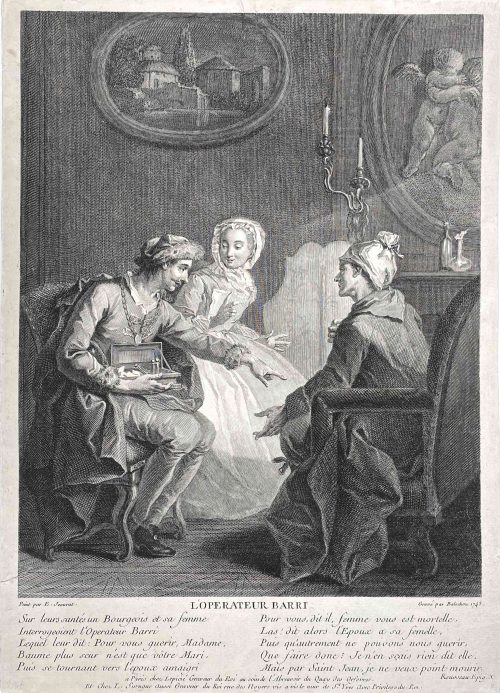
Engraving by J.J. Balechou after E. Jeaurat. A husband and wife ask a quack doctor for advice about health: he suggests substituting himself for the husband in the wife's affections, and she agrees: Épigrammes de Jean-Baptiste Rousseau (French, 1671–1741).
Date: 1743.
Size: 380 x 270 mm
Inscriptions under the image:
Top: Peint par E. Jeaurat | L'Operateur Barri | Grave par Balechou 1743
Middle: Sur leurs santés un Bourgeois et sa femme
Interrogeoient l'Operateur Barri, Lequel leur dit : Pour vous guérir, Madame, Baume plus sûr n'est que votre Mari, Puis se tournant vers l'époux amaigri, Pour vous, dit il, femme vous est mortelle, Las ! dit alors l'Epoux à sa femelle, Puis qu'autrement ne pouvons nous guérir, Que faire donc ? Je n'en sçai rien, dit elle,Mais, par Saint Jean, je ne veux point mourir.
Rousseau Epig. X
Center bottom: a Paris chez Lepicie Graveur du Roi au coin de l'Abreuvoir du Quay des Orfevres. Et Chez L. Surugue Aussi Graveur du Roi rue des Noyers vis a vis le mur de St. Yves Avec Privilege du Roi. -
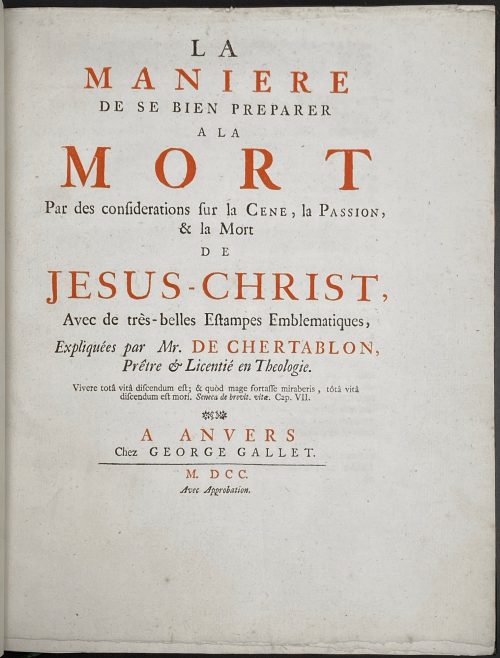 M. de Chertablon. La maniere de se bien preparer a la Mort par des Considerations sur la Cene, la Passion, et la Mort de Jesu-Christ. – Antwerp: George Gallet, 1700. Pagination: ff, [2 - blanks] [2 - t.p., blank] [3 - advert.] 4-63 [64]; 42 copper etched plates by Romeyn de Hooghe: A, B, C, 1-39; [20 - Dutch plate description of the David de la Vigne's Miroir de la bonne mort], bf. Full title: La maniere de se bien preparer a la Mort par des Considerations sur la Cene, la Passion, et la Mort de Jesu-Christ, Avec de très-belles Estampes Emblematiques, Expliquées par Mr. de Chertablon, Piêtre & Licentié en Theologie. Vivere totâ vitâ discendum est; & quòd mage fortasse miraberis, tôtâ vitâ discendum est mori. Seneca de brevit. vitæ. Cap. VII. A Anvers, Chez George Gallet. M DCC, Avec Approbation. / David de La Vigne. Spiegel om wel te sterven, annwyzende met beeltenissen van het lyden onses zaligmaakers Jesu Christi. Verzierd met 42 fyne Geërste Kopere Platen, Door Romain de Hooghe; Te Amsterdam, Voor dezen gedrukt by J. Stigter. Size: 4to, 27.2 x 21.6 cm. Binding: Late 19th century brown calf over marbled boards, spine with gilt lettering, raised bands, double fillet blind panels in compartments; marbled end-papers; bookplate of Samuel Ashton Thompson Yates library, AD 1894. Book illustrated with 42 copperplate etched engravings by Romeyn de Hooghe (Dutch, Amsterdam 1645–1708 Haarlem). According to Bonhams: the plates were "first printed for David de la Vigne's Miroir de la bonne mort. Each of the plates depicts a man contemplating a religious image in order to ease the passing of death, accompanied by commentary and an appropriate verse of scripture for each plate. The present French edition is bound with, as issued, the Dutch translation of David de La Vigne's aforementioned work."
M. de Chertablon. La maniere de se bien preparer a la Mort par des Considerations sur la Cene, la Passion, et la Mort de Jesu-Christ. – Antwerp: George Gallet, 1700. Pagination: ff, [2 - blanks] [2 - t.p., blank] [3 - advert.] 4-63 [64]; 42 copper etched plates by Romeyn de Hooghe: A, B, C, 1-39; [20 - Dutch plate description of the David de la Vigne's Miroir de la bonne mort], bf. Full title: La maniere de se bien preparer a la Mort par des Considerations sur la Cene, la Passion, et la Mort de Jesu-Christ, Avec de très-belles Estampes Emblematiques, Expliquées par Mr. de Chertablon, Piêtre & Licentié en Theologie. Vivere totâ vitâ discendum est; & quòd mage fortasse miraberis, tôtâ vitâ discendum est mori. Seneca de brevit. vitæ. Cap. VII. A Anvers, Chez George Gallet. M DCC, Avec Approbation. / David de La Vigne. Spiegel om wel te sterven, annwyzende met beeltenissen van het lyden onses zaligmaakers Jesu Christi. Verzierd met 42 fyne Geërste Kopere Platen, Door Romain de Hooghe; Te Amsterdam, Voor dezen gedrukt by J. Stigter. Size: 4to, 27.2 x 21.6 cm. Binding: Late 19th century brown calf over marbled boards, spine with gilt lettering, raised bands, double fillet blind panels in compartments; marbled end-papers; bookplate of Samuel Ashton Thompson Yates library, AD 1894. Book illustrated with 42 copperplate etched engravings by Romeyn de Hooghe (Dutch, Amsterdam 1645–1708 Haarlem). According to Bonhams: the plates were "first printed for David de la Vigne's Miroir de la bonne mort. Each of the plates depicts a man contemplating a religious image in order to ease the passing of death, accompanied by commentary and an appropriate verse of scripture for each plate. The present French edition is bound with, as issued, the Dutch translation of David de La Vigne's aforementioned work." -
 Utagawa Kunisada (Japanese: 歌川 国貞; also known as Utagawa Toyokuni III (三代歌川豊国); 1786 – 12 January 1865).
Utagawa Kunisada (Japanese: 歌川 国貞; also known as Utagawa Toyokuni III (三代歌川豊国); 1786 – 12 January 1865).A young woman adjusting her hairpins in the light of a paper lantern. Series: Arigataki miyo no kage-e (Shadow Pictures of an Auspicious Age). There are five known prints, half-length portraits of beauties, in this series, designed by Kunisada in ca. 1844. Another print from the series in this collection: SVJP-0309.2020: A young woman reading a book in the light of a lamp.
Signed: Kōchōrō Toyokuni ga (香蝶楼豊国画). Publisher: Maruya Kiyojiro.
Size: Vertical Ōban (37.5 x 25.4 cm). Utagawa (歌川) SOLD -
 Utagawa Kunisada (Japanese: 歌川 国貞; also known as Utagawa Toyokuni III (三代歌川豊国); 1786 – 12 January 1865).
Utagawa Kunisada (Japanese: 歌川 国貞; also known as Utagawa Toyokuni III (三代歌川豊国); 1786 – 12 January 1865).A young woman reading a book in the light of a lamp. Series: Arigataki miyo no kage-e (Shadow Pictures of an Auspicious Age). There are five known prints, half-length portraits of beauties, in this series, designed by Kunisada in ca. 1844. Another print from the series in this collection: SVJP-0306.2020: A young woman adjusting her hairpins in the light of a paper lantern.
Signed: Kōchōrō Toyokuni ga (香蝶楼豊国画).
Publisher: Maruya Kiyojiro.
Size: Vertical Ōban (37.5 x 25.4 cm). -
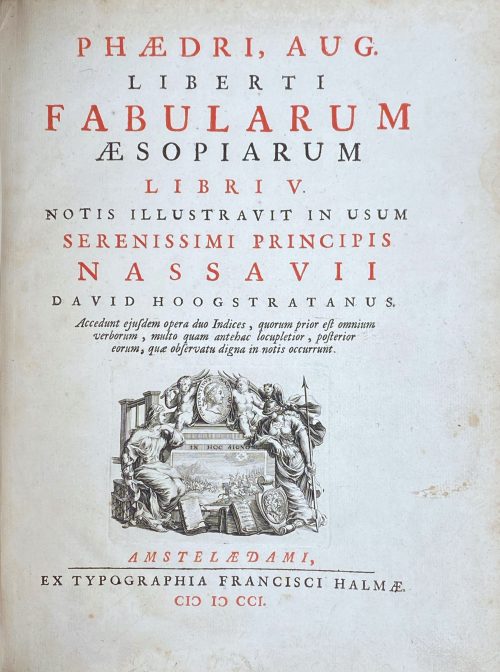 Phaedri, Aug. Liberti Fabularum Aesopiarum libri V / notis illustravit in usum serenissimi principis Nassavii David Hoogstratanus. Accedunt ejusdem opera duo indices, quorum prior est omnium verborum, multo quam antehac locupletior, posterior eorum, quae observatu digna in notis occurunt. — Amstelaedami : Ex Typographia Francisci Halmae, MDCCI [1701]. — pp.: [1] title, [1] (portr.), [32] 160, [84], 18 leaves of plates. Vita Phaedri is written by Johannes Schefferus (February 2, 1621 – March 26, 1679). Appendix fabularum is written by Marquard Gude (Gudius) (1 February 1635 – 26 November 1689). Gaius Julius Phaedrus was a 1st-century CE Roman fabulist and the first versifier of a collection of Aesop's fables into Latin. David van Hoogstraten (Rotterdam, March 14, 1658 - Amsterdam, November 21, 1724), a physician, poet and linguist, annotated the fables and dedicated them to Johan Willem Friso van Oranje-Nassau (14 August 1687 – 14 July 1711). The book was published in Amsterdam by François Halma (Langerak, January 3, 1653 - Leeuwarden, January 13, 1722), a Dutch printer, publisher and bookseller, with a portrait of Prince of Orange-Nassau, engraved by Pieter van Gunst (Dutch, Amsterdam 1659–1724) after Bernard Vaillant (Dutch, Lille 1632–1698 Leyden). The title page was engraved by P. Boutats after Jan Goeree (Dutch, Middelburg 1670–1731 Amsterdam). The edition is adorned throughout with 18 plates, each with 8 médaillons, designed and engraved by Jan van Vianen (Dutch, 1660–1726), and with vignettes, head- and tailpieces, inhabited initials, etc. Contemporary vellum over boards, title in red and back, red edges, 4to, 26 x 20 cm. Seller's description:4to, engraved general title, letterpress red & black title page with allegorical engraved vignette. 18 full-page copper-engraved plates by Jan van Vianen, each featuring six circular images, and 38 in-text reproductions, engraved decorative initials, and head- and tailpieces. Phaedrus (15 BC - 50 AD, Italy), was a "Roman fabulist, the first writer to Latinize whole books of fables, producing free versions in the iambic metre of Greek prose fables then circulating under the name of Aesop." (Ency. Brit.). This deluxe edition was specially created for the Prince of Nassau, profusely illustrated with fine engravings. Dibdin spoke highly of it in his Greek and Latin Classics (4th edition): "I have always considered this as a correct and very sumptuous edition. It is ornamented with a great number of small plates, or medallions, in which the subject of the fable is very ably and spiritedly executed.Ref.: Metropolitan Museum; Musée Médard
Phaedri, Aug. Liberti Fabularum Aesopiarum libri V / notis illustravit in usum serenissimi principis Nassavii David Hoogstratanus. Accedunt ejusdem opera duo indices, quorum prior est omnium verborum, multo quam antehac locupletior, posterior eorum, quae observatu digna in notis occurunt. — Amstelaedami : Ex Typographia Francisci Halmae, MDCCI [1701]. — pp.: [1] title, [1] (portr.), [32] 160, [84], 18 leaves of plates. Vita Phaedri is written by Johannes Schefferus (February 2, 1621 – March 26, 1679). Appendix fabularum is written by Marquard Gude (Gudius) (1 February 1635 – 26 November 1689). Gaius Julius Phaedrus was a 1st-century CE Roman fabulist and the first versifier of a collection of Aesop's fables into Latin. David van Hoogstraten (Rotterdam, March 14, 1658 - Amsterdam, November 21, 1724), a physician, poet and linguist, annotated the fables and dedicated them to Johan Willem Friso van Oranje-Nassau (14 August 1687 – 14 July 1711). The book was published in Amsterdam by François Halma (Langerak, January 3, 1653 - Leeuwarden, January 13, 1722), a Dutch printer, publisher and bookseller, with a portrait of Prince of Orange-Nassau, engraved by Pieter van Gunst (Dutch, Amsterdam 1659–1724) after Bernard Vaillant (Dutch, Lille 1632–1698 Leyden). The title page was engraved by P. Boutats after Jan Goeree (Dutch, Middelburg 1670–1731 Amsterdam). The edition is adorned throughout with 18 plates, each with 8 médaillons, designed and engraved by Jan van Vianen (Dutch, 1660–1726), and with vignettes, head- and tailpieces, inhabited initials, etc. Contemporary vellum over boards, title in red and back, red edges, 4to, 26 x 20 cm. Seller's description:4to, engraved general title, letterpress red & black title page with allegorical engraved vignette. 18 full-page copper-engraved plates by Jan van Vianen, each featuring six circular images, and 38 in-text reproductions, engraved decorative initials, and head- and tailpieces. Phaedrus (15 BC - 50 AD, Italy), was a "Roman fabulist, the first writer to Latinize whole books of fables, producing free versions in the iambic metre of Greek prose fables then circulating under the name of Aesop." (Ency. Brit.). This deluxe edition was specially created for the Prince of Nassau, profusely illustrated with fine engravings. Dibdin spoke highly of it in his Greek and Latin Classics (4th edition): "I have always considered this as a correct and very sumptuous edition. It is ornamented with a great number of small plates, or medallions, in which the subject of the fable is very ably and spiritedly executed.Ref.: Metropolitan Museum; Musée Médard -
 Utagawa Kunisada [歌川 国貞]; a.k.a. Utagawa Toyokuni III [三代歌川豊国] (Japanese, 1786 – 1865).
Utagawa Kunisada [歌川 国貞]; a.k.a. Utagawa Toyokuni III [三代歌川豊国] (Japanese, 1786 – 1865).Signed: Toyokuni ga [豊国 画] in a red toshidama cartouche.
Publisher: Kojimaya Jūbei (c. 1797-1869), seal: Hanmoto, Jū [板元, 十] (Marks 19-043 | 264c).
Double nanushi censor seals: Mera & Watanabe – Kaei 4 (1851).
Uncut fan print (uchiwa-e), 298 x 228 mm depicting a young woman adjusting her hairpin and holding a portable lantern (andon) on a marine background with the full moon, nearby boats and distant cormorant fishers. -
 Artist: Utagawa Kuniyoshi [歌川 國芳] (Japanese, 1798 – 1861) Publisher: British Museum provides for the title as Enkyoku-zoroi [艶曲揃] (Set of Voluptuous Melodies) and the publisher as Sanpei. Indeed, 三平 (Sanpei) was a wholesale fan shop at the end of the Edo period. However, Andreas Marks identifies the publisher's seal as 三平 Mihei = Mikawaya Heiroku (1848-56), a member of the Fan Producing Guild (AM 11-016|325a). Block carver: Yokokawa Takejirō, seal: Carver Taki [彫竹] (Hori Take)
Artist: Utagawa Kuniyoshi [歌川 國芳] (Japanese, 1798 – 1861) Publisher: British Museum provides for the title as Enkyoku-zoroi [艶曲揃] (Set of Voluptuous Melodies) and the publisher as Sanpei. Indeed, 三平 (Sanpei) was a wholesale fan shop at the end of the Edo period. However, Andreas Marks identifies the publisher's seal as 三平 Mihei = Mikawaya Heiroku (1848-56), a member of the Fan Producing Guild (AM 11-016|325a). Block carver: Yokokawa Takejirō, seal: Carver Taki [彫竹] (Hori Take)Signed: Ichiyosai Kuniyoshi ga in a red cartouche and sealed with paulownia (kiri mon).
Date seal and double nanushi censor seals: Fuku & Muramatsu, 1853 (Kaei 6, 2nd month).
Size: Uchiwa-e (untrimmed fan print) 296 x 230 mm.

SVJP-0303.2019
-
 Utagawa Kunisada [歌川 国貞] a.k.a. Utagawa Toyokuni III [三代歌川豊国] (Japanese, 1786 – 1865)
Utagawa Kunisada [歌川 国貞] a.k.a. Utagawa Toyokuni III [三代歌川豊国] (Japanese, 1786 – 1865)Promotional fan for a hairpin shop, with a poem by Ichikawa Danjuro VII, signed Hakuen.
Date seal plus rectangular kiwame seal: Bunsei 8 (1825).
Size: Fan print. Uchiwa-e (27.5 x 21.1 cm) Publisher seal: Maru-To (2) (Marks U204). Date seal plus rectangular kiwame seal: Bunsei 8 (1825). -
 Utagawa Kunisada [歌川 国貞] a.k.a. Utagawa Toyokuni III [三代歌川豊国] (Japanese, 1786 – 1865).
Utagawa Kunisada [歌川 国貞] a.k.a. Utagawa Toyokuni III [三代歌川豊国] (Japanese, 1786 – 1865).Uncut fan print (uchiwa-e), 295 x 230 mm, depicting kabuki actor Bandō Shūka I as Shirai Gonpachi (白井権八) reading a scroll by the light of a lantern. From the series A Parody of the Five Chivalrous Commoners; a Cup of Sake From Their Fans (Mitate gonin otoko, go-hiiki no omoizashi). According to Paul Griffith, the term omoizashi refers to the act of pouring a cup of sake for one's chosen partner, here giving an impression of intimacy and affection between famous actors and their patrons.
Actor: Bandō Shūka I [初代坂東しうか] (Japanese, 1813-1855); other names: Bandō Tamasaburō I, Bandō Mitsugorō V (posthumously). The print was probably published by some unknown Yama-Ta (Marks U421b). Double nanushi censor seals and date seal: Muramatsu and Fuku, Kaei 5, 2nd month (2/1852). As Kabuki Encyclopedia put it: "Gonpachi. A parasite. From the character named Shirai Gonpachi who lives at the home of Banzui Chōbei and sponges off him" (An English-Langauge Adaptation of Kabuki Jiten. Samuel L. Leiter. Greenwood Press, 1979, pp. 26, 98-9). There were many kabuki plays based on the story of the lovers Miura-ya Komurasaki and Shirai Gonpachi. (See: [LIB-2226.2019] Algernon Bertram Freeman-Mitford. Tales of Old Japan. — London: Macmillan and Co., 1883). Ref.: Art shop Ezoshi Ukiyoe new collection news, vol. 66, 2023.1 (Jan) # 31, p.8. -
 Utagawa Kunisada [歌川 国貞]; a.k.a. Utagawa Toyokuni III [三代歌川豊国] (Japanese, 1786 – 1865). Signed: Toyokuni ga [豊国 画] in a red toshidama cartouche. Publisher: Ibaya Senzaburō [伊場屋仙三郎] (Japanese, fl. 1815 – 1869). Block carver: Yokokawa Takejirō [横川竹二郎] (Japanese, fl. 1845 – 1863), seal: 彫竹 – Hori Take. Date seal and aratame censor seal: May of the Year of Dragon [辰五] (Tatsu-go) (5/1856) (Not in Marks).
Utagawa Kunisada [歌川 国貞]; a.k.a. Utagawa Toyokuni III [三代歌川豊国] (Japanese, 1786 – 1865). Signed: Toyokuni ga [豊国 画] in a red toshidama cartouche. Publisher: Ibaya Senzaburō [伊場屋仙三郎] (Japanese, fl. 1815 – 1869). Block carver: Yokokawa Takejirō [横川竹二郎] (Japanese, fl. 1845 – 1863), seal: 彫竹 – Hori Take. Date seal and aratame censor seal: May of the Year of Dragon [辰五] (Tatsu-go) (5/1856) (Not in Marks). Uncut fan print (uchiwa-e) depicting Onoe Kikugorō IV as Karukaya Dōshin parting from his son, Ishidomaru (played by Ichimura Uzaemon XIII), and Kawarasaki Gonjūrō I as Yamazakiya Yogoro in the kabuki play Karukaya Dōshin Tsukushi no Iezuto [苅萱桑門筑紫𨏍], written by Namiki Sōsuke [並木宗輔] (Japanese, 1695 – 1751) and performed at Ichimuraza [市村座] in 05/1856.
Media: Fan print [団扇絵] (Uchiwa-e); size: 235 x 305 mm.
Actors:
Onoe Kikugorō IV [四代目 尾上菊五郎] (Japanese, 1808 – 1860); other names: Onoe Baikō IV, Onoe Eizaburō III, Onoe Kikue, Nakamura Tatsuzō, Nakamura Kachō.
Onoe Kikugorō V [五代目尾上菊五郎] (Japanese, 1844 – 1903 other names: Onoe Baikō V, Ichimura Kakitsu IV, Ichimura Uzaemon XIII [十三代目市村羽左衛門], Ichimura Kurōemon.
Ichikawa Danjūrō IX [市川団十郎] (Japanese, 1838 – 1903); other names: Kawarasaki Sanshō, Kawarasaki Gonnosuke VII, Kawarasaki Gonjūrō I, Kawarasaki Chōjūrō III.
Plot: It was a popular belief at one time that jealous women had their hair transformed into writhing serpents and Kato Sayemon Shige-Uji, a daimyo of Tsukushi, a much-married man, suffered from the delusion that his wife was so affected. He fled to the mountains to escape her and led the life of a hermit under the name of Karukaya Doshin [苅萓道心]. One day, on Mount Kōya (高野山, Kōyasan) Karukaya meets a young man who was wandering in the mountains. Being questioned, the youth tells his name, Ishidomaru, and elicits the information that he is seeking his lost father. Karukaya then recognizes the boy as his own son, but firm in the resolve to remain lost to the world, he refrains from disclosing himself, and bids the youth return home.
Provenance: Paul F. Walter (American, 1935 – 2017).
Ref.:
Uncut fan print (uchiwa-e) depicting Onoe Kikugorō IV as Karukaya Dōshin parting from his son, Ishidomaru (played by Ichimura Uzaemon XIII), and Kawarasaki Gonjūrō I as Yamazakiya Yogoro in the kabuki play Karukaya Dōshin Tsukushi no Iezuto [苅萱桑門筑紫𨏍], written by Namiki Sōsuke [並木宗輔] (Japanese, 1695 – 1751) and performed at Ichimuraza [市村座] in 05/1856.
Media: Fan print [団扇絵] (Uchiwa-e); size: 235 x 305 mm.
Actors:
Onoe Kikugorō IV [四代目 尾上菊五郎] (Japanese, 1808 – 1860); other names: Onoe Baikō IV, Onoe Eizaburō III, Onoe Kikue, Nakamura Tatsuzō, Nakamura Kachō.
Onoe Kikugorō V [五代目尾上菊五郎] (Japanese, 1844 – 1903 other names: Onoe Baikō V, Ichimura Kakitsu IV, Ichimura Uzaemon XIII [十三代目市村羽左衛門], Ichimura Kurōemon.
Ichikawa Danjūrō IX [市川団十郎] (Japanese, 1838 – 1903); other names: Kawarasaki Sanshō, Kawarasaki Gonnosuke VII, Kawarasaki Gonjūrō I, Kawarasaki Chōjūrō III.
Plot: It was a popular belief at one time that jealous women had their hair transformed into writhing serpents and Kato Sayemon Shige-Uji, a daimyo of Tsukushi, a much-married man, suffered from the delusion that his wife was so affected. He fled to the mountains to escape her and led the life of a hermit under the name of Karukaya Doshin [苅萓道心]. One day, on Mount Kōya (高野山, Kōyasan) Karukaya meets a young man who was wandering in the mountains. Being questioned, the youth tells his name, Ishidomaru, and elicits the information that he is seeking his lost father. Karukaya then recognizes the boy as his own son, but firm in the resolve to remain lost to the world, he refrains from disclosing himself, and bids the youth return home.
Provenance: Paul F. Walter (American, 1935 – 2017).
Ref.:
- [LIB-2110.2019] Samuel L. Leiter. Historical Dictionary of Japanese Traditional Theatre (Historical Dictionaries of Literature and the Arts). / 2nd edition. – Lanham: Rowman & Littlefield, 2014; pp. 379-380.
- [LIB-2206.2019] Basil Stewart. Subjects portrayed in Japanese colour-prints. — London: Kegan Paul, Trench, Trubner & Co. Ltd., 1922.
-
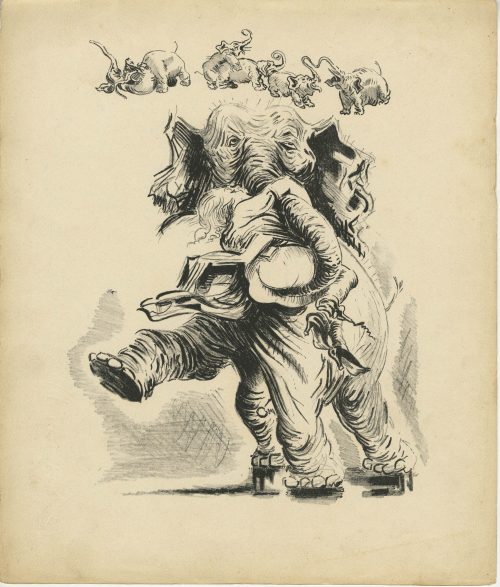
Album of 20 hand-coloured lithographs with a title page and a 'justification du tirage' page in an original snakeskin-clothed cardboard binder. Drawn on stone by Anonymous, attributed to Santippa. The theme of these pictures can be described as erotic humour.
Edition: 200 copies printed in Bruxelles, c. 1938; this copy without a number.
Watermarked wove paper: Word "Marais" and a flower.
Dimensions: 24.3 x 29.3 cm According to J.-P. Dutel, the author of these images is Georges Hoffmann under the pseudonym Santippa. Honesterotica provides a different name: Gaston Hoffmann [Santippa] (French, 1883 – 1977), which seems adequate. Catalogue raisonné: Dutel (1920-70): 2496. -
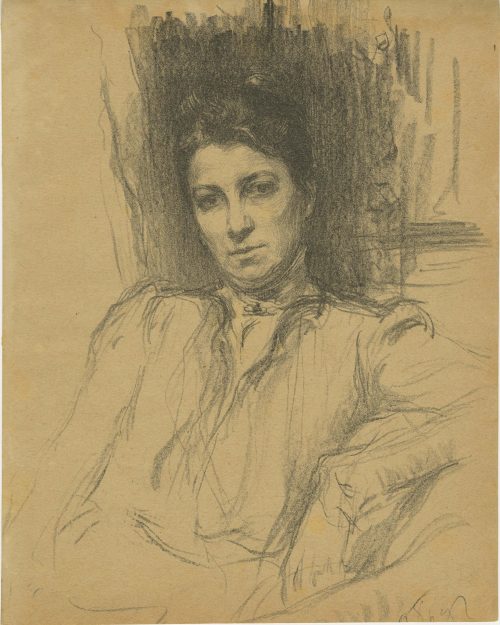
Portrait of Russian actress Maria Gavrilovna Savina, a lithograph on tan paper, by artist Osip Braz, 1900.
Maria Gavrilovna Savina (Мария Гавриловна Савина), a renowned Russian stage actress, born as Maria Podramentsova (Подраменцова) on April 11, 1854 in Kamianets-Podilskyi (Ukraine, Russian Empire) and died on September 21, 1915, in Saint Petersburg. Osip Emmanuilovich Braz (Осип Эммануилович Браз; 16 January 1873 in Odessa - 6 November 1936 near Paris) was a Russian painter of Jewish descent. Imprisoned by the Soviets in 1924 (the Solovki special prison-camp), released in 1926 and emigrated to Germany in 1928. Married to Lola Landshoff. http://russia-ic.com/people/culture_art/b/805/ "All his family members suffered from severe tuberculosis. After losing his wife Lola Lantsgof and both sons, he spent the last year of his life alone. Osip Braz passed away on November 6, 1936, and was laid down to rest at the Bagneux Cemetery in Paris." Buried at Bagneux, Hauts-de-Seine, Île-de-France, France. -
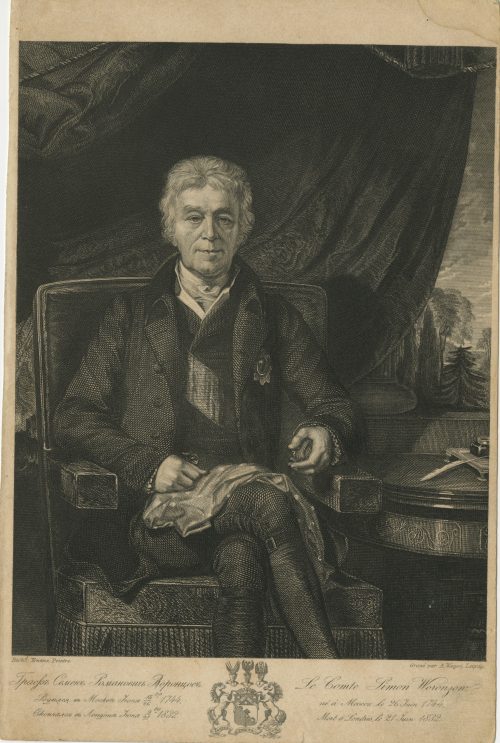
Seated portrait of Russian diplomat Count Semyon Romanovich Vorontsov (Семён Романович Воронцо́в; 26 June 1744 – 9 July 1832). Engraved by August Weger (Born: 1823 in Nürnberg; died: 1892 in Leipzig) from the portrait painted by Richard Evans (1784–1871). Circa 1825-50. Semyon Romanovich Vorontsov, the son of Count Roman Illarionovich and Marfa Ivanovna Surmina, was born on June 15, 1744; Active Privy Councillor; Ambassador to Venice and London from 1784, for over 20 years. Died in London on June 26, 1832.
Inscription: Графъ Семенъ Романовичь Воронцовъ. Родился въ Москвѣ Iюня 15-го/26 1744, Скончался въ Лондонѣ Iюня 9-го/21 1822. | Le Comte Simon Woronzow. né à Moscou le 26 Juin 1744, Mort à Londres le 21 Juin 1832. | Richd. Evans, Peintre. - Gravé par A. Weger, Leipzig. Vorontsov family coat of arms in the middle.
Dimensions: 23 x 15 cm. Ref.: Подробный словарь русских гравированных портретов Д. А. Ровинского, том. 1, 534-540. -
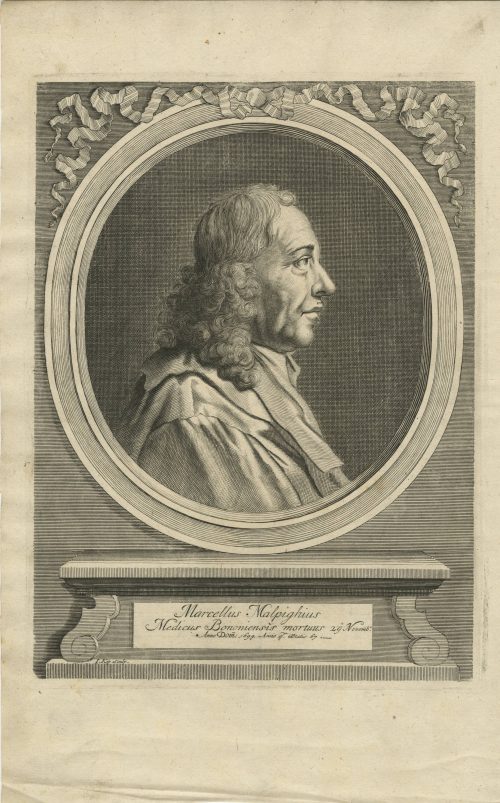
A portrait of Marcello Malpighi from his book Opera posthuma: figuris aeneis illustrata, quibus praefixa est ejusdem vita a seipso scripta, Londini:Churchill, 1697. Inscription: Marcellus Malpighius | Medicus Bononiensis mortuus 29 Novemb. Anno Dom. 1694. Anno aetatis 67. I. Kip. sculp.
Marcello Malpighi (10 March 1628 – 29 November 1694) was an Italian biologist and physician, who is referred to as the "Father of microscopical anatomy, histology, physiology and embryology" [Wikipedia].
From European Journal of Anatomy 22(5):433-439 · September 2018, an article by Sanjib Ghosh and Ashutosh Kumar 'Marcello Malpighi (1628-1694): Pioneer of microscopic anatomy and exponent of the scientific revolution of the 17th Century': Italian anatomist and an eminent scientist who significantly contributed to the advancement of the anatomical sciences in the 17th century. Malpighi was one of the first to use the compound microscope (an instrument designed by Galileo in 1609) and made the most important discovery of his life in 1661 when he identified capillaries as connecting vessels between small arteries and veins in the lungs. Malpighi thus provided the missing link in William Harvey's theory of blood circulation. He made significant contributions in the field of embryology based on his observations on chick embryo, and his efforts provided deep insights into the development of the heart and the nervous system. His communications based on microscopic studies scripted valuable details on the structural organization of organs like the liver, kidney and spleen. He identified the hepatic lobule as the fundamental unit of the liver and noted that bile was being secreted by these lobules and not from the gall bladder (the popular belief then). In the kidney, he discovered the glomerulus (Malpighian Corpuscle) and was the first to observe the convoluted tubules in the renal cortex. He was the first to describe the presence of lymphatic bodies (Malpighi's Corpuscle) in the spleen. Although he was exceedingly successful in his scientific activities, his life was fraught with unfortunate events and savage criticism from detractors arising out of professional jealousy and personal feuds. Nevertheless, his exploits were instrumental in understanding the human microscopic anatomy (histology) and his accomplishments have etched his name in the pages of medical science forever.
The portrait was engraved by Johannes "Jan" Kip (1652/53, Amsterdam – 1722, Westminster) - a Dutch draftsman, engraver and print dealer.
-
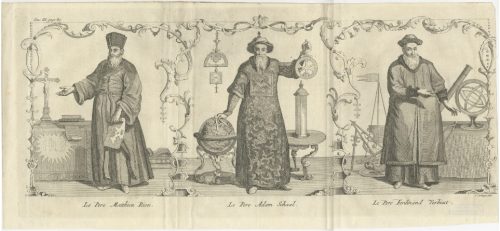
Three priests: Le Pere Matthieu Ricci, Le Pere Adam Schaal, and Le Pere Ferdinand Verbiest. Three priests with navigational instruments. Image taken from Description geographique, historique, chronologique et physique de l'Empire de la Chine et de la Tartarie Chinoise. Enrichies des cartes generales et particulieres de ces pays, etc. by Jean-Baptiste Du Halde (1674–1743), vol. 3, page 78. Originally published/produced in La Haye [The Hague], 1736. J.v.Solingen fecit
Jean-Baptiste Du Halde (Chinese: 杜赫德; 1 February 1674 – 18 August 1743) was a French Jesuit historian specializing in China. He did not travel to China, but collected seventeen Jesuit missionaries' reports and provided an encyclopedic survey of the history, culture and society of China and "Chinese Tartary," that is, Manchuria. Voltaire said of Du Halde's work: "Although it is developed out of Paris, and he hath not known the Chinese, [he] gave on the basis of the memoirs of his colleagues, the widest and the best description the empire of China has had worldwide." Le Pere Matthieu Ricci, a.k.a. Matteo Ricci, S.J. (Italian pronunciation: [matˈtɛːo ˈrittʃi]; Latin: Mattheus Riccius Maceratensis; 6 October 1552 – 11 May 1610), was an Italian Jesuit priest and one of the founding figures of the Jesuit China missions. His 1602 map of the world in Chinese characters introduced the findings of European exploration to East Asia. He is considered a Servant of God by the Roman Catholic Church. Ricci arrived at the Portuguese settlement of Macau in 1582 where he began his missionary work in China. He became the first European to enter the Forbidden City of Beijing in 1601 when invited by the Wanli Emperor, who sought his services in matters such as court astronomy and calendrical science. He converted several prominent Chinese officials to Catholicism, such as Xu Guangqi, who aided in translating Euclid's Elements into Chinese as well as the Confucian classics into Latin for the first time. Le Pere Adam Schaal, a.k.a. Johann Adam Schall von Bell (1 May 1591 – 15 August 1666) was a German Jesuit and astronomer. He spent most of his life as a missionary in China (where he is remembered as "Tang Ruowang") and became an adviser to the Shunzhi Emperor of the Qing dynasty. Le Pere Ferdinand Verbiest, a.k.a. Father Ferdinand Verbiest (9 October 1623 – 28 January 1688) was a Flemish Jesuit missionary in China during the Qing dynasty. He was born in Pittem near Tielt in the County of Flanders (now part of Belgium). He is known as Nan Huairen (南懷仁) in Chinese. He was an accomplished mathematician and astronomer and proved to the court of the Kangxi Emperor that European astronomy was more accurate than Chinese astronomy. He then corrected the Chinese calendar and was later asked to rebuild and re-equip the Beijing Ancient Observatory, being given the role of Head of the Mathematical Board and Director of the Observatory. He became close friends with the Kangxi Emperor, who frequently requested his teaching, in geometry, philosophy and music. Verbiest worked as a diplomat and cartographer, and also as a translator because he spoke Latin, German, Dutch, Spanish, Hebrew, and Italian. He wrote more than thirty books. During the 1670s, Verbiest designed what some claim to be the first ever self-propelled vehicle – many claims this as the world's first automobile, in spite of its small size and the lack of evidence that it was actually built.Joshua Van Solingen was an engraver and publisher from Holland, working, besides other places, in Scotland. Information about him can be found at Catastrophic Bliss (The Griot Project Book Series) by Accounting in Scotland (RLE Accounting): A Historical Bibliography History of the Scottish Metrical Psalms: With an Account of the Paraphrases ... The History of Edinburgh, from the Earliest Accounts to the Present Time ... History of the Bassandyne Bible, the First Printed in Scotland: With Notices ...
-
 Untrimmed fan print (uchiwa-e), 231 x 300 mm. Title: A geisha eating edamame aboard the boat of the Atari-ya teahouse. Series: Three summer women [九夏三婦久] (Kyūka sanfuku). Artist: Utagawa Kunisada [歌川 国貞] a.k.a. Utagawa Toyokuni III [三代歌川豊国] (Japanese, 1786 – 1865). Artist: Utagawa Kunihisa II [歌川国久] a.k.a. Katsuda Hisatarō, Ichiunsai, Ritchōrō, Toyonobu, Yōryūsai, Yōsai] (Japanese, 1832 – 1981). Block cutter: Yokokawa Horitake [横川彫武] a.k.a. Yokokawa Takejiro [横川竹二郎] (Japanese, fl. 1860s). Publisher: Ibaya Senzaburō [伊場屋仙三郎] (Japanese, fl. C. 1845 – 1847) Combined date seal and kiwame censor seal: 1860 (Ansei 7 / Man'en 1 from 18/III). Signed: Toyokuni ga in toshidama cartouche, and Kunihisa ga. Provenance: The Collection of Paul F. Walter, Christie's, New York, 2017, lot 341; sol together with 5 other fan prints for $25,000. Before: Israel Goldman, Japanese Prints, Catalogue 9, 2003, no. 35. Ref: [LIB-1693.2018] The Collection of Paul Walter. — NY: Christie's, 2017, p. 363. Ref: Israel Goldman, Catalogue 2018, № 52: "Utagawa Kunisada (1786-1865) and Utagawa Kunihisa II (1832-1891) A Geisha Eating Edamame Aboard the Boat of the Atari-ya Teahouse. From the series Kyuka sanfuku (Three Summer Women). 1860. Fan print. 22.7 x 29.6 cm. Provenance: Israel Goldman, Japanese Prints, Catalogue 9, 2003, no. 35. The Collection of Paul F. Walter, Christies, New York, 201, lot 341. Fine impression, colour and condition. The title is a pun on “kyuka sanpuku” meaning the hottest point of the summer. The background view is by Kunisada’s pupil Kunihisa."
Untrimmed fan print (uchiwa-e), 231 x 300 mm. Title: A geisha eating edamame aboard the boat of the Atari-ya teahouse. Series: Three summer women [九夏三婦久] (Kyūka sanfuku). Artist: Utagawa Kunisada [歌川 国貞] a.k.a. Utagawa Toyokuni III [三代歌川豊国] (Japanese, 1786 – 1865). Artist: Utagawa Kunihisa II [歌川国久] a.k.a. Katsuda Hisatarō, Ichiunsai, Ritchōrō, Toyonobu, Yōryūsai, Yōsai] (Japanese, 1832 – 1981). Block cutter: Yokokawa Horitake [横川彫武] a.k.a. Yokokawa Takejiro [横川竹二郎] (Japanese, fl. 1860s). Publisher: Ibaya Senzaburō [伊場屋仙三郎] (Japanese, fl. C. 1845 – 1847) Combined date seal and kiwame censor seal: 1860 (Ansei 7 / Man'en 1 from 18/III). Signed: Toyokuni ga in toshidama cartouche, and Kunihisa ga. Provenance: The Collection of Paul F. Walter, Christie's, New York, 2017, lot 341; sol together with 5 other fan prints for $25,000. Before: Israel Goldman, Japanese Prints, Catalogue 9, 2003, no. 35. Ref: [LIB-1693.2018] The Collection of Paul Walter. — NY: Christie's, 2017, p. 363. Ref: Israel Goldman, Catalogue 2018, № 52: "Utagawa Kunisada (1786-1865) and Utagawa Kunihisa II (1832-1891) A Geisha Eating Edamame Aboard the Boat of the Atari-ya Teahouse. From the series Kyuka sanfuku (Three Summer Women). 1860. Fan print. 22.7 x 29.6 cm. Provenance: Israel Goldman, Japanese Prints, Catalogue 9, 2003, no. 35. The Collection of Paul F. Walter, Christies, New York, 201, lot 341. Fine impression, colour and condition. The title is a pun on “kyuka sanpuku” meaning the hottest point of the summer. The background view is by Kunisada’s pupil Kunihisa." -
 Utagawa Toyokuni I (歌川豐國); 1769 – 24 February 1825. Kabuki actor Onoe Matsusuke I (other stage names: Onoe Shôroku I and Onoe Tokuzô) lived from 1744 (born in Edo, present Tokyo) until the 16th day of the 10th lunar month of 1815 (died in Edo). Here he plays the honourable villain, the powerful minister of state Kudō Saemon Suketsune. Kabuki actor Bandô Hikosaburô III (other stage names: Ichimura Kichigorô I, other names: Hansôan Rakuzen, Bandô Shinsui III, and Rakuzenbô) lived from 1754 (born in Edo, present Tokyo) until 18th day of the 2nd lunar month of 1828. "1813 ~ 1828: Hikosaburô retires and takes the tonsure in a Temple located in Kurodani (Kyôto). He goes back to Edo and lives a hermit life in a small hut called Hansôan and located in Mukôjima." Here he plays Soga no Gorō Tokimune, the younger of two Soga brothers. It was an Edo period custom to produce every New Year's a play in which the Soga brothers figured. The Sogas were actual historical figures who, in 1193, avenged their father's murder by staging a daring night raid on their enemy during a grand hunt. The villain, a powerful minister of state named Kudō Saemon Suketsune, had orchestrated the murder of their father seventeen years earlier. The exact play, theater, and year featured on the print are not currently known. Publisher: AM-23-016 |391q: Nishimuraya Yohachi: Eiju han 1780s-1809 [AM: Andreas Marks. Publishers of Japanese woodblock prints: A compendium. Hotei Publishing, Leiden-Boston, 2011]. References:
Utagawa Toyokuni I (歌川豐國); 1769 – 24 February 1825. Kabuki actor Onoe Matsusuke I (other stage names: Onoe Shôroku I and Onoe Tokuzô) lived from 1744 (born in Edo, present Tokyo) until the 16th day of the 10th lunar month of 1815 (died in Edo). Here he plays the honourable villain, the powerful minister of state Kudō Saemon Suketsune. Kabuki actor Bandô Hikosaburô III (other stage names: Ichimura Kichigorô I, other names: Hansôan Rakuzen, Bandô Shinsui III, and Rakuzenbô) lived from 1754 (born in Edo, present Tokyo) until 18th day of the 2nd lunar month of 1828. "1813 ~ 1828: Hikosaburô retires and takes the tonsure in a Temple located in Kurodani (Kyôto). He goes back to Edo and lives a hermit life in a small hut called Hansôan and located in Mukôjima." Here he plays Soga no Gorō Tokimune, the younger of two Soga brothers. It was an Edo period custom to produce every New Year's a play in which the Soga brothers figured. The Sogas were actual historical figures who, in 1193, avenged their father's murder by staging a daring night raid on their enemy during a grand hunt. The villain, a powerful minister of state named Kudō Saemon Suketsune, had orchestrated the murder of their father seventeen years earlier. The exact play, theater, and year featured on the print are not currently known. Publisher: AM-23-016 |391q: Nishimuraya Yohachi: Eiju han 1780s-1809 [AM: Andreas Marks. Publishers of Japanese woodblock prints: A compendium. Hotei Publishing, Leiden-Boston, 2011]. References:- Kabuki Plays on Stage: Brilliance and Bravado, 1697-1766 (Kabuki Plays on Stage, Volume 1). Brandon, James R., Leiter, Samuel L. University of Hawai'I Press, Honolulu, 2002.
- Kabuki Encyclopedia. An English-Langauge Adaptation of Kabuki Jiten. Samuel L. Leiter. Greenwood Press, 1979.
- https://www.kabuki21.com/
-
 Le Petit Chaperon rouge (Little Red Riding Hood), three wood engravings by Gustave Doré, 1864: "En passant dans un bois elle rencontra compère le Loup"; "Le Chaperon rouge fut bien étonné de voir comment sa grand'mère était faite en son déshabillé"; "Cela n'empêche pas qu'avec ses gran dents il avait mangé une bonne grand'mère". Engraved by Adolphe Pannemaker. Le Petit Poucet (Little Thumb), one wood engraving by Gustave Doré, 1864: "Une bonne femme vint leur ouvrir". Engraved by Héliodore-Joseph Pisan. La Belle au bois dormant (Sleeping Beauty), one wood engraving by Gustave Doré, 1864: "Il marcha vers le château qu'il voyait au bout d'une grande avenue où il entra". Engraved by Héliodore-Joseph Pisan. Medium: Paper; Wood engraving. Illustrations for P.-J. Hetzel's edition of Perrault's Fairy Tales (Les Contes de Perrault) by Gustave Doré published in 1864. Size: frame: 428 x 302 mm; sheet: 280 x 231 mm; image: 194 x 244 mm.
Le Petit Chaperon rouge (Little Red Riding Hood), three wood engravings by Gustave Doré, 1864: "En passant dans un bois elle rencontra compère le Loup"; "Le Chaperon rouge fut bien étonné de voir comment sa grand'mère était faite en son déshabillé"; "Cela n'empêche pas qu'avec ses gran dents il avait mangé une bonne grand'mère". Engraved by Adolphe Pannemaker. Le Petit Poucet (Little Thumb), one wood engraving by Gustave Doré, 1864: "Une bonne femme vint leur ouvrir". Engraved by Héliodore-Joseph Pisan. La Belle au bois dormant (Sleeping Beauty), one wood engraving by Gustave Doré, 1864: "Il marcha vers le château qu'il voyait au bout d'une grande avenue où il entra". Engraved by Héliodore-Joseph Pisan. Medium: Paper; Wood engraving. Illustrations for P.-J. Hetzel's edition of Perrault's Fairy Tales (Les Contes de Perrault) by Gustave Doré published in 1864. Size: frame: 428 x 302 mm; sheet: 280 x 231 mm; image: 194 x 244 mm. -
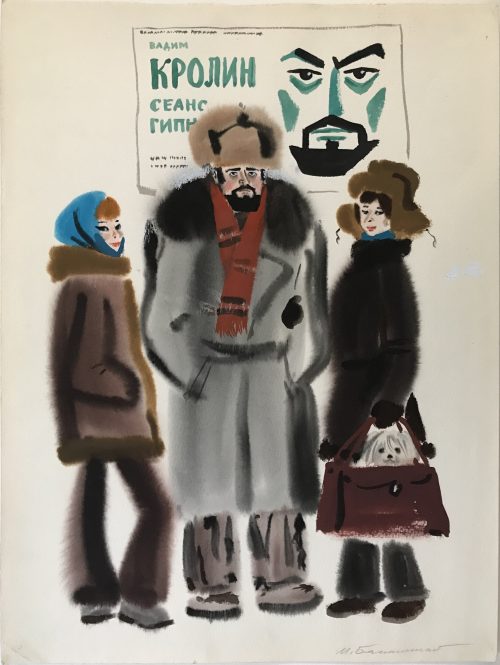 Mikhail Belomlinsky. Born 1934, Russia. Vadim Krolin, hypnosis session. Watercolor painting on paper from Chukotka expedition, ca. 1970s. Size: 36 x 48 cm.
Mikhail Belomlinsky. Born 1934, Russia. Vadim Krolin, hypnosis session. Watercolor painting on paper from Chukotka expedition, ca. 1970s. Size: 36 x 48 cm.




